Our travel stories | Your travel clues
- Eastern India
- Western India
- North India
- North East India
- South India
- Central India
- Travel Plans
- Unique Experiences
- Budget Travel
- Thinking Aloud
- Sustainable Tourism
- Privacy Policy

Dzukou Valley Trek in Nagaland : A complete guide
I just can’t wait to share this amazing experience. Four days in Nagaland, and especially the Dzukou Valley trek fills my heart with a sense of fulfillment that I experience only once in a while. Dzukou Valley was in my mind when I planned this north-east trip, but I was not quite sure if I could actually make it alone. My google search on how to do this trek resulted in minimal information. Still I tried to join all the dots together and prepare myself mentally to endure the fear of the unknown. Though in recent times, Dzukou Valley is getting popular among travellers, there is not much proper guidance on the trek available online. In order to fill this void, here is this article: Dzukou Valley trek in Nagaland : A complete guide.

Reminiscence of the past year:
While trekking through the Dzukou Valley, I did miss my Triund peak trek almost one year ago, especially because I did it with Parina, and some close friends. I feel treks are more enjoyable in a group rather than alone. And in a group, it’s safer as well. But doing it alone definitely was more adventurous, and satisfying.
Dzukou Valley at the heart of Nagaland
Geography and location:.
Sitting in the foothills of eastern Himalayas in the state of Nagaland, Dzukou valley is the crown jewel of north east India. Standing at ~8000 ft (2438 mts), Dzukou valley is s ituated beside the Japfu peak on the border between Nagaland and Manipur. However, being close to Kohima, the state capital of Nagaland, more tourists trek the valley from Nagaland side rather than Manipur side.
Dzukou Valley is an absolute delight, a treat to the eyes and soul. Its rolling hills, emerald green gentle slopes, and evergreen forests made me remember Coorg and Ooty in south India . For a good part of the year, the valley fills with the famous Dzukou lilies and a large number of other varieties of orchids. This prompts people to call it the Valley of flowers of north east India.

Growing popularity in recent times:
Hornbill festival:.
A festival of festivals that brings together all the various ethnic groups of Nagaland on one platform, Hornbill festival showcases the cultural richness of Nagaland. Started in the year 2000 by the government of Nagaland, it’s held between 1-10 December every year at Kisama village, 16 kms away from Kohima.
The festival celebrates everything that is great about Naga culture- its traditional food, dance, sports, crafts, etc. If one wants to know Nagaland up-close, no need to see any further. It has established itself as one of India’s go-to festivals. I hope to make it to the festival this time in December.
My Dzukou Valley Trek Schedule
After spending 3 days in Manipur enjoying the festival of colours- Holi there, and experiencing their unique culture, I headed for Nagaland. I had planned for 4 days in Nagaland. Though Dzukou Valley was in my scheme of things, I wasn’t sure if I could pull this trek off alone. So, the schedule, to start with, was flexible. But after talking to a few locals around on the first day itself, I convinced myself that I should at least give it a try. So, the schedule became like this:
- Arrival; Day-1: Reach Dimapur from Imphal; explore Dimapur a bit, and move to Kohima; explore local Kohima in the evening
- Day-2: Visit a few places in Kohima, and trek to the Dzukou Valley
- Day-3: Trek back from Dzukou Valley to Kohima; explore local markets in the evening
- Departure; Day-4: From Kohima to Dimapur; Dimapur to Guwahati, and onward to Delhi
Day-1: Imphal- Dimapur- Kohima
The flight from Imphal got delayed a bit, and I landed at Dimapur airport at around 1 PM. Nobody asked me to check my Inner Line Permit (ILP) to enter Nagaland (though I had it). I had earmarked a few spots in Dimapur to pay a quick visit. But after talking to a few locals at the airport, I decided to visit only the (Dimasa) Kachari Rajbari ruins.
Kachari Rajbari Ruins
Around 10th century AD, there was a Kachari civilization around Dimapur of which little history exists. However, the mushroom shaped domed pillars (8-10 ft each) and the gateway still stand testimony to a glorious past. An English lieutenant- Grange discovered it in 1840, and brought it to public knowledge.
I looked at them in bewilderment, and imagined that whoever built these things in that era, must be of superior creativity and imagination. However, the purpose of the structures are still mysterious. It’s a small green campus; takes only about 15-20 minutes to walk around.

Driving up the hills to Kohima:
The auto rickshaw driver became an instant friend; I don’t know what clicked with him. He helped me find the right shared taxi near Dimapur railway station. In the taxi, I met Somnath, a Marketing Manager (from West Bengal) of a mobile accessories company who was travelling for work.
The shared taxi dropped us at Kohima ISBT, only 2-3 kms away from the city around 5 PM (drive time: 2 hrs). It was weird! They have this rule that taxis of one region in Nagaland are not allowed to ply in another region! (If you have any idea about why is it so, please let me know in the comments section). So, we had to take another shared taxi from the ISBT to the main city.
First view of Kohima:
Aesong, a fellow traveller from Kohima suggested us a nice hotel (East Gate hotel) near the Kohima war memorial. Somnath suggested that we should share a room to save some money, and I saw no reason not to agree. It’s always good to meet new people while travelling. It gives new perspectives of places, people and their culture.
While reaching the city, I couldn’t catch a good view of the city, but from the balcony, night view of Kohima was quite amazing, similar to that of Shimla and Gangtok.

Day-2: Kohima- Dzukou Valley
I decided to visit the Kohima War Cemetery and the Kohima Cathedral Church before proceeding towards Dzukou Valley trek. The hotel I was staying was at a walkable distance from the War Cemetery, which wouldn’t take more than 30 minutes to explore. And the Cathedral was near the Network Travels AOC bus stand from where I was supposed to board a shared taxi to Viswema, the starting point of the trek. So, it was also doable.
Kohima War Cemetery
In March 1944, at the height of World War-II, if the Allied/ Commonwealth armed forces hadn’t fought valiantly in Kohima and Imphal, parts of India would have fallen to Japan. However, the small contingent held their ground suffering heavy casualties, and succeeded in forcing the Japanese forces to retreat. Britain regards this battle so highly that British National Army Museum has voted the battle of Imphal and Kohima as the greatest in their history.
The Commonwealth War Graves Commission established and manages this cemetery meant to pay homage to the brave 2337 brave soldiers who laid down their lives for freedom.

Back to hotel and off to the trek:
The lady at the reception helped me with a taxi with a friendly driver. He took me to the cathedral first, and then dropped me at the Network Travels AOC bus stop.
Kohima Cathedral Church
Christianity is the predominant religion in Nagaland; as much as 88% of population are Christians. Of this 88%, 75% are Baptists, and 13% are Catholics and other denominations. This makes Nagaland the most Baptist state in the whole world!
The evening I reached Kohima, standing in the balcony of my hotel room, I could see all the cross signs in neon red light over the churches dazzling in the night skyline across the hill slopes of Kohima. However, the most recognizable landmark church in all of Kohima is a catholic church- Mary Help of Christians Cathedral, or more popular as Kohima Cathedral Church. Built in typical Naga architecture, it was consecrated in 1991.

When I reached the cathedral, it was closed for renovation. So, I walked around the church, and took some pictures of the impressive building. Besides, it offers a splendid view of Kohima city from its backside.

Viswema village: Onward to Dzukou Valley
The shared taxi from Kohima to Viswema took 30 minutes to fill enough passengers (7 of them) to start. So, at last, I was on my way to the Dzukou valley at around 9:30 AM. It took about 45 minutes to cover the distance of 24 kms to Viswema. Though the road was mostly good, some patches were bad and dusty.
Viswema is larger than a village, but not big enough for a town. I had my breakfast (puri- sabzi) in a small eatery, and packed some chocolates, eggs, peanuts, biscuits and water for the trek.
Approach to the Dzukou Valley Trek
There are basically two approaches to the Dzukou valley trek; one via Zakhama village, the other via Viswema village. Both the routes end at the same guesthouse for overnight stay. Beyond that point, there is the open valley that one may choose to hike and explore the next day.
Let me explain each of these approaches for convenience of a first timer.
Approach-1: Zakhama village
- Reach Zakhama, ~14 kms away from Kohima by shared taxi: 30 minutes
- Motorable road of 2-3 kms to the trek starting point (may hike or take a taxi; optional): 1 hr
- Difficult section of 5-6 kms with steep slopes (30 to 60 degrees): 4-5 hrs
- 1.5 kms of plateau; easy hiking/ walking: 30 minutes
- Total trekking time (excluding motorable road): ~6 hrs to reach the end point of the trek where there is a small guesthouse to spend the night.
Approach-2: Viswema village
Some of the trekkers begin trekking from Viswema village itself. But majority of trekkers actually go a little far by a taxi or truck to a point where there is no motorable road, and start trekking from there.
- Reach Viswema, ~23 kms away from Kohima by shared taxi: 45 minutes
- Motorable road of 8-9 kms to the trek starting point (may hike or take a taxi; optional): 4 hrs walk
- Difficult section of 1.5 kms with steep slopes (30 to 60 degrees): 1.5 hrs
- The beautiful view of the Dzukou valley starts at the end of this difficult section
- Then cross 4-5 kms of plateau of easy hiking/ walking: 2 hrs
- Total trekking time (excluding motorable road): 3.5 hrs to reach the guesthouse.
My recommendation:
Viswema route is definitely better of the two approaches, unless one is especially fond of trekking in difficult terrain. It takes less time than the Zakhama route. But more importantly, the last plateau section of 4-5 kms actually runs among the hills through the Dzukou Valley, and is a hike with gorgeous sight.
The only problem is that the motorable road till the starting point of the trek is too long to walk; so, one has to take a taxi. The taxi costs Rs.1500/ one way, which is a bit too much if you are alone. To solve this problem, either you go in a group, or wait at Viswema village for a group who you can join. If you don’t find a taxi, just wait for a while, or ask the nearby shopkeepers.
There is an approach from Manipur side, from the Senapati district (Isii mount). However, I have not been from that side; so, not much idea.
The ascent: Winning over the fear of unknown

As I was alone, I had to hire a small truck myself (for Rs.1500) to reach the starting point of the trek. On the way, there was an entry point to the Dzukou valley where I had to pay a nominal fee.
The entire route was extremely bumpy; actually the worst road one can imagine. I was sitting on the front cabin of the truck; but my head banged against the roof several times, and my back was hurting like hell!
The trek begins:
It was around 11.45 AM, my ordeal was over, and I started my trek up the hill inside the forest . I knew that the difficult section was only 1.5 kms, but I wasn’t sure of how much time the whole trek would take to reach the guesthouse.
However, the bigger question (say fear) was that whether I would be able to find my way through the forest to the end point alone. If I wouldn’t be able to complete the trek during daylight, it would mean spending the night in the jungle! A truly horrifying prospect.
The steep slope:
In the beginning of the trek, the slope was gentle; but just for the first 10-15 minutes. Thereafter, the slope increased suddenly and drastically. At some points, the slope was more than 50 degrees. For a little more than 1 km, I kept hiking the steep slope with some difficulty. The two water bottles I carried, were helpful.
First view of Dzukou valley:
It took me an hour and fifteen minutes to cross the difficult section, where there was a small rest shed (reached there by 1 PM). That vantage point offers a panoramic view of the whole mountain range that I had been trekking. I took a longish rest there and started walking again lest I might not reach the guesthouse before evening. (Note: After this point, take the road to the right, not the left one).
And just when I turned around to the other side, voila! There in front of me was the open expanse of the gorgeous Dzukou Valley! Wow! What a sight that was! Extraordinarily beautiful rolling hills running into each other to form a V-shaped valley. Verdant grass land on the surface of the mountains. The dominating flora included (among other trees) Rhododendrons and Bamboo shrubs. My favorite Rhododendron flowers had just started blooming, but I was just about 15 days too early.

Losing way briefly:
While I was trekking in the difficult section, I kept coming across trekkers who were on their way back. But beyond the rest shed, I suddenly stopped seeing anyone for the next 4-5 kms till the guesthouse! I was all alone, and very apprehensive that I might miss a turn, and go in a completely wrong route to get lost in the open valley.
This was going on in my mind when I actually came to a dead end near a dry water stream at the intersection of two hills (picture below). I felt a chill run down my spine. Did I just lose my way? Yes, but fortunately, by just a hundred meters. So, I walked back and guessed the right route again, and kept hiking. I was just hoping to see someone from the other side; but there was none to be seen!

All alone, but the nature as company
I was all alone, but had the nature as company. I kept the faith, and kept walking among the bamboo shrubs. After about another two kilometers, I had the first view of the guesthouse over a far away hill. This soothed my nerves a bit, but I was still not 100% confident. Because I wasn’t sure whether the road actually connected to that hill.
Winning over my inner fears:
The valley was so beautiful it felt very friendly. Attending to my inner fears, I continued talking to the bamboo shrubs and the rolling hills. I felt like taking a picture at every turn. At one point, the view of large number of dead (burnt) black trees over a hill was so fascinating!
As I kept walking, the guesthouse got hidden from my sight at times, and again came back into the view. Maybe when I was some 500 meters away, I felt confident that I was on the right path. It was such a relief! At last, I reached the guesthouse by 3:15 PM.
But why was I all alone?

Watching the sunset over Dzukou Valley
After checking in at the guesthouse, I immediately ordered some maggie (the only thing that they have) to satisfy my hunger. I had it with the eggs that I carried from Viswema. Once I regained my strength, I decided to trek again across to another hilltop where there was a helipad for some reason. That proved to be a great decision. From the guesthouse side, it was difficult to get any good pictures of the valley below the setting sun. However, from the helipad side, the hills behind the guesthouse looked stunningly beautiful.
Surreal view!
Lush green, rounded as if a fine landscape architect had curated the valley like a garden. Sunset is the golden hour for photography; and it didn’t disappoint at all. The sun setting behind the valley in the west, and the hills on the opposite side in the east, both looked pristine.
I sat there speechless marveling the glory of nature. Didn’t really had the urge to move from there. But I had to reach the guesthouse before it was dark. Needless to say that there was no electricity up there.

Spending the night in Dzukou Valley
The guest house:.
It was a very basic guesthouse; to be honest, not a guesthouse actually. It was basically four walls and a roof with a floor beneath. That’s it! A dormitory without a bed! They offered a thin sheet to sleep on (for Rs.50), and a blanket (for Rs.250). There were a few private rooms as well, available on first-come-first-serve basis. They had small tents on offer too. Though there were a few toilets, they were not clean. They had kept some unclean drums near a stream in which they filled stream water for drinking purpose.

A sleepless cold night:
Expectedly, it was pitch dark up there. Chatting with fellow trekkers helped pass time though. Dinner (rice-dal-potato fry) was ready by 7:30 PM, and it was not bad. After dinner, it was time for more chatting. One Bengali trekker couple showed us videos from their trekking in Meghalaya. And two siblings from Italy- Flora and Vasco shared their experience of traveling across the globe.
When it was time to sleep, the noise made by a group of young guys at the bonfire outside made things difficult. However, the main problem was the cold. I realized late in the night that one blanket was not enough. But it was too late by then. I couldn’t sleep properly due to the cold (temperature must be in single digit). Vasco later told me that there were rats moving over his body!
Made some new friends:
I met Flora and Vasco just when I reached the guesthouse late in the afternoon, and instantly made a connect. There are certain people who you like the moment you speak to them. Vasco is an art restorer, and Flora, a film maker. They are travellers based out of Corsica in France, a beautiful place itself. But they are originally from Tuscany region in Italy, my favorite part of Italy. (I still cannot forget my experience of Florence ) . They have been long time travellers; I was quite amazed that Flora has already travelled all the continents!
I found Vasco and Flora to be very modern, liberal and humble people. Travel makes people more inclusive and liberal. During the time that we spent that evening, and the next day, I certainly felt friends with them.

Day-3: Dzukou Valley to Kohima
The descent:.
Morning view of the Dzukou valley from the guesthouse was far better. Took some more pictures, walked around the hill, and was mentally ready to say buy to Dzukou Valley. Some people went down the hill deep into the valley to explore a bit more, especially till a point where a white cross is seen from the top.
Descents are generally not that exciting as ascents. But having a young group of trekkers from IIT Guwahati, Flora and Vasco for company made the descent enjoyable. We all started together around 8:30 AM. Football dominated the discussions on the way back, especially because the young ones were footballers. We took a longish pit stop at the rest shed just at the beginning of the steep section. However, of course, while descending it was not so difficult; just being careful was enough.
Reaching Kohima:
I, Vasco and Flora joined the young group in their taxi to Kohima. We had lunch at a modest restaurant in Kohima, and went to the lodge (Morung) where they were putting up. I found it really nice, and booked a room for the night while they proceeded to Dimapur and to Arunachal from there.

Morung Lodge, a lovely homestay
I am glad that I got to live in the most popular lodge in Kohima. While visiting Kohima I had not done any research on accommodation options. But later when I watched some videos on YouTube, I found Morung Lodge everywhere! Turns out that it’s on the Lonely Planet as well.
Aesthetics:
The rooms were comfortable, and everything in the house was curated aesthetically with passion. The view of Kohima city ( with colourful houses stacked up on hill slopes ) from the lodge was amazing. In fact, it was interesting to note that the city is spread out in such a way that one can have the view of the city from anywhere.
For some reason, the caretaker of the lodge was not available for the evening, but Khriebu ensured that I had a good dinner at her restaurant- Morung Kitchen, again very neatly curated. As there was no other guest there for the night, I had the whole lodge to myself. I felt like I had a home in Kohima!
Morung, the social institution:
‘ Morung ‘ in Nagaland represents a key social institution, a center of cultural gathering, especially for men. Once upon a time, it used to be a center Naga elders taught their youth about their dialect, crafts, life skills, folk music and songs, etc. However, this institution has fallen into oblivion over time. To know more, click here .
The name perhaps has been chosen figuratively than anything else, because the lodge is open to women as much as men. In fact, it was started by a woman entrepreneur, and now run by another.

Khriebu, the dynamic entrepreneur:
I met Khriebu, the young dynamic entrepreneur managing the property. She is a sweet lady and a thorough professional. Her father was a Nagaland Civil Servant-promoted-IAS, mother a government servant, sister a reputed designer in Delhi. She used to live in Delhi for a long time. But went back to her roots some time back, and now running this lodge, and a restaurant quite successfully. Follow her on her Instagram page: @khriebu
For booking, write to them at: [email protected].

Kohima local market
After taking some rest in the afternoon, I went out to have a walk around the local market. It was fascinating to see street vendors selling unusual (for me) vegetable varieties like bitter bean, chayote (a type of squash) and snails, frogs and insects. I also found a large number of sellers from Bihar, not only street vendors, but also having other retail stores.
Unlike rest of India, but like in other states of north east India, it was a pleasant sight to see women dominate the market places. Both as sellers and buyers. Why is it so? Is it more because of socio-cultural reasons or because they are more educated? Any idea? Do share, if you know.

Day-4: Kohima- Dimapur- Guwahati- Delhi
When I told Khriebu that I was travelling to Dimapur airport next morning, she said that she was also travelling there, and offered me a seat in her car. Next morning, she along with her nephew and mother arrived around 9 AM and we were off to Dimapur. She and her mom were travelling to Guwahati for some family get-together, and her cousin was coming to drop them off. It was nice to meet her family; very sweet people.
On the way, at Pherima, they stopped for lunch and I had some tea. We reached Dimapur airport by 11.15 AM. We were travelling to Guwahati by the same flight. The shortest flight I had ever had- just 25 minutes! Within 15 minutes of the flight taking off from Dimapur, the pilot announced of landing!
Time to say bye!
I said bye to Khriebu and her mom at Guwahati airport to see them soon, maybe this year again with Parina, for the Hornbill festival in December. That was a formal bye to Nagaland, actually. Quite an amazing trip, an adventurous, exciting, and unforgettable one.

The flight from Guwahati to Delhi was not at all pleasant. Owing to traffic congestion at Delhi airport, the flight couldn’t land, and had to fly to Jaipur for refueling at midnight. By the time it landed again in Delhi, it was past 1 AM, after six hours of taking off from Guwahati!
Dzukou Valley Trek: Important Tips
Best time to visit:.
- For a pleasant enjoyable weather: March- May
- For flowers and greenest of green valley: Rhododendrons in April-May; Dzukou lilies in June- September
- However, monsoon months of June- Sep would be difficult to trek
- Winter months of November to February are not too bad too
How to reach Kohima:
Basically, one should reach Kohima a day before starting the Dzukou Valley trek.
- By flight: Nearest airport to Kohima is Dimapur, 70 kms away; from there take a shared taxi to Kohima
- By train: Again, the nearest railway station is Dimapur; take a shared taxi from there to reach Kohima
Where to stay:
There are limited options in budget category. Some options I know:
Morung lodge | East Gate hotel | Alder retreat | Circuit House | Akim homestays | Hotel Ariel | Native Stories (Zakhama)
How to approach the Dzukou valley trek:
Please see a special section on the approaches to Dzukou Valley trek above.
What/ where to eat (in Kohima):
- On the trek, there is only one option: the guesthouse up there. They have maggie for snacks, and basic rice- dal- potato for dinner. Carry some eggs, dry fruit, bread, etc, if you can.
- In Kohima: Amaris | D Cafe | Yaotsu’s pure veg | Jat restaurant | Cafe Aurora | Mhachaki | Morung Kitchen
- Though non-vegetarian food is more popular, one can find vegetarian restaurants easily
- Nagaland is a dry state (no alcohols)

Things to do in Kohima:
- Pay homage to the brave soldiers at Kohima War Cemetery
- Experience Naga culture at Kisama heritage village (enjoy Hornbill festival in December)
- Visit Kohima Cathedra Church for a spiritual experience
- Observe the local food preferences of Naga people at Kohima local market
- Day trip to Khonoma village, or/and Dzuleke village (on the same route)
Some helpful tips for Dzukou Valley Trek:
- One needs Inner Line Permit to enter Nagaland; click here to check out their website
- Difficulty level: partly moderate, partly easy
- Start the trek as early as possible in the day
- It’s better to trek from Viswema village side
- Take a shared taxi from Viswema to the starting point of the trek
- Mobile network will be fine till Viswema; after that there is no network in the valley
- Keep enough water, dry snacks and first aid with you
- Wear comfortable shoes; high quality trekking shoes are not needed
- Having a torch for the night is important
- A cap, and sunscreen lotions are helpful, if you are sensitive to sunburn
- On reaching the guesthouse at the end of the trek, take two blankets for the night
Areas of improvement
Plastic pollution:.
Dzukou valley is a no-plastic zone since 2019. However, it’s sad that it’s far from the truth. There is no effort from anyone to keep the beautiful valley plastic free. Everywhere, literally everywhere there is plastic litters- from the forested trek to the green valley, even at the guesthouse.

The whole place (guesthouse area) was littered with plastic bottles, polythene bags and wrappers. One can expect them to impose some restrictions, or put up some posters for awareness of tourists about environment, at least.
A better guesthouse:
Nice guys that they are, the caretakers of the guesthouse are not trained enough. They don’t maintain anything! Neither basic hygiene, nor drinking water. It becomes cold at night; they can put up some beds and charge a bit more; nobody will complain, surely. While we were trying to sleep, these guys came in the dormitory, and started playing loud music on their phones! That was so insensitive!
It’s run by a local youth club. Though it’s understandable that maintaining logistics for the tourists at a high altitude is a difficult task, they could do a lot better, if they wanted. One doesn’t expect great food up there; food was okay, in any case. However, t he altitude and distance are not that difficult to have at least water bottles or some light snacks there.
Concluding Remarks

Wanting for more!
The four days spent in Nagaland has made me wanting for more. I explored a modern north Indian state capital, went on a solo trek to the Dzukou Valley, and came across some wonderful people. However, four days were never going to be enough for experiencing the Naga culture. I would love to come back this year itself in December during the Hornbill festival, and then will explore iconic Naga villages like Khonoma, Dzuleke and Mon. North Nagaland is also quite beautiful; would love to explore places like Wokha, Doyang river, Mokokchung, etc.
With growing popularity of the Hornbill festival, tourism is getting streamlined gradually. However, even now, there are lack of good budget accommodation options beyond Dimapur. At the same time, there is a need for maintaining a balance between tourism and commercialization. Too much tourism may not be good for the region’s environment.
Need for collaboration between government and civil society
With a bit of care and effort, Dzukou Valley trek can be so much more enjoyable. Even more important is the sustainable tourism. The plastic pollution can easily be controlled by a simple regulation, implemented strictly at the entry gate to the Dzukou Valley. Sustainable tourism can never be the last priority.
I think a collaboration between the government (Forest department and Tourism department) and local NGOs can go a long way in keeping the valley green and clean. The NGOs can help local youth come up with better facilities and better management of the guesthouse for a fee. Even better if one can come up with a community-led tourism model.
Have you been to the Dzukou Valley or Nagaland? Please share your experience with us.
24 Responses
Jayvanti Einjen
V.nice information for visit Dzukou valley and pics are very nice
stampedmoments
Thank you so much, as always 🙂
Amazing. Never seen such a detailed breakdown of the trip. This helps a lot. Thank you!
Thanks a lot Nirbhay, for reading and sharing your lovely feedback. Keep connected.
Soumen Chatterjee
It’s just a an amazing blog I must say. Though I have visited Nagaland quite a lot of time but only on official tour , but through your blog I understand there are lot of things that can be explored. 1st is the Dzukou Valley which I understand is an absolute delight, a treat to the eyes and soul. Its rolling hills, emerald green gentle slopes, and evergreen forest. For a good part of the year, the valley fills with the famous Dzukou lilies and a large number of other varieties of orchids. This prompts people to call it the Valley of flowers of north east India. Trecking must have been a great experience. Kohima war cremetory also just wonderful to know about. Kachari Rajbari Ruins , Kohima war cemetery and the kohima cathedral Church have a lot of information which I gained while reading it. Dzukou Valley! looked extraordinarily beautiful rolling hills running into each other to form a V-shaped valley. Verdant grass land on the surface of the mountains. The dominating flora included (among other trees) Rhododendrons and Bamboo shrubs. It’s just Waooo!!!. The sunrise and sunset must have been thrilling. Most importantly u made friends at the guest house which is really awesome to make friends during the trip. Next was Morung, the social institution: ‘Morung‘ in Nagaland represents a key social institution, a center of cultural gathering, especially for men. Once upon a time, it used to be a center Naga elders taught their youth about their dialect, crafts, life skills, folk music and songs, etc. I hope u loved the Naga food and it’s delicious I must say I had a lot of it and I loved their non veg dishes. Overall I loved the experience and reading the blog was just thrilling.
Yes, Soumen, it was indeed a unique and wonderful experience. Doing it alone made it even more exciting! Thanks for reading in detail; keep it up!
It was interesting to read. I couldn’t stop reading until the very end. The Dzukou valley, Kachari ruins, the war cemetery, all are amazing, The travel itself appears to be terrifying. But truly, trips like these will provide something extra that you will remember forever. Of course, the trips will provide new connections, good people, lovely and comfortable stays, and so on. I enjoy reading.
Hi Sajith! Indeed, it was a bit difficult trekking alone, but more exciting for the same reason! Nagaland, and entire north east is largely unexplored; so, one feels like really discovering places. Thanks for the feedback 🙂
Kelly | Poky Little Wanderer
Those hills are just so beautiful! What a lovely adventure to have, and it sounds like you found a lot of wonderful new friends to share it with despite going by yourself!
Yes, Kelly, gorgeous landscape, and lovely new friends! Great trip, indeed. Thanks a lot for your feedback. Let’s keep connected.
I’ve never heard of Dzukou Valley or Nagaland so your post was very informative. Sounds like an amazing experience and lots of great ideas for sustainable tourism.
Hey! Good to hear from you. Glad that you liked it. Thanks a lot.
Falguni Trivedi
So detailed and covered almost all the small things too… Too good… Thanks for sharing
That has been the effort. Glad that it seems useful to you. Thanks a lot for reading, and sharing your feedback.
Shrusti Mohanty
Definitely saving this one, Nagaland has been on my list for a while now. Thank you for such detailed information!
Hey Shrusti! Good to hear from you again. Glad that you liked. Thanks for connecting.
The picture with rolling hills lead me to read. The blog gives the thrills and chills of the adventure behind the beautiful picture.
Thanks a lot, Pinkoo for your lovely feedback. Yeah it’s a unique landscape and an amazing experience to have. Please keep connected for more.
Shishir Mondal
Thanks for sharing necessary information, I am planning to trek Dzukou valley by April ’24.
Hi Shishir! Glad that you found it useful. Have a great trip!
Sauvhik Paul
Thanks for the info, would u mind if u tell us the entire cost of the trip from Dimapur, like the hotel and stuff
Sure. Please write to us: [email protected]
Sarita Hevia Iphone
Incredible experience!!! Stunning views, amazing trekkings, fantastic culture Congratulations for your trip and thanks for share it
Yes, that’s true. It was such a wonderful experience! Cherished memories forever. Thanks for the feedback.
Leave a Reply Cancel reply
Your email address will not be published. Required fields are marked *
Save my name, email, and website in this browser for the next time I comment.
This site uses Akismet to reduce spam. Learn how your comment data is processed .

Dzukou Valley Trek
Nagaland • 7 days.
MAX ALTITUDE
₹ DIY + 5% GST
Dimapur to Dimapur
Available Batches
Brief description.
Translated from local language, Dzukou means cold water for the cold stream that runs through this charming valley. Known for its natural splendor, this valley of rolling hills is unlike any other you ever saw. Get this, this densely forested valley barely has any trees! Even so, the trail for this valley which straddles the border of Manipur and Nagaland is unbelievably green and full of colour from the many wildflowers on its green carpet of rolling hills. The valley is home to some rare and endangered species of fauna. One of which is the Dzukou Lily. The state bird of Nagaland, the Blyth tragopan, also frequents these hills along with other rare species like the Asian golden cat, the Hollock Gibbon, clouded leopard and the horned toad amongst countless other species of fauna that call these beautiful forests home. Very many rare species of rhododendrons do their bit in adding to the magic to this mystical valley. Declared as a plastic-free zone to protect its rich biodiversity from getting harmed, the trail also brings you to some of the smaller villages in the region. It takes you to a maximum altitude of 2,452M and gives you enough opportunities to brush shoulders with the locals of the area. It is a beginner’s level trek perfect for anyone who wants to explore some of the remotest regions of Nagaland. Stay on this page for more information on this trek.
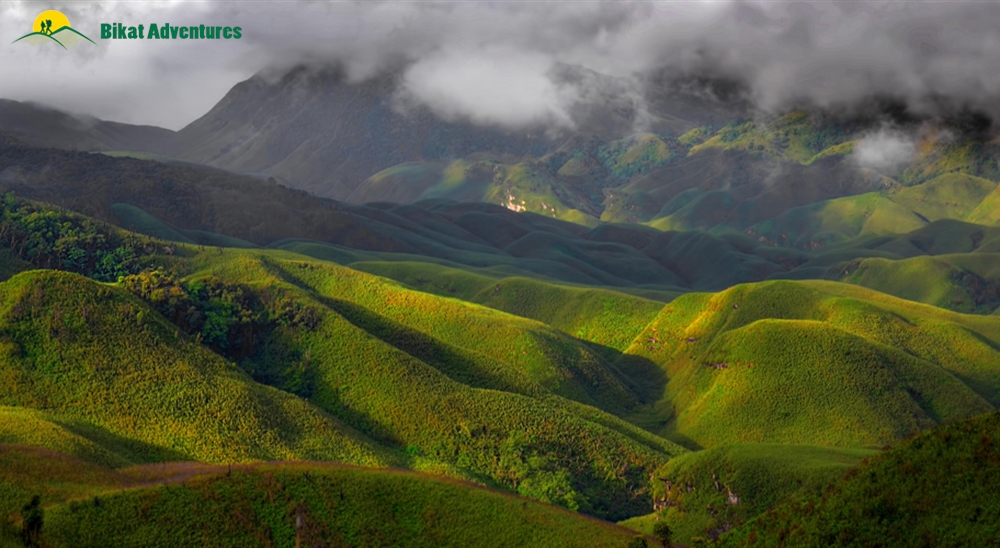
Arrive to Dimapur and head to Khonoma
The first day is reserved to make your way to Khonoma which is a small town 3 hours away from Dimapur. Dimapur has an airport from where you can get a ride to Khonoma.
(If you need help figuring out how to reach Dimapur, read this ).
If you wish to travel with us, we can arrange for a shared vehicle between Dimapur and Khonoma.
There’s nothing more on the agenda for today other than to get acquainted with the new place and to each other.
Khonoma to Seikhakie
Khonoma is the ‘first green village of the country’. We start off in the morning by exploring the village – the culture and the cuisine and the way the locals go about their usual business in this unusually beautiful place. The hospitality of the locals sure deserves a special mention as well. Post breakfast we start our trek to Seikhakie. There’s no rush since it is only about 4 kms from Khonoma. Today is a fairly easy walk to our campsite for the night.
Seikhakie to Dzukou
We leave for Dzukou post breakfast. It should take close to 4 hours to cover the distance of 6 kms to Dzokou so we have all the time to go as slowly as possible and observe all there is to soak in in the Khonoma Nature Conservation and Tragopan Sanctuary. It is not a biodiversity hot spot for no reason!
When you have reached a lush green landscape of rolling hills with veins of water spread in all directions, know that you have reached Dzokou Valley. This is where we camp at night.
Dzukou to Dzulekei
We start the day with no hurry. After breakfast we head out to a waterfall 3 kms away from the campsite. The waterfall is stationed in the Dzulekei village. Once we are here, we spend some time at the waterfall. We use the rest of the day to explore the village and talk to the locals. We spend tonight in the village.
Dzulekei to Dimapur
On this final day, we head out from Dzulekei and make our way to Dimapur. Expect to reach by mid-afternoon. You can get your flight out from Dimapur the same day.
Frequently Asked Questions
Pick your question, eligibility: fitness benchmark.
There is no requirement of extreme fitness training for this trek. If you have basic physical fitness and knowledge of trekking you must undertake this trek.
Eligibility: Requisite Skills
Basic mountain mannerisms. Basics of knowledge of mountain ascending and descending techniques. Basic knowledge about camping
Eligibility: Experience required
This trek can be done by beginners as well as experienced trekkers.
About the activity: Why should I go for this trek?
The Dzukou valley trek is one of the few treks which give you an opportunity to immerse yourself in the culture of Nagaland. This 5-day trek takes you into the lush green mountains which are blessed with enriching flora and fauna.
Best Season: What are the best months to visit this trek?
The best season to do this trek is the winter season. From the months of November to March.
Connectivity: How to Reach the base of the trek & how to go back from the end point?
By Air The only airport in the region is Dimapur Airport. You can take a flight from all major airports to this airport. By Road From the Dimapur airport, you can take a cab to the base camp village of Khonoma. It takes around 3 hours to reach the village.
Connectivity: What is the cellular network connectivity for this trek?
The cellular network is available in several patches of the trek.
Eligibility: Is this trek good for me?
Anyone who is new to the trekking and wants to venture into the experience should begin with this trek. It can be easily done by yourself with no prior trekking experience.
Since it is a beginner’s trek, you need no special prior experience. Although one is required to have mental preparedness and stamina before he begins the trek. Running exercise is recommended.
Dzukou valley trek
Best season:.
Best season to do the trek is in the winter season when the weather is pleasant. Summers are hot and monsoon attracts significant rainfall.
Packing List: What to pack
Carry a backpack with rain cover, good trekking shoes, water bottles, quick dry clothes, trekking pole (optional)
The base of the trek is the pretty village of Khonoma which is at a distance of 90km from Dimapur and can be easily reached by taxi.
Intermittent to lack of cellular network as you proceed further into the valley.
Nearby attraction: What are the nearby attractions that I can explore?
The nearby cities of Dimapur and Kohima are the popular attractions from Khonoman. The Nagaland zoological park close to Dimapur is a popular attraction.
Accommodation: What will be the accommodation type in this trek?
There are hotels present in the towns of Khonoma and Dzulekei. You can easily camp on the trekking days.
Weather conditions: What will the temperatures be like during this trek?
Days are hot and humid while the nights are pleasant. Monsoon receives a lot of rainfall.
Weather conditions: When will there be snow on this trek?
There will be no snow on this trek.
What's Included
Whats included, whats not included, cancellation policy, cash refund.
Cancellations up to 30 days prior to departure date 5% Deduction
Between 30 days to 15 days prior to departure 50% deduction
Less than 15 days of departure No Cash Refund
Voucher Refund
Cancellations up to 5 days prior to departure date No Deduction
Cancellations less than 5 days prior to departure No Refund
Please note
- Cash refund is applicable only in case of bookings made without using any promotional offer code or vouchers.
- This is only a brief of cancellation terms. For finer details please refer Detailed Cancellation Policy.
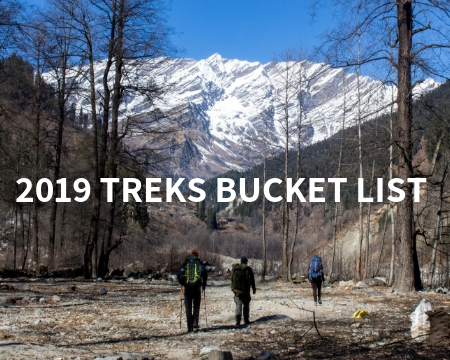
Bucket List Treks For 2019
Kiritika Jyotshi 09 January 2019
As travelers, we have constant urges to explore new places and expand the picture gallery of our phones with the bittersweet memories from our trips. Our love for the unseen places just keeps increasing and trust us, it becomes an addiction before
Informative

5 ALTERNATIVE TREKS TO DO IN 2019 INSTEAD OF ROOPKUND
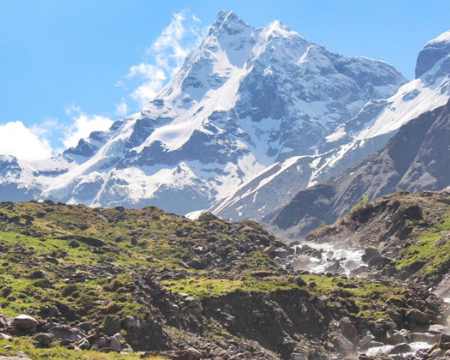
Best Himalayan Treks That You Can Go For This Summer
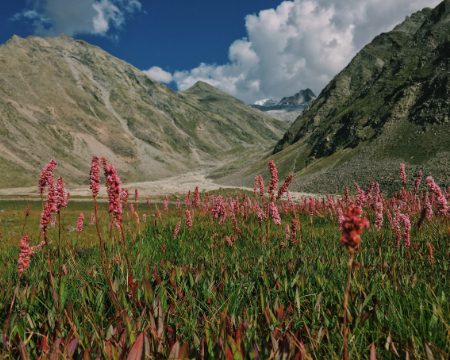
11 Best Offbeat Treks In India Nobody Knows About
Experiential, enter your email, certifications.

Events by Month
- January July
- February August
- March September
- April October
- May November
- June December
Events by Activity
- Popular Treks
- Aspirational Expeditions
Events by Grade
Events by duration.
- 5 & more Nights
Bikat Adventures
- Environment Policy
- Privacy Policy
- Terms & Conditions
- Work With Us
- Address: 303, 3rd Floor, Tower B4, Spaze Itech Park, Sector 49. Gurgaon
- Pre Sale - 8448680062 , Post Sale - 8588878499, 9667639126
- Cancellation & Refunds
- Content Sharing
We are Social
Payments we process, submit enquiry.
Dzukou Valley and Japfu Peak Trek
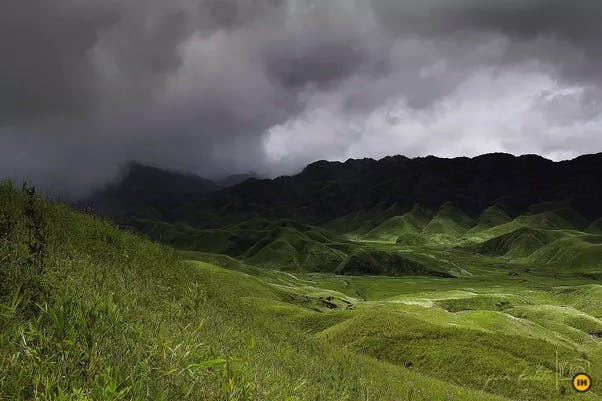
Can You Help Us With Photographs Of This Trek?
We are looking to enrich this documentation with more photos. Pictures go a long way in explaining the trail, more than words ever can. If you have done this trek, can you share your photos with us? We will include them on this page, with due credit to you. Click here to contribute .
The Complete Guide to the Dzukou Valley and Japfu Peak Trek
Known as one of the most charming valleys in all of Nagaland, Dzkou Valley is a spectacular visual treat of emerald green hills, lush forests, serpentine streams, and myriad colorful blooms that dot the vast caldera of the valley and its meadows. It is by far the best-known trekking route in Nagaland. After one has completed this unremittingly steep climb and subsequent 2-3 hours of walk through low bamboo scrub, one probably begins to understand why!
The topography indicates that the valley is the bottom of a large crater or caldera of a long extinct volcano, and one can look down upon it from the rim of the caldera. At ~2,400 meter, there is a special kind of beauty, almost desolate, especially in the long shadows of early morning or late afternoon.
Above the valley remains a huge mountain hut – almost like a shed! Behind the hut, there is a small cluster of oak and rhododendron forest. Beyond this, there are some steep hills – which really tempts one to climb for a better view. Half way up and any signs of tracks disappear and one is just left with fighting endless bamboo thickets.
No doubt that this valley presents a very good opportunity for young people, travelling independently, to gain some trekking experience.
➤ Highlights of the trek
- Trek in the midst of emerald green hills and pristine valleys
- Visit a valley that’s millions of years old and absolutely desolate
- Trek through deep forests and endless bamboo thickets
➤ Trail Information
Day 1: reach kohima.
Kohima, situated around 80 km from Dimapur, is the base to begin the Dzukou valley trek. Dimapur is the only city in Nagaland that has rail and air connectivity to other cities in the country. Private/shared cabs and bus are easily available from Dimapur to Kohima (See “Getting there” for details).
Day 2: Kohima to Dzukou Trekkers’ Hut
- Altitude: 8,045 ft
- Time taken: 6 hours, 9 km
- Trek gradient: Moderate. Mostly ascending trails with some steep stretches.
- Water sources: 1 tap around 3 km after starting the trek
Start early morning and follow NH 39 from Kohima to Zakhama Check Post (15 km by road / INR 80 for a shared cab / INR 500 for a private taxi), marked by a small tea stall. Here, you need to pay a small fee of Rs.80 to the North Kohima Students Union. They use the collection to keep the area clean.
From the Check Post, start walking along the stream (the water is there all the time of the year but is not advised to use this for drinking purposes). For 2 km, you walk on a jeepable road through forests of bamboo and deodar.
Where the road ends, the trail climbs steeply towards the left spur along the stream, for 1 km. Follow the left bank until the trail eventually meets a resting shed. This place has a government run water tap and you could replenish your water bottles at this point. This point is also known as the Crying Child Valley.
Continue walking along the left of the stream. From here onwards, the complete uphill trail becomes very steep, and at places, you need to get down on all fours. The trail would primarily be mossy here, with clearings offering you any mountain views. It is approximately 5 km from the rest spot to the nameless 2,550 meters pass, which offers breathtaking panoramic view into the Dzukou Valley.
From here on, you would be walking amidst a dwarf bamboo forest, which resembles tall grass from afar. Across the hairpin pass, the trail skirts below the ridge for ~200 meters before coming to a split. Take the right path, which is a pretty easy and short descent. After about half an hour, you would come across a tiny stream. Cross it to get to the Dzukou Trekkers’ Hut.
Dzukou Trekkers’ Hut: This is just a hut with vast concrete floor and a few wooden platforms that serve as beds. One can lay sleeping bags here in the night. You have the option of sleeping in a dormitory (INR 100 /per person/per night) or take a private room with beds (INR 300 per room). There is no advance booking procedure and only spot booking is the possibility. Local trekking clubs and school groups appear to be frequent visitors to this. You get basic food cooked by the Chowkidar of the property at a nominal price. You can buy some basic snacks (such as biscuits) from here as well, but the price is going to be the double of MRP.
Day 3: Explore Dzukou Valley (optional)
Camp at the Trekkers’ Hut and explore the wide and beautiful valley (recommended). Ahead of the Trekkers’ Hut, you can do a 15 minutes’ walk to the Ghost Caves or ‘Bhoot Gufa’, as they are called locally. Remember to carry a torch as the cave extends to almost 1 km. You would also consider the option to descend from the hut, to the bottom of the vast caldera of the valley. You can explore the vast stretch of grasslands and rolling meadows, blossomed with flowers in the monsoon months.
Day 4: Dzukou Valley to Viswema Village
- Altitude: 8.045 ft to 5,351 ft
- Time taken: 7-8 hours; 25 km
- Trek gradient: Moderate. Mostly descending trail.
- Water sources: 1 water source around half way into the trek
Take packed lunch and drinking water from Trekkers’ Hut for the day as nothing is available en-route till the pass. Retrace your steps back to the split in the trail. This time take the right trail (it would have been the left while coming from Zakhama). It is a fairly level and easy trail that goes along the left side ridges of the valley towards dwarf bamboo, which often have to be parted to be able to see the path in front. After a short series of zig-zags, you will reach another pass on the ridge from where you can see the highway to Imphal and the vast spread of Viswema Village. This is the point where you exit the Dzokou Valley.
On the pass, you will come across a water pipe line – the water source for Viswema Village. You could also replenish your water bottles here at this point. Follow this all the way down. The bamboo will come in useful as support for the initial bit of this downhill, which is extremely steep.
At the bottom of the hill, the trail meets a road marked ‘Trekkers’ Point’. From here unless you have arranged a vehicle to pick you up, walk the level 9-kilometer road which meets NH 61 at Viswema Village. You can spend the night at the Community Hall of the Village for free and procure food from the local shops. There are village taps here for your water requirements.
Day 5: Viswema Village to Japfu Peak Base
- Altitude: Approximately 6,000 ft
- Time taken: 5-6 hours; 10 km
- Trek gradient: Moderate. Mostly ascending trail.
- Water sources: None. Carry at lease 2 litres of water from Viswema
Carry water, tents and food supplies from Viswema. No water supply is available till the base of Japfu Peak.
From the village, head north-west for ~3 kilometers on the main road. This road is relatively quiet and you may encounter some local villagers here. The road morphs into a well-defined, relatively steep yet enjoyable trail surrounded by lush green forests over. After an initial steep climb, the trail becomes a gradual ascent.
This stretch is expected to be completely quiet, with only sound you hear would be birds’ chattering. Interestingly, this part of the trail is considered to be a bird watchers’ paradise. You may encounter some photo enthusiasts waiting for that perfect shot with their heavy camera gears! Do talk to them to increase your knowledge of Himalayan birds!
The trail gently skirts around the ridge, which is facing you, making it a gradual and easy ascent. You are inside a thick rhododendrons forests now! Here you would notice the campsite marked by ‘Japfu Peak’ signboard with small clearings and water spring. This makes for the perfect campsite for the .
Day 6: Japfu Base Camp to Japfu Peak (6 / 6 hours)
- Time taken: 6 hours; 6 km – both ways
Try to set out by 2.00 am from the camp to get sunrise views from the peak, which is also the highest point on the ridge.
The single trail is well defined all the way to the top. The initial trail passed through dense forests and hence almost no views. The last 150 meters stretch of the trail opens up above the tree-line and ascends smoothly to the Japfu Peak (3,100 meter).
From here, you can see a vast spread of the valleys, hills, and villages. Interestingly, almost half of Nagaland is visible from this point, besides villages on Arunachal side and Dibrugarh in Assam.
Retrace your way back on the trail, return to Viswema Village and then head on to Kohima.
Points to note:
You need an Inner Line Permit to visit Nagaland. This can be obtained from Nagaland House in Kolkata, Guwahati or Dimapur. In addition to the fee to be paid for the Inner Line Permit, there is an entry fee of Rs.30 per person for entering the Dzukou Valley. This can be paid at the time of getting the ILP.
➤ How to Plan your travel
Dimapur is the largest city and main transportation hub in Nagaland. The economic and developmental activities of Nagaland are centered around Dimapur. It is an important commercial centre for the region, acting as a gateway to Nagaland and the neighbouring state of Manipur.
Dimapur is the only city in Nagaland that is connected by both rail and air. There are direct train services to cities like Guwahati, Kolkata, New Delhi, Bangalore, Chandigarh, Amritsar, Dibrugarh and Chennai from the Dimapur railway station. Dimapur Airport is the only civil airport in the state and has flights to Kolkata, Delhi and Dibrugarh.
If you are traveling from Delhi, Bangalore or Chandigarh, it is prudent to book your flights quite well in advance as the fares tend to get quite steep due to a demand supply mismatch in the region. Note that flights from these cities would be hopping through Kolkata, in all likelihood, and hence you would not be able to land in Dimapur before noon.
From Dimapur you need to travel to Kohima, which lies at a distance of about 80 kilometers. You would easily get a private taxi (INR 1,500 one way) or a shared cab (INR 150/person) either from the airport or the railway station. You can also opt for a bus (INR 75) which takes ~5-6 hours to reach Kohima from Dimapur.
Kohima offers many staying options – from budget hotels to guesthouses. You would be spending anywhere in the range of INR 1,200 a night if you opt for a hotel or ~INR 700 a night, if you prefer to stay in a guesthouse or homestay.
➤ Trek Contribution
Trek research and documentation by Nildari Mukherjee.
Upcoming Treks
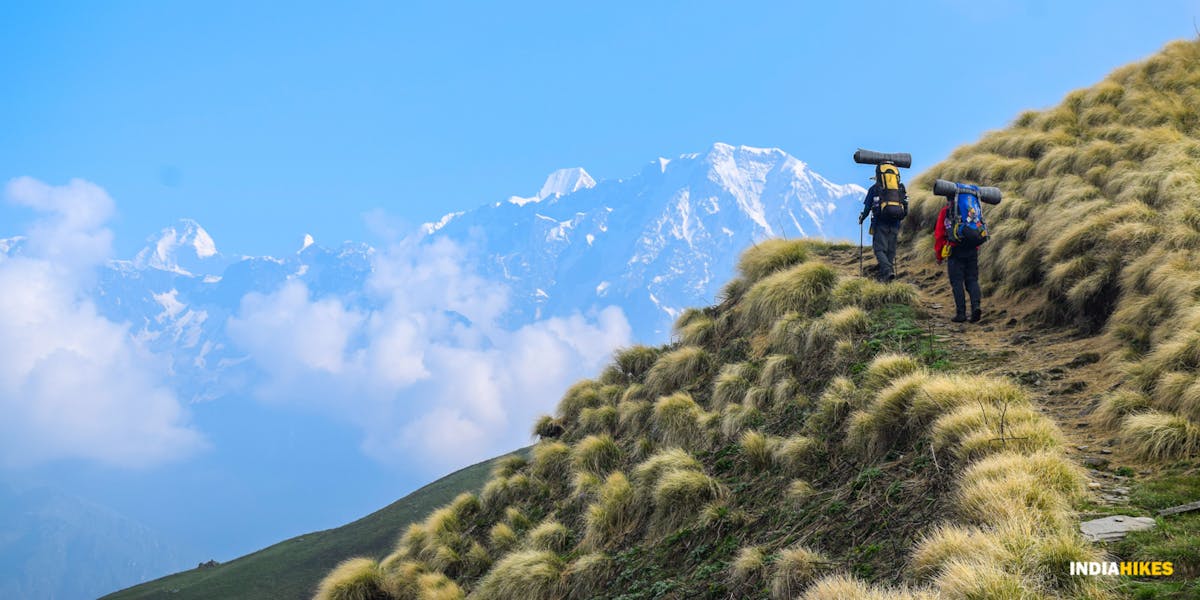
Ranthan Top Trek
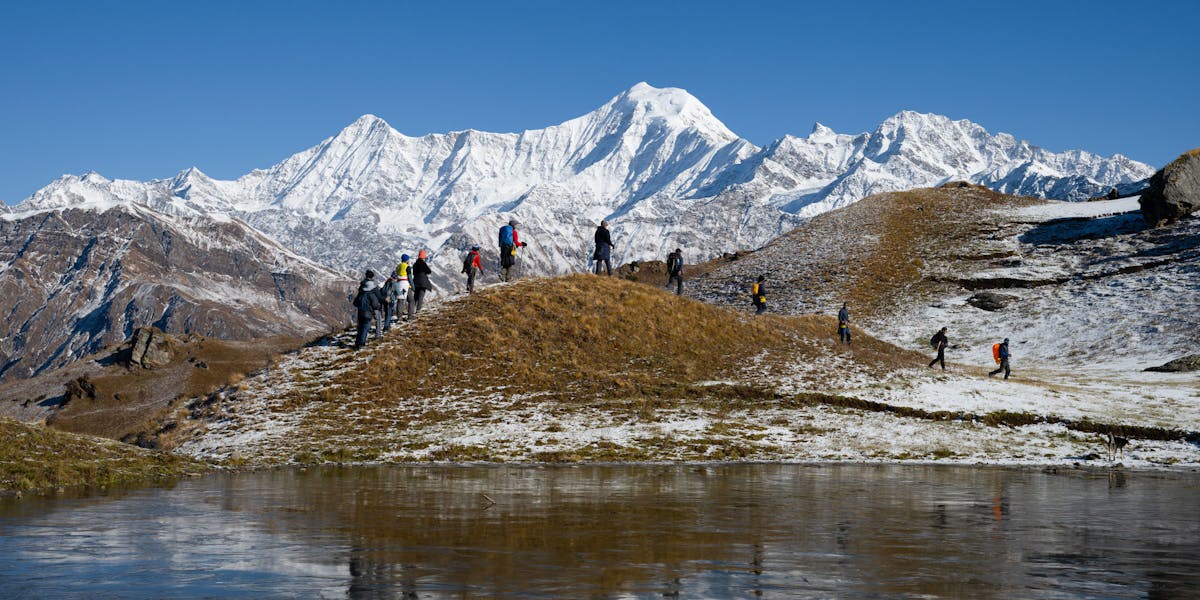
Goechala Trek

ALI BEDNI BUGYAL TREK

Brahmatal Trek
Sign up for our much loved Weekly Mailer
We have terrific trekking tips, trek updates and trek talks to look forward to
Treks by Season
Treks by month, treks by difficulty.
- Easy - Moderate
- Moderate - Difficult
Treks by Region
- Uttarakhand
- Himachal Pradesh
- Lahaul and Spiti
- West Bengal
- Chhattisgarh
Treks by Duration
Special treks.
- Family Treks
- Stargazing Treks
- Senior Treks
- Adventure Therapy
- Summer Camps
- Youth Camps
- Cancellation policy
- Work with us
- Our sustainability practices
- Privacy Policy
- Terms & Conditions
080 468 01269 Mon to Sat - 9.30 AM to 7.30 PM Sun - 9.30 AM to 6.30 PM
Bengaluru Office
139, Defence Colony Road, Defence Layout, Sahakar Nagar, Bengaluru, Karnataka 560092
Dehradun Office
No.85/10, Neshvilla Road, Dehradun - 248001
© 2024 Indiahikes Private Limited
All images are copyrighted by their respective authors.

Dzükou Valley Trek: Your Ultimate Guide To India’s Famous Hike
By Joydeep Phukan. This guide to Dzukou Valley trekking contains affiliate links to trusted partners!
Interested in doing the Dzükou Valley Trek ?
Then you’re in the right place!
You’ve likely heard of the famous hikes in India’s Himalayan region; but, have you heard of the Dzükou Valley Trek in Northeast India?
Sitting in the clouds at an altitude of 2,452 meters (8,000 feet) above sea level, the Dzükou Valley — also written as Dzukou Valley or Dziiko Valley — is located in the Indian state of Nagaland.
The administrative border between the states of Nagaland and Manipur passes through the valley; however, Dzükou Valley is only accessible from the Nagaland side.
Inhabited by 16 major ethnic groups and sub-groups, Nagaland is blessed with cultural diversity, mountains, and natural beauty, which is best explored by doing the popular Dzükou Valley Trek.
Interesting fact:
The term “Dzüko” is derived from the local Viswema dialect of the Angami Nagas and means “dull and soulless” — though don’t let this deter you from visiting for a hike. The name was given because the ancestors of Viswema village couldn’t cultivate crops or establish a settlement in the valley.
They were, however, still able to appreciate its extreme beauty. Dzükou Valley is covered in dwarf bamboo shrubs, with high hills surrounding uniform hillocks and a tranquil river flowing through the valley. Moreover, the views you’ll enjoy while hiking are truly spectacular.
Table of Contents
What Type Of Hiker Are You? [Free Quiz]
Now, before we dive further into how to hike the Dzükou Valley, I want to share a free personality quiz I think you’ll love!
Discover your hiking persona in this fun and short hiker personality quiz , which also shares trail suggestions based on your results.
Once you’ve grabbed the quiz, keep reading for an in-depth Dzukou Valley Trek Guide. This stunning hike is a must-do for outdoor enthusiasts visiting India !
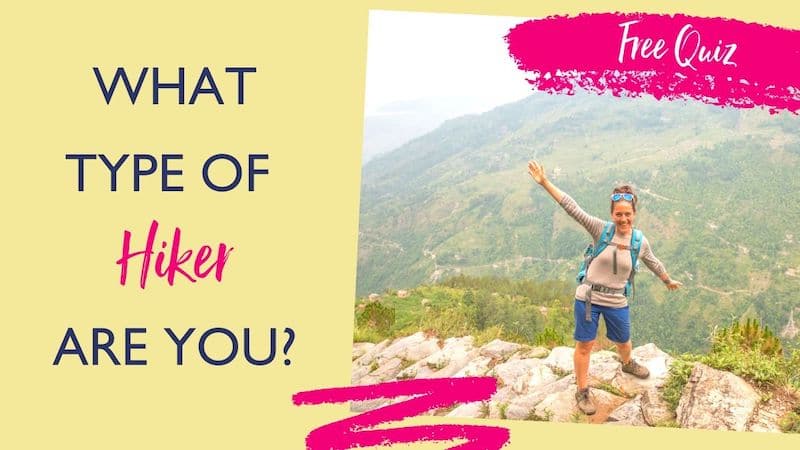
Dzükou Valley Trekking Map
Before hiking in the Dzükou Valley, it’s recommended to check out a map to get a lay of the land.
The below Dzükou Valley map offers a great starting point, or you can click here for the interactive Google Maps version .

Best Time To Do The Dzükou Valley Trek
In terms of the best month to visit Dzukou Valley, it’s truly a year-round destination.
In fact, monsoon season — May to August — is when the vibrant pink Dzükou Lily blooms. This flower is very special, as it can only be found in the Dzükou Valley. As it grows alongside other colorful flowers against lush green grasses, it creates a truly stunning scene.
On the other hand, during winter, the Dzükou Valley is covered by frost and receives snowfall, particularly towards the end of December until February. As long as you don’t mind the cold, this can be a lovely time to visit as you can take in frozen views of the valley.
How To Reach Dzukou Valley (Getting There)
The Dzükou Valley can be reached via two hiking trails; one from the Viswema Village and the other from Jakhama (also spelled Zakhama).
Hikers generally go through Viswema, as the Jakhama trail is much steeper. In fact, Viswema only has about one hour of uphill hiking vs Jakhama, which is a steep ascent almost the entire way. Remember, you can always go up the Viswema trail and down the Jakhama trail.
Viswema Village is about 14 miles (22 kilometers) and Jakhama is about 9 miles (15 kilometers) from Nagaland’s capital city of Kohima.
To reach Kohima, private cars, taxis, sumos (shared taxis), and buses regularly drive from Dimapur, which is home to the nearest regional airport. LGBI Airport in Guwahati (Assam) is the nearest International Airport.
By railway, the Dimapur Railway Station is well connected to other states. You can head to Kohima from the station by boarding public buses, private cars, and sumos. It takes around 2-2.5 hours to reach Kohima from Dimapur.
From Kohima, you can take a shared taxi from the Networks Travel AOS Bus Stop to reach either Viswema or Jakhama.
Important note:
Indian nationals must get an Inner Line Permit (ILP) to visit Nagaland. For foreign visitors, passports and visas are enough for entering Nagaland; however, they sometimes ask foreign tourists to register themselves at the nearest local police station upon their arrival to the state.
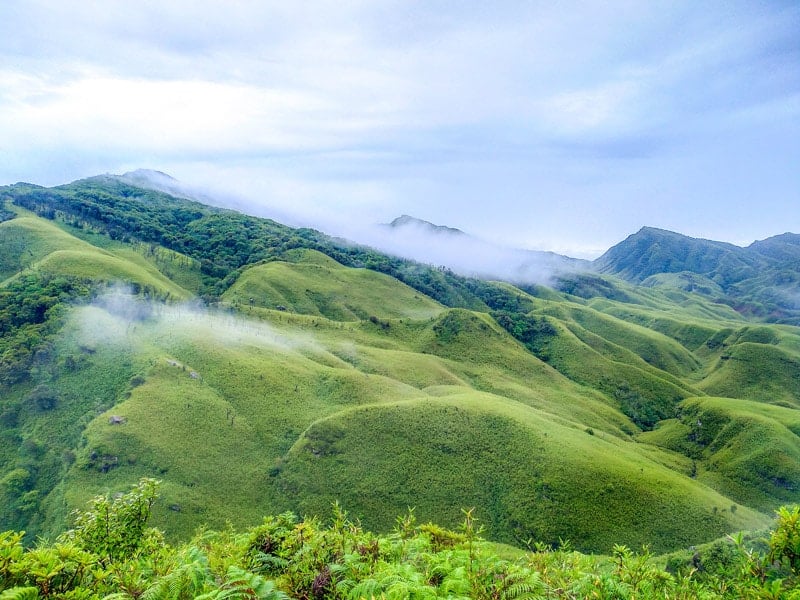
The Dzükou Valley Trek– Essential Information
Dzükou Valley Elevation: 2,452 meters (8,000 feet) above sea level.
Dzükou Valley Trek Elevation Gain : Viswema is 1,631 meters (5,351 feet) above sea level and Jakhama sits at 1,606 meters (5,269 feet). This means a hiker would gain about 821 meters (2,694 feet) when hiking from Viswema and about 846 meters (2,776 feet) when hiking from Jakhama.
Dzükou Valley Trek Difficulty: Moderate (from Viswema) and difficult (from Jakhama).
Dzükou Valley Trek Duration: The minimum time to reach the Dzukou Valley Guest House — which is the end point of the trek — is about 4-to-5 hours from both villages. The Dzukou Valley Trek distance distance via Viswema is approximately 13 kilometers (8 miles) and 10 kilometers (6 miles) via the Jakhama trail.
Dzükou Valley Trek Location : Kohima District, Nagaland.
Dzükou Valley Trek Trailhead: The best part of hiking to Dzukou Valley is plenty of signage along the way!
- The trailhead at Jakhama starts from the main road near a bridge by the river — a little ahead of the sumo stand of Jakhama. Click here for a Google map .
- At Viswema, the hiker has to first reach the “Trekker’s Point”, which is about 8-9 kilometers (5-5.6 miles) from the village. The actual trail starts from the Trekker’s Point. Click here for a Google map .
Other Nearby Hikes: When in Nagaland, also don’t miss Mt. Saramati and the Japfu Peak Trek .
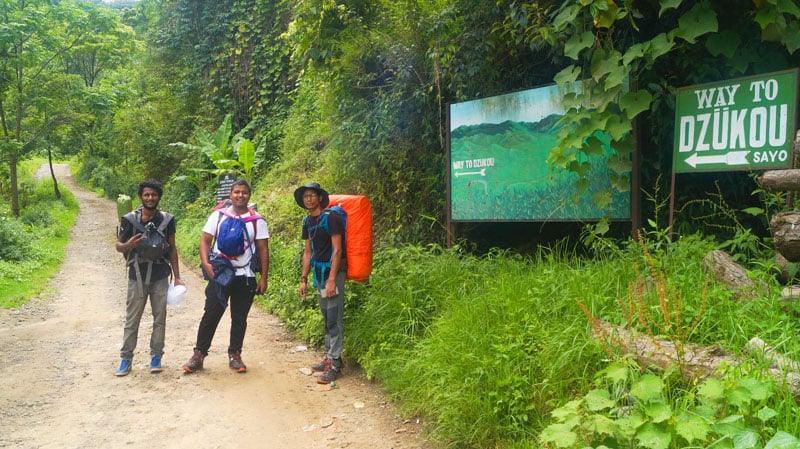
Dzükou Valley Trek Step-By-Step Guide
Ready to embark on one of the world’s best hikes ? Let’s do this!
Dzükou Valley Trek via Viswema
From Viswema, one can walk 8 kilometers (5 miles) along drivable road or hire a taxi outside the village gate for about 1000-1500 INR (~$14-$20 USD). While walking can save you money, it also expends quite a lot of energy and adds about 2-3 hours to your hiking time.
Once the road ends, you’ll reach the “Trekker’s Point” — which is when it’s time to hike.
The trek begins with a steep 4-kilometer (2.5-mile) climb up rough-hewn stone steps through forest. This section takes about 45 minutes to an hour.
Note that depending on the weather, this section can be muddy and slippery, so make sure you bring the proper hiking attire .
Keep trekking until you reach the top of Viswema Hill, which is when you officially reach the Dzükou Valley. Spend some time here admiring the breathtaking views over the valley.
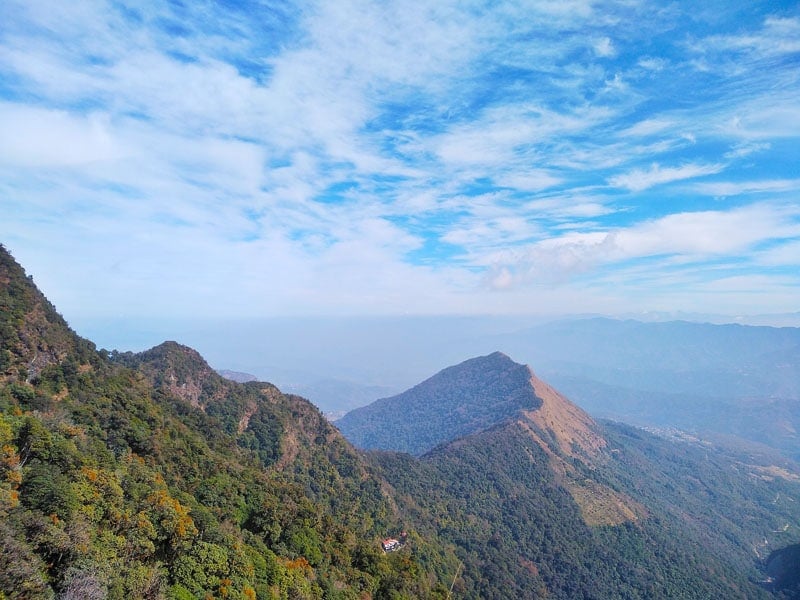
Along with being beautiful, this is also where the steep section ends and where you’ll be faced with two trails. The one to the left goes to Mt. Tempfu, while the trail to the right leads you to deeper into the Dzükou Valley.
Head right and enjoy the scenery, as the rest of the trail — which is another 4 kilometers (2.5 miles) — is relatively flat. You’ll zig-zag along the valley slope and cross lovely little streams until you reach the Dzukou Valley Guest House.
Dzükou Valley Trek via Jakhama
Your other option is to hike from Jakhama, which is the more demanding of the two options, but it takes less time. Also note that during monsoon season, this trail may be extra slippery, so make sure to have proper footwear.
The trail begins at the bridge near the main road of Jakhama village.
Personally, I hiked right from the sumo transport stand in Jakhama. From the sumo stand, you can ask the driver to drop you 4 kilometers (~2.5 miles) ahead at the small rest house constructed by the Kohima Forest Division.
Hiking a little ahead, you will see local farms and farmer huts, which is where the road ends. From here, you’ll cross another river and begin the super steep trail through dense forest.
It is a painful straight ascent, with stone steps bringing you higher and higher until you reach the top of Jakhama Hill, which takes about 3-4 hours.
From here, you can enjoy a lovely view of the Dzükou Valley, the Viswema Trail, and the Watch Tower of the valley. The Watch Tower is of particular note, as it offers a true panoramic view of the Dzükou Valley and the villages below. It can accessed from near the Dzukou Valley Guest House.
After descending the hill, the Viswema Trail and Jakhama Trail merge. Turn right and you will immediately be able to see the Dzukou Valley Guest House. It is a flat stretch of just 2 kilometers (1.2 miles) to the accommodation.
Staying At The Dzukou Valley Guest House
The Southern Angami Youth Association (SAYO) maintains the Dzukou Valley Guest House.
There are two houses, which they refer to as dormitories. One has a wooden floor while the other is concrete. Hikers sleep on the floor in these dorms, and the guest house caretakers provide blankets, mats, and other sleeping accessories.
Once you reach the guest house, you will need to pay an entrance fee for hiking the Dzükou Valley as well as for accommodation, meals, and sleeping accessories.
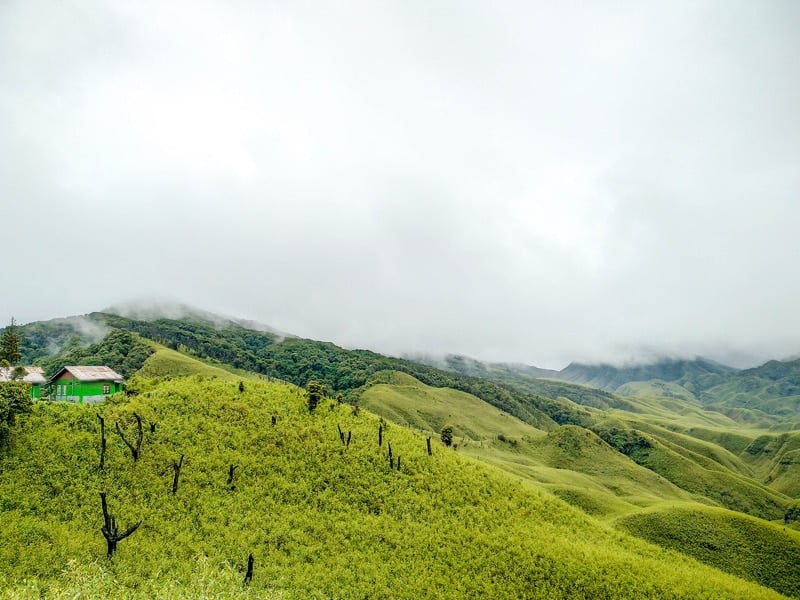
The guest house kitchen offers both vegetarian and non-vegetarian meals once a day. You can eat noodles (non-vegetarian) on other occasions.
A makeshift kitchen can also be rented if you want to cook for yourself, though you’ll need to buy firewood and rent utensils from the guest house.
There is also a small shopping stall at the campsite offering sweets, biscuits, and noodles, among other things.
A toilet/bathroom is available for public use.
SAYO also offers a cottage secluded from the main campsite area. It costs more than the dorms but has an attached bathroom.
Moreover, there is a campsite with space for pitching your own tent or you can rent a tent from the guest house.
In the summer months, water is readily available at the campsite in a reservoir connected to the stream. In winters, however, you have to collect water from a stream about 5 minutes away from the campsite for drinking and flushing the toilet.
Dzükou Valley Trekking Tips
Now that you know what hiking the Dzükou Valley is like, let’s go over some essential tips. The below advice will really help you have the best Dzukou Valley trip possible.
-Most people hike the whole day and stay at the guest house for only a night; however, to really experience the serene beauty of the valley, I would suggest you to stay at least 2-3 days. You may hike down into Dzükou Valley, visit the Watch Tower for a panoramic view, and swim in a river. Furthermore, you can hire a local guide to take you to lesser-known caves, natural pools, and waterfalls.
-Since there are two trail options, why not do both? Many people opt to hike the easier trail from Viswema to get to the guest house and then return via the steep Jakhama route, which is much easier on the way down, especially with its stone steps.
-Riverside camping has been banned due to littering. Therefore, the Dzukou Valley Guest House is where you can stay in the valley.
-There is no electricity in the valley, so make sure to carry a power bank and headlamp. Moreover, charge your phone and camera battery fully before setting off on the Dzükou Valley Trek.
– Traveling solo ? You can totally do the Dzükou Valley Trek on your own! Plus, the Dzükou Valley is an incredible destination for solo female travel in India . That being said, a local guide will help you from getting lost, can enlighten you about local Naga traditions, and can share interesting folklore stories associated with the valley. Bonus: by hiring a local guide, you’re supporting the local economy.
-You won’t find any shops for snacks or eateries along the trail. Though you will find a few streams for collecting clean drinking water, it is always advisable to carry a good amount of drinking water and dry fruits to eat during the hike.
-Since the trek time is about 4-5 hours from either of the villages, it is suggested that you start early in the morning. Arriving to the guest house in the evening can sometimes mean there aren’t any rooms or campsite spots left.
-While blankets are available at the guest house, if possible, it’s wise to bring a high-quality sleeping bag and accessories . This is especially true during the cold winter months.
-There is no network connectivity in the Dzükou Valley. If you want to call your loved ones, you have to climb to the peak of the hill where the Watch Tower is.
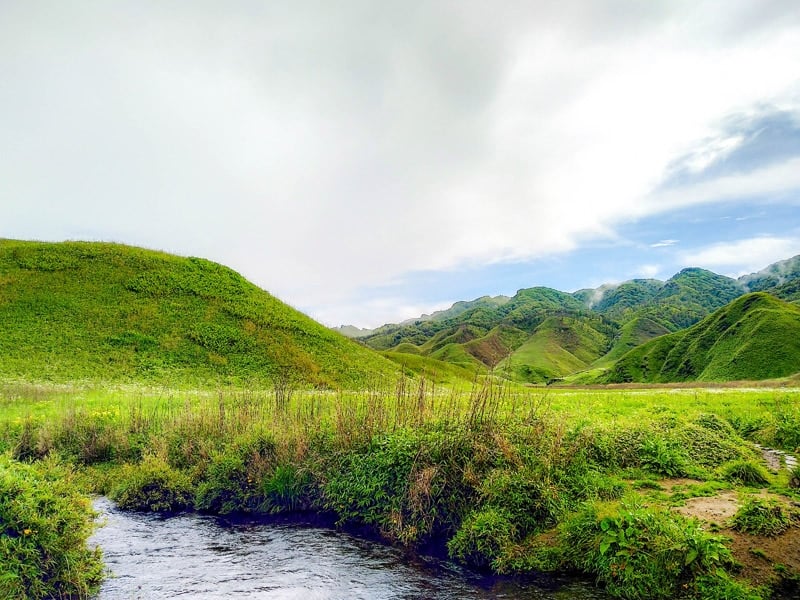
What To Pack For The Dzükou Valley Trek
If you are visiting the Dzükou Valley during monsoon season in the summer, there is a higher chance of rain. Therefore, a poncho or raincoat and rain cover (for your backpack) is a must.
You must also wear shoes with good grips, as the trails become slippery.
As far as clothing is concerned, hikers should bring a lightweight jacket, thermals, stretchable hiking pants, t-shirts, socks, and gloves. Bring an extra set of clothes if you plan to spend time swimming.
Wearing sweatshirts or T-shirts during the day is sufficient, but it gets very cold at night.
Moreover, during winter, it’s extra important to carry a quality sleeping bag. You’ll also want to bring some extra layers and potentially an extra jacket for additional insulation.
You can purchase all of your hiking clothing and camping gear at REI here .
Dzükou Valley Trek Cost
In terms of the Dzukou Valley trip cost, registration for the hike costs 100 INR (~$1.34 USD), while accommodation costs:
- 1500 INR (~$20.15 USD) for a room in the cottage with attached bathroom
- 100 INR (~$1.34) for a dormitory space or campsite
Now, if you’re curious what the approximate costs are for your entire round-trip from Guwahati in Assam (where the international airport is located), you’ll likely spend about 4,000 INR to 6,000 INR (~$54-$81 USD). This includes trains, transport, accommodation, food, and guide.
Travel Insurance For Your Dzukou Valley Trip
When visiting India — or anywhere else in the world — it’s wise to get travel insurance.
One of the best travel medical insurance for travelers is SafetyWing as they’ve got a large network and offer both short-term and long-term coverage — including coverage if you’re traveling for months as well as limited coverage in your home country).
Additionally, SafetyWing is budget-friendly and offers $250,000 worth of coverage with just one low overall deductible of $250.
Click here to price out travel insurance for your trip in just a few clicks .
Have you ever done the Dzükou Valley Trek ?
About The Author
Joydeep Phukan is the founder of the blog The Gypsy Chiring . He shares his stories and tips on travel, adventure, food, and culture from places around the world — but primarily covers Northeast India. He intends to promote the lesser-known cultures and offbeat destinations of Northeast India. Connect with him on Instagram , Facebook , Twitter , and Pinterest to explore Northeast India together.
Enjoyed this Dzukou Valley Trek blog post? Pin it for later!
Related posts:

Hi, I’m Jessie on a journey!
I'm a conscious solo traveler on a mission to take you beyond the guidebook to inspire you to live your best life through travel. Come join me!
Want to live your best life through travel?
Subscribe for FREE access to my library of fun blogging worksheets and learn how to get paid to travel more!

Turn Your Travel Blog Into A Profitable Business
Subscribe to my email list to snag instant access to my library of workbooks, checklists, tutorials and other resources to help you earn more money -- and have more fun -- blogging. Oh, and it's totally FREE! :) // Privacy Policy .
Check your inbox for your welcome email + resource library password!
Hello there, I just wanna ask about hiring a taxi to reach the trekker’s point. It cost 1500 INR for the taxi. Is that for the round trip or do we have to pay another 1500 INR to reach the Viswema village gate from the Trekker’s piont. IF its for the round trip, then does the taxi wait or do we call for it to pick us up. Answering this would be very helpful. Thank you.
It’s not a round trip. You have to pay again. The fare has recently been increased too. It is 2200 INR just for taking you up till the trekker’s point. And yes , you have to call the driver once you get network near at the top of the Viswema hill or a little below. The alternate choice is to hike right from the main road via Viswema or trek through the Jakhama trail.
Thank you….. you have been very helpful. I just needed this information to complete my plans. Thank you again.
Great article. I think a lot of it can be summed up by the simple rule of respect for persons and respect for land i.e treating others as you would like to be treated…this usually works for me. Obviously that’s oversimplifying it a bit… 🙂
Idk why I’m googling Dzukou Valley today but I got nostalgic… back when I visited Nagaland in 2015 there was little to no information about the region online 😀 it’s cool to see more now. I visited a friend (made unexpectedly over a facebook bug lol) in Chedema Village and we made a 3day trek to Dzukou (took the Jakhama route and itttt was toughhhh). It was mid August and it was super weird but we got nice weather until we were almost completely descended. Sad to hear the riverside camping is forbidden now, it was nice to sleep under the slanted rock outside 😀 but littering is a big problem and was really sad to see all over the region. I was barely 18 and never had travelled out of europe so arriving in New Delhi and taking a 36hr train to Dimapur was a huge culture shock xD but reaching the mountain village was such a relief. The Naga people in the village were so welcoming and curious.. I really loved staying there 🙂 ..uhh yea so thanks for helping me indulge in reminiscences ~
Yay! Glad to know that the article helped you reminisce your beautiful memories of Dzukou Valley. It would be great to meet you in person. Do plan again, I would be happy to help. Are you aware of the Hornbill Festival of Nagaland? Here, all the 16 major Naga ethnic groups showcase their culture. You would love to attend it. It is conducted every year from December 1st to December 10th.
Leave a Comment Cancel Reply
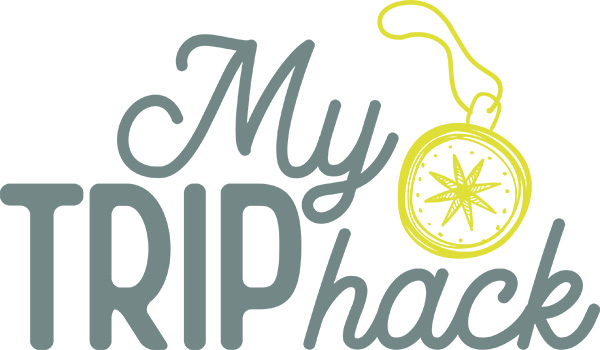
Dzukou Valley trek by yourself
Dzukou Valley is one of the gems in North-East India on the border of two states – Manipur and Nagaland. Despite it is a less explored area in India and there is a lack of information about this region, there is a huge scope for independent travelers to enjoy the untouched nature there. In this post, I will share with you how to do Dzukou Valley trek by yourself and here are the specific points I will focus on:
When to visit Dzukou Valley?
- How many days Dzukou Valley trek takes?
Where to start Dzukou Valley trek?
- How to reach Dzukou Valley from Kohima?
What are Dzukou Valley trails like?
- Dzukou Valley trek from Viswema
- Dzukou Valley accommodation
- Food during the trek
Is it safe to trek Dzukou Valley solo?
Dzukou valley trek cost, dzukou valley in winter, what to pack for dzukou valley trek.
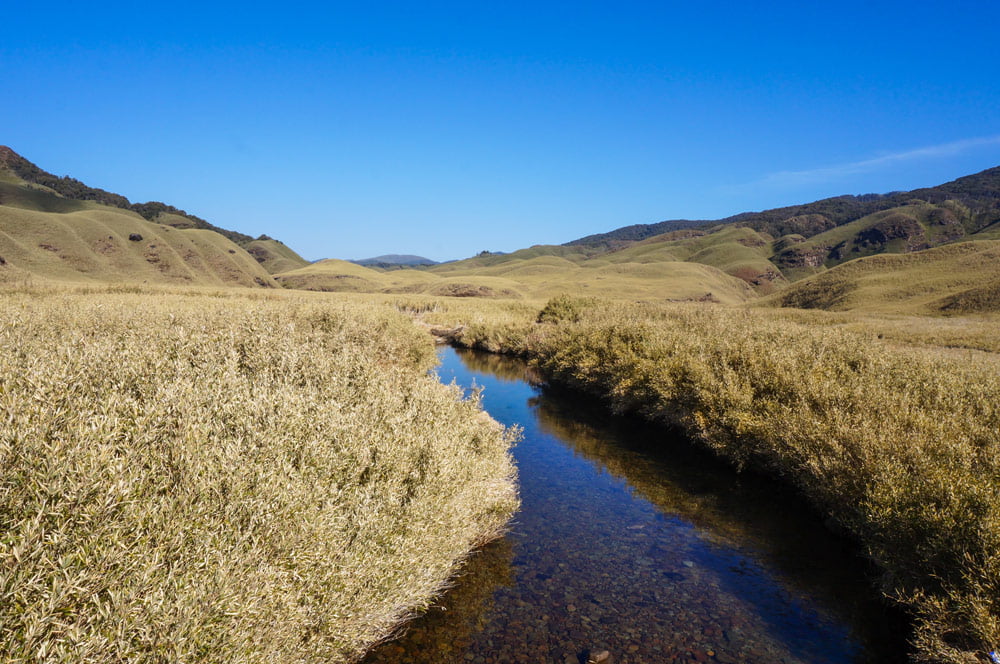
Dzukou Valley is also known as the Valley of Flowers of North-East. If you would like to see the flowers blossoming the best time to visit Dzukou Valley is from mid-June until August. There is a Dzukou lily that grows only in this area. Nevertheless, this time coincides with the monsoon season, so the trail will be slippery and you might encounter leeches.
The valley is a feast for eyes throughout the year. There are the travelers who trek Dzukou Valley in December after Nagaland famous Hornbill festival. Though winter is a low season to visit the valley, there are some definite pros to do so. We will look into Dzukou Valley in winters a bit later in the post.
Read also: Best time to visit India depending on itinerary
How many days is Dzukou Valley trek?

Dzukou valley trek is roughly 15-20 km one way, depending on the route and it can take 2-3 days. It is possible to reach Dzukou Valley on the first day. Meet the sunrise next morning and explore the valley – there are several streams, caves and of course picturesque views. On the third day, you can trek back from Dzukou Valley to the town. If you are fit and feel you can make 30 km in two days – it is tiring, but possible.
Though the altitude of Dzukou Valley is 2438m, you don’t really feel any side effects of this gain (e.g. weakness) that normally comes with acclimatization in the hilly areas.
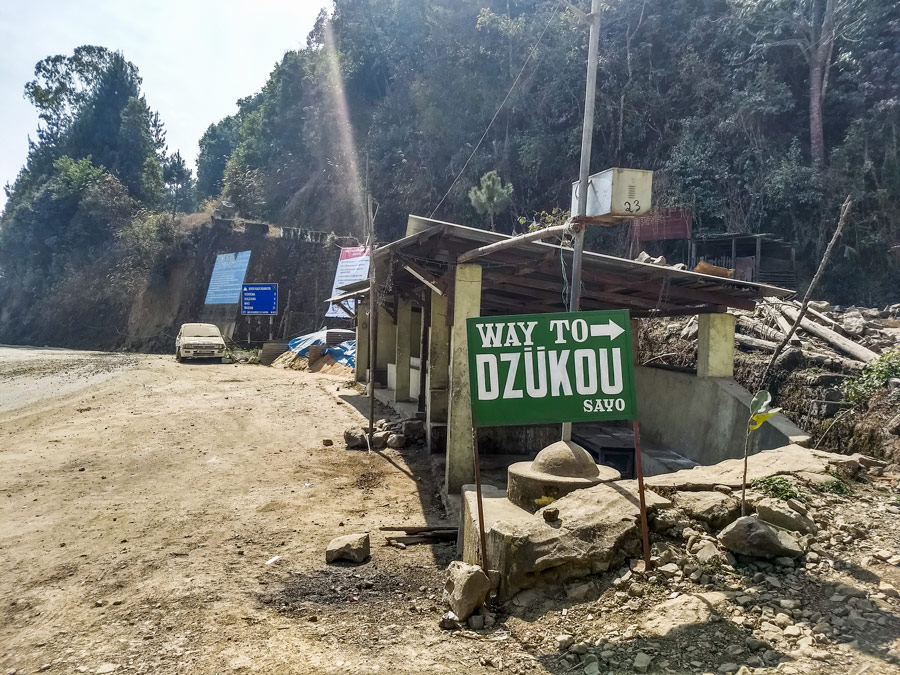
While there is a road to Dzukou Valley from Manipur from Senapati district, the main route to the valley is still from Nagaland. There are two villages in Nagaland you can start the trek from: Viswema and Zakhama (pronounced Jakhama). All the local people will recommend you starting from Viswema. I wouldn’t call it an easy route, but even if trekking is not your thing, it’s do-able without preparation.
There is also an important point – you have to reach Viswema or Zakhama from your base stay. There is one Airbnb homestay in Viswema which costs 33 EUR/night. I talked to several shopkeepers in Viswema, and they were not aware of any other accommodation options coming up in those villages.

There are several homestays in Kigwema village (5 km from Zakhama and 11 from Viswema). In my opinion, unless you don’t stay in the villages where the trekking route starts, the most practical decision is to start from Kohima itself. Kohima is 15 km from Zakhama and 22.5 km from Viswema and there are plenty of accommodation options.
Side-note: do experience Naga villages, but take your time to explore the village beyond a brief stay.
How to reach Viswema and Zakhama from Kohima?
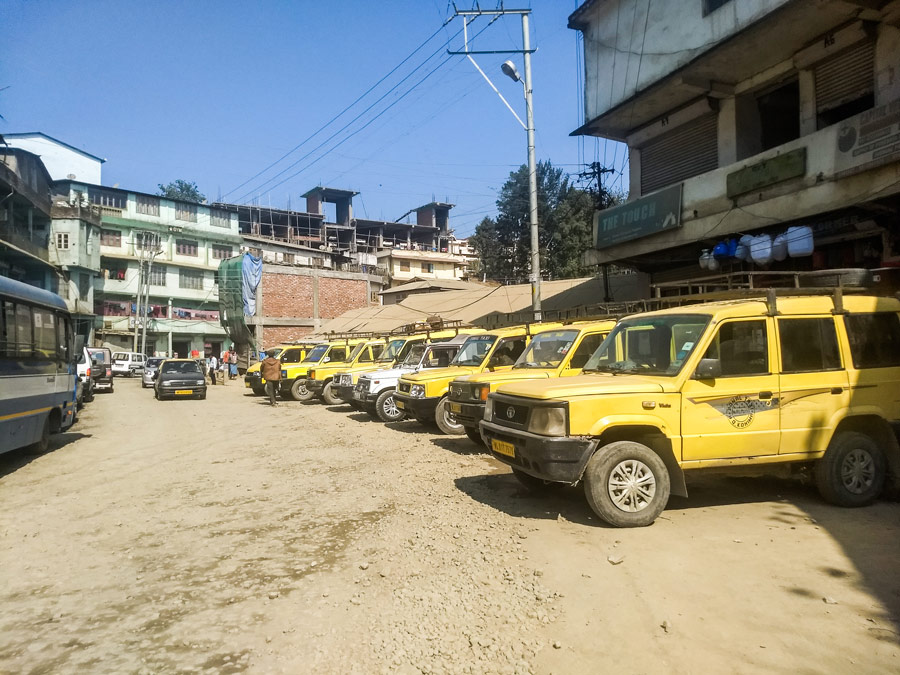
There are shared yellow sumos, that start from Kohima here (25.656408, 94.099104). If you start from any part of Kohima by bus, ask them to drop you at the AOC Bus Stand near petrol pump (25.653284, 94.099152). The cost from Kohima to Viswema is 50 INR and to Zakhama 40 INR.
Sumo cars leave once all seats are filled and the journey takes 40 min to 1 hour depending on the traffic. Roads are good. Tell the driver where you want to go as there are many sumos that cross Viswema and Zakhama on the way to the neighboring villages. Also, ask the driver to drop you at the start of the trek or near the entrance to Viswema Village.

To be honest, whichever path you will take the road is quite monotonous till you enter the valley. Afterward, it’s jaw-dropping, but the hardest and the longest climb is before the valley. Unlike Anapurna Circuit trek where you see breathtaking views all along the way, here you just have to make it through bad roads to see the hidden beauty.
Whether you start from Viswema or Zakhama, there are a few km of pebble car road that can kill your feet if you are not in the right footwear. Then there is a steep climb on stairs that reminded me the route to Sarangkot from Pokhara by foot . Afterward, you will enter the valley and will have a few km walk through the jungle surrounded by green hills.
Dzukou Valley from Viswema with time

There is different information about km length of the trek online. Unless you have an app, it’s hard to estimate the length of the trail as it is not on google maps. I’m an average walker who does 5-10 min breaks every one hour of walk. Here is how much time it took me to climb to Dzukou Valley:
Pebble road – 2.5 hours walk. You can talk to local taxi to drop you till the stairs. The car will cost 1000 INR, but if you are traveling in a group, you can share the ride. Also, there is constantly some construction going on the road, so some cars are going up and down. You can try to hail/ask them for a lift for a better price.
Steep stairs – 1-hour climb. Some sources claim it’s only 1 km, but the stairs are steep and you are already tired after walking on the car road, so this takes an effort.
Straight walk through the jungle – 1.5 hours. This is the easiest part, though sometimes the grass is so high that you can’t see anything beyond.
Overall it takes 5 hours of a moderate walk with short hourly breaks. I started from Kohima quite late (~9 a.m. from the guest house, 10.45 a.m. Sumo station) with a thought to stay in Viswema or around.
Once I reached Viswema, all the locals were very confident that I’m gonna make it and suggested to go to Dzukou same day. I started trek at 11.30 a.m and reached to the guest house at 4.15 p.m. By 5 p.m. it became pitch dark.
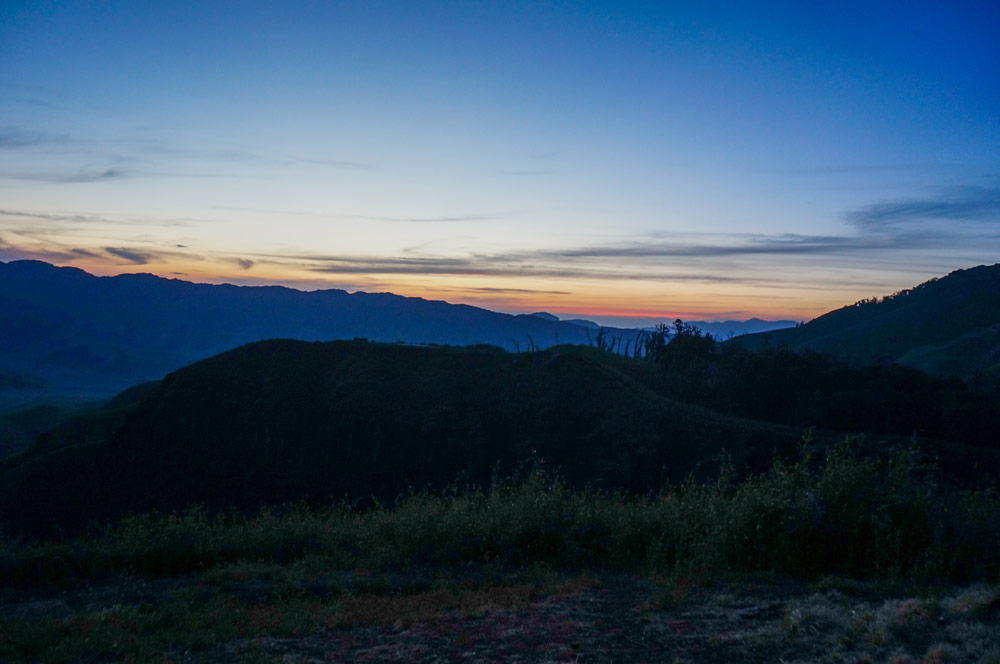
I recommend starting from your guesthouse in Kohima no later than 8 a.m. and if your budget permits, take a taxi to the Sumo stand from the guesthouse. It took me quite a lot of time to go to the bus station, wait for the bus, walk to the AOC stand before I started the journey to Viswema.
Once you are in the guest house in Dzukou valley, you can plan a visit to the valley next morning. It takes around 45 minutes to descend to the valley and 1.5 hours to climb back. Also, you need at least 2 hours to explore the beautiful sceneries of the rolling hills in the valley as that is the whole reason for this trek. Other than that there are several caves and a few river/streams.
Dzukou valley accommodation

For the moment, there is just one guest house in Dzukou Valley (25.561223, 94.079647) and it is quite basic. There are two dormitories and five “VIP” rooms with scary graffiti on the walls. In a private room, you get an attached washroom, though you need to walk to the stream to bring water for using a washroom.
The dorm place costs 50 INR and the private room bed 150 INR per person or 300 INR per room. The private room has two wooden beds and dorm has no furniture.

According to Avi (one of the guesthouse keepers), Dzukou Valley guest house is open throughout the year. There are two people consistently staying there as they never know when the trekkers might come. Though, I still recommend double-checking this in the off-season with the villagers before the climb.
There is one more guesthouse under construction on the way from Viswema (25.542813, 94.09957). Also, there are many metal sheet DIY huts on the way, where, I suppose, the workers live, but in extreme cases, you can hide from the rain there.

Camping in Dzukou valley
There are some trekkers who come with their tents and put their base in the valley itself. There are a few caves and an open space in the valley as well. By the old garbage trail ( really, people??? ) near the caves, I could say it’s a popular spot.
If you are interested in camping, you can buy wooden logs for cooking and warming purposes from the guest house for 10 INR per piece.
Food in Dzukou valley

The only food point in the valley is the guest house. They have a kitchen, where they serve basic food – tea, rice, potatoes, dal. They charge 200 INR per person, the portions are big.
I strongly recommend taking water with you from Kohima or whatever your base is. I’ve taken 2 liters, though I ran short of it next morning. Don’t know on which point it went wrong, but I had a huge stomach problem after return (and I suspect it was water).
In low season (not July-September and December) you will only get tea in the morning. So bring your own snacks and food for other meals except for dinners and lunches.

As a person who walked most of the days in Annapurna Circuit solo , I would not recommend going to Dzukou valley alone. Firstly, in winter months, except December, sometimes you can be trekking all by yourself. According to Avi, there were no visitors for two weeks before me. There is also no phone or internet connection on the road, so if anything – you are completely on your own. The path is safe, but for your peace of mind, it’s good to have a company around. I’m happy I had a friend joining me for this trek.
The overall cost of trekking in Dzukou Valley came almost to 1000 INR for two days and one night for me. Below are the costs for different services, so you can calculate your budget.
Cost of visiting Dzukou Valley

- There is an entrance fee of 50 INR for Indians and 100 INR for foreigners. You pay it in the guest house once irrespective of your length of stay.
- Transport from Kohima to Viswema 50 INR – one way
- Dzukou accommodation 50-150 INR/day
- Dinner 200 INR
- Tea/coffee – 20 INR/cup
- Blankets, pillow, foam sheet (they call it mattress) – 50 INR/per piece ( so, if you are taking a pillow and 2 blankets it’s 150 INR ). If you don’t have a sleeping bag, you might need around five blankets in winter. Take advice from the guest housekeepers, they will tell you how many they use and the numbers are pretty accurate.
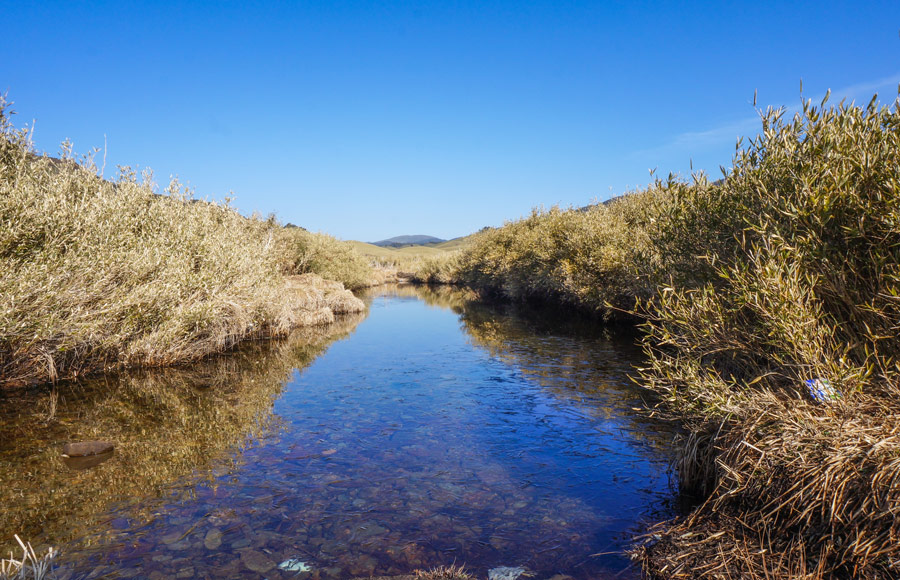
There are certain benefits of visiting Dzukou Valley in winters. For instance, there are few visitors (except December) – just you and nature. You can see the frost in the valley and ice on the rivers which is a magnificent site. You can form a more personal rapport with guesthouse keepers – they are nice people who shared their local apple cider and didn’t mind me staying in the warm kitchen while talking about Naga culture and what not. I don’t think this might be a scenario if there are 100 other backpackers.
From the other side, you have to be ready that it gets really cold. During the daytime, the weather is very pleasant till the sun is up. Once the sun rolls behind the hills, there is a scary whistling wind, it’s getting freezing everywhere and it takes a long time to warm up and sleep. Nevertheless, there is the starriest sky I’ve ever seen. I thought, nothing can beat the Thar Desert , but Dzukou Valley just made it.

Now that you made up till here (and hope it means you got convinced to visit Dzukou Valley), here are some suggestions what to take with you. I strongly recommend packing as light as possible, nevertheless, don’t miss the following things:
- Torch – there are solar powered lights outside of the guest house, but inside the homes and the area between the dorm and private rooms is pitch dark. Whether you have a super performant phone battery and torch there or a separate one, take it with you.
- Raincoat – even outside the monsoon season it rains occasionally in the valley. It was raining for an hour on my way back and my coat became handy.
- Gloves – if you travel in the winter season, they are helpful in the evenings.
- Snacks – in offseason you can count only on lunches and dinners in the guest house. Bring everything else according to your necessity.
- Water – quality bottled water is always a good thing
- Garbage bag – to take everything you produce back to the city
- Warm clothes – it’s a hilly area, so nights are chilly throughout the year and freezing in winters when the temperature drops way below 0.
- Sleeping bag if you have one – the “sleeping kit” of the guest-house might not be up to your expectations.
- Power bank – there are no charging points in the valley. Should you need to charge anything – do it in advance.

- Internet & connectivity. Once you enter the valley, there is no network coverage. You will be out of reach till you exit the valley.
- Plan smart. If you trek in the peak season (summer) avoid weekends. According to Avi (guest-house keeper), the maximum number of people hosted in the guesthouse were 200 per night in July. They have only a few houses and resources are limited.
- Indians, you need Inner Line Permit to travel in Nagaland. You can get it in Dimapur or Kohima Deputy Commissioner Office depending on your first stop.
- As per several sources, foreigners need to register in police office within 24 hours after arrival to Nagaland. With my law-abidance, I’ve spent a half day by being redirected from one place to another. If you decide to register, you need to head to SP Office, there is a department for foreigners here (25.663807, 94.098737). The police officer told me that I’m the first foreigner they’ve seen in a few months since normally the guest house is submitting info about the foreigners in Nagaland online. Go figure out who is right 😀

- If you feel you are in a great shape and willing to take Zakhama route on the way back, it starts from here (25.557649, 94.083434) with a board the Alternate trek route – if you descend. To ascend, ask the driver to drop you at Zakhama starting point, it’s just near the road.
- The last taxi from Viswema to Kohima according to the drivers is at 4 p.m. I took one at 4.30 p.m, but I wouldn’t take chance.
- Whatever garbage you produce in the valley, keep it in a bag and take it back to Viswema or another base. The guesthouse keepers installed the bins on the trail. Let’s help them keep the valley clean!
Dzukou valley trip is one of the highlights of North-East. If you are into active traveling style, don’t miss it!
Have you been to Dzukou Valley or do you know other similar scenic treks? What would you recommend?
Share the post "Dzukou Valley trek by yourself"
25 thoughts on “Dzukou Valley trek by yourself”
I have read the blog and it’s very useful for me. Thanks.
Thank you for feedback, Sanjay!
Giving us the coordinates are a genius idea! Thank you for this information 🙂
Thank you for feedback, Claire! Have a great trip
Beautiful. Heaven on Earth.
Thank you for reading, Pranab
Excellent Blog. Thanks
I’m happy you found it useful, Sidhu
Thank you Natalia for all the information for Dzukou visit . Thought I am from Kohima never been to Dzukou and I left Kohima in 1993 .. So visit again next year in Horn Bill festival and thinking to trek Dzukou .. Is the prices still the same or rise up ?? lol
I highly recommend visiting Dzukou, Deepa. The valley itself looks like taken from another world). Hornbill festival and July (Dzukou lily season) are two of the most popular/crowded seasons in Dzukou. There might be some price fluctuations during these times.
Overall, the price range will be the same. BUT, some people read this post and they think they can stay a night in the dorm for 50 INR (and they can), but you are getting the unfurnished space the way you see it. All the blankets/food/drinks and other expenses add up.
From my experience, 1000 INR per weekend (2 almost full days, 1 night) sounds like a reasonable budget unless you come with your tent. If you bring food/water/warm clothes/tent with you – the costs will be significantly lower.
Have a great trip!
Thanks Natalia for all the details.It is very helpful.I ,along with my wife is planning visit to Dzokou and hornbill December 2019.My intent is to stay two nights in Dzokou and stay one night to see the hornbill festival.I actually talked to some tour operators and they are asking for about 3000 per person for Dzokou trek for one night.It sounds high to me so just wanted to know your thoughts.They are also providing Hornbill festival tour with tent accomodation at the rate of 1500 per night.I am not looking for a luxury trip and open to shared cans.So any suggestions would be helpful.So what would be your suggestion for – two nights in Dzokou and stay one night to see the hornbill festival
Thank you for reading, Subhajit!
I’m yet to visit the Hornbill festival one day! I suppose prices for Dzukou valley trek will be higher during Hornbill since it’s one of the most popular times to visit Nagaland. 3000 INR per person sounds high at the beginning but it depends on what is included in that price. All the costs described in this blog post are from my personal experience. I chose to save money over time. E.g. I had to catch a bus to get to the sumo station, waited at the station for the right yellow sumo which dropped me near the village entrance. I could easily cut an extra 2 hours in waiting if I opted for a direct taxi.
Once in Vishwema, I walked on the pebble road for 8-9 km instead of paying 1-1.5k INR for a lift. Now thinking about these potential additional costs, I can see how organizers came up with this cost of the trek. To be honest, I wouldn’t expect any luxury in 3k INR for Dzukou and I strongly recommend to check what is exactly provided for this cost.
Regarding the length of the trip – consider if you plan 2 days and 1 night in Dzukou (as I did), it will involve a lot of walking and active experience – cca 15 km a day. (if you don’t cut the pebble road). I think you will need at least 2 days to get an idea of Hornbill. Personally, I would spend 1 night/2 days in Dzukou and the rest of the time in Hornbill, but it’s a matter of personal preference.
Hope it helps! Have a great experience, Subhajit!
This was very helpful. Informative and meticulous. Thanks for sharing the information. I am planning to visit the valley in November.
Thank you for reading and feedback, Samir!
I m too planning next week just wanted know as i am staying in kigwema , i have been told that 2000 is the transportation charges which they charge , is it true, if yes , then whats the alternative and best route
If you are going by the private vehicle, they might charge an arm and leg. I recommend talking to local people about the best timing and ways to reach on the week of your trip. I traveled by yellow shared sumo from Kohima to Viswema directly, so it was a budget option. Wish you a great trip, Pravin!
Can you provide any contact details of ‘Avi’, you mentioned?
Unfortunately, I don’t have his contacts since I met him in the Dzukou Valley guest house, where was 0 connectivity. I was out of reach for a bit more than 2 days and somehow didn’t exchange contacts with anyone) Nevertheless, the guys there work in shifts. A few days Avi stays in the guesthouse, then someone else. In any case, they ensured me during my trip, there is always at least one person in Dzukou to welcome visitors)
Excellent information I m visiting dzouku valley 1st week of dec.this year I” will follow ur suggestions . Thnx a lot
Have a great trip, Manoj!
Hi Natalia, your blog was very helpful got some great tips for my trip to Kohima and trekking in Dzukou Valley next week.
Thank you for reading, Nirav! Have a great trek!
Thanks a lot Natalia. Planning to go to Dzouku this December. Really helpful blog… thanks a lot
Thank you for reading, Subhajit! Have a great trip
Wow! This is so well written and informative.
Leave a Comment Cancel reply
Get a free guide about commuting in india, and travel updates in your inbox.
Copyright © 2015-2024 Mytriphack. All rights reserved
Privacy policy, privacy overview.
Travel Itineraries | Luxury Travel | Travel Tips
A Travel Guide to Dzukou Valley Trek – A World of Wildflowers and Picture Perfect Landscapes

Northeast India is undoubtedly a box of treasure containing gems and valuable stones of various form and colour. Each of the seven sister states in the North East pocket offers unique experiences for travellers. Unimaginable landscapes, hidden waterfalls and high altitude lakes overlooking vast valleys, what is it that you do not find in the North East Region? Well, I’m sure it is much more than what you can think of.
Discerning travellers, who are always on a lookout for raw experiences, must have surely come across photographs of Dzukou Valley an idyllic destination in Nagaland. Dzukou Valley is truly a nature’s wonder and a hidden gem, waiting to be discovered by the kinds whose souls wander in search of beauty amidst the wild!
In this blog, I have penned down every detail you might need to know before you commence your journey to Dzukou Valley. As the valley is untouched, it is wiser to read well about the place before you start planning. A thorough reading about the valley would help you prepare yourself for the trek to this green wonderland.
About Dzukou Valley
Indian nationals, foreign nationals, where to stay in kohima, towards dzukou valley – start your trek, where to stay in dzukou valley, what to do in dzukou valley, bid farewell to the valley, best time to visit dzukou valley, list of things to carry on the trek, things to remember, share this:.
The mesmerising Dzukou Valley lies at the border between Nagaland and Manipur. The valley, layered with a stunning green carpet of grass, dotted with wildflowers, criss-crossed with streams flowing from the mountains is perhaps what paradise looks like. The famous Dzukou Lily blooms during monsoon and makes the valley more colourful and gorgeous. The 2438 metre high valley is said to be located at the bottom of a large crater of an extinct volcano. The valley is located behind Japfu peak, the second highest peak in Nagaland.

There are two routes to reach the valley, one starting from Zakhama and the other from Viswema, both of these villages located not too far from Kohima, the capital of Nagaland. The trail that starts from Zakhama is steep and more difficult to ascend which is why the Viswema route is a more ideal choice. The options of stays, number of days required and route is talked about in detail, below.
Permits for Nagaland
- Indian citizens need to obtain an Inner Line Permit to enter Nagaland.
- The easiest and most convenient option is to apply for the Inner Line Permit online . You need to upload scanned copies of an identity proof and your photograph. A minimum fee is charged.
- You could also obtain the permit by making a physical application from the Nagaland House in the following cities: Delhi, Kolkata, Shillong or Guwahati.
- The permit can also be obtained from the DC Court in Dimapur. But it is advisable to not wait till the last moment when you have the option to apply in prior through online means. You would surely not want to get stranded in Dimapur for a couple of extra days.
- The permit is valid for a span of 30 days.
- Foreign Nationals except from citizens belonging to China, Pakistan and Afghanistan do not need any permit to visit Nagaland.
- However, they need to report to their nearest police station and get themselves registered within 24 hours of their arrival.
- Citizens of China, Pakistan and Afghanistan need to obtain a Protected Area Permit.
Get started with your Journey
Kohima would be the base where you need to start your final journey from. To reach Kohima , your travel would most ideally be divided into three segments:
- Fly to Guwahati.
- Take a train from Guwahati to Dimapur, the nearest railhead to Kohima. You can alternatively fly from Guwahati to Dimapur to save time.
- From Dimapur, you can either take the shared Tata Sumos to Kohima or buses. This segment of the road journey through the hills is really a fascinating one.
Kohima is a lively and vibrant town with chic cafes, pretty guest houses and churches. If you are short on time you may leave for the trek the next day but I’d advise you to spend an extra day in Kohima and explore the town. A leisurely walk through the quiet neighbourhoods, visit to the churches and war cemeteries and treating yourself with sumptuous meals at cosy cafes is what you could indulge in, if you end up spending an extra day in Kohima.

Airbnb : Tipfu Lodge and Cafe Food Prints | Sede Homestay | The Oak Room
Hotels : Hotel Eden | Hotel Japfu | Hotel Lavisto
Start early on the day you intend to ascend to Dzukou Valley. As said earlier, there are two routes to make it to Dzukou Valley. But the Viswema route is preferred more as it is considered easier to ascend through this route. Hence, this blog will put out the details of starting the trek from Viswema.
In Kohima, you would find Tata Sumos heading to Viswema, calling out for passengers. A seat in these shares sumos would cost somewhere around 50 Indian Rupees, which is a convenient option for solo travelers or small groups. For larger groups, it is advisable to hire an entire vehicle and ask them to drive a few extra kilometers to drop you all the way till the starting point of the trek in Viswema. If you do not manage to do this, it might be a little difficult to find a vehicle in Viswema if you do not bump into other trekkers who agree to give you a lift. If you find a vehicle from the motorable road in Viswema, this 8 km stretch till the starting point of the trek would cost you about INR 1500. It is better to arrange for a vehicle till the trailhead; else you lose a lot of time.
The first 45 minute to an hour long walk will be steep, taking you through mountains to reach a resting point from where you will walk through the valley. You will encounter mist, sometimes drizzles as you proceed higher. As you reach the resting point in an hour or so, you could take a break to soak in the stunning landscapes and the fresh breeze. An exhilarating journey awaits you from here.

As you start walking forward from this point, the trail will start to get covered with wildflowers, Dzukou Lilies and tall grasses making you feel as if you have landed on a slice of the Garden of Eden. The rest house or camping sites are somewhere around 2 hours from here. As you reach the top, you will be mesmerised to have a look at the verdant valley with a blanket of grass and wildflowers. Do not miss the sunset from the valley. If the skies are clear, you will witness the sun drop down behind the uneven slopes of the valley, creating an atmosphere of mystery and excitement.
Dzukou Valley has a rest house with two dormitories and a couple of private rooms. These options will only provide you with a roof over your head, in a bare minimum cost (INR 50 for the dormitory and INR 300 for the private rooms). They do provide foams for the floor and blankets at extra cost. The charges are flat 50 rupees per item you rent. Even if you rent a couple of things from them, it is best to carry your own sleeping bag even if you have decided to stay in these facilities. They have basic common washrooms. And there are options for vegetarian meals.

The alternative option is to carry your own tents and camp near the rest house. I am personally more inclined towards this idea as it makes your experience more complete as you stay closer to nature. Cooking your own meal with the backdrop of sun setting against an emerald green valley is not something you experience every day. So you should consider on this idea without a second thought.

Explore the valley, the sparkling streams and the natural caves. You should always take the help of a local to approach these caves as the trails are not demarcated. Watch the clouds float and create patterns which seems like an artist stroking his brush on a huge canvas.
Wake up early on the next day to witness the first light of the day. It is a surreal sight you wouldn’t want to miss at any cost.

You can start to descend at mid-day. The descend can be made both towards Viswema or Zakhama. If you are comfortable, descending to Zakhama is a better option as it makes you experience both the trails.
To set out from the usual itinerary followed by travelers, put up at one of the guest houses in Zakhama/Viswema. While few of these homestays in Zakhama are listed on airbnb, the options in Viswema are lesser. Midel Homestay in Viswema is listed online. However, this is the best part of traveling to North East. The uncertainty keeps the journey exciting. Just ask around and you would be surely guided by the locals to one of the homestays.
7 Day Travel Itinerary for Dzukou Valley Trek
Day 1 – Arrive in Guwahati
Day 2 – Fly/train it to Dimapur ; Transfer from Dimapur to Kohima
Day 3 – Explore Kohima
Day 4 – Start your trek to Dzukou Valley ; spend the day at Dzukou Valley
Day 5 – Descend down and stay at Zakhama/Viswema
Day 6 – Zakhama/Viswema to Kohima; Kohima to Dimapur; Dimapur to Guwahati
Day 7 – Fly out from Guwahati
It is mostly the period after the Hornbill festival that most travelers trek to Dzukou Valley after having attended the festival. If you have plans to attend the Hornbill festival then add this trek with your trip.
To talk about best views, it is the early monsoon and post monsoon phase when the valley is most beautiful. The green becomes more prominent with beautiful wildflowers covering the valley and you can also sight the Dzukou Lilies during this time.
In winters, the valley turns white in snow making it a winter wonderland. It is a whole different experience to trek to Dzukou Valley in winter. The temperatures fall drastically so you need to be prepared enough if you are planning to head here in winters.
- Sleeping Bag
- Thermal layers
- Emergency medicines, band aids
- A raincoat or poncho
- Powerbank, backup batteries for camera
- Your identity proofs and photocopies of the same
- The trek is actually of just two days. Most of your days are spent on the road to make it to Kohima. If you have lesser days in hand, cancel out the extra day to explore Kohima.
- It is advisable to hire a local guide to accompany you on this trek if you are going by your own. Else, there are lots of travel companies who organize these experiential trips.
- Jan Shatabdi Express from Guwahati is a train that runs on a convenient time to reach Dimapur. You can easily find Vehicles to head to Kohima on the same day.
- While you are in the valley and also in general, please keep it in mind to use dustbins and not to litter any place.
- On your entire journey, be prepared to adjust with basic amenities. You are traveling to a remote destination. The thrill lies in nature, enjoy that.
- You need to pay a one-time entry fee at the rest house ; INR 50 for Indians and INR 100 for foreigners.
- Refrain from carrying food wrapped in plastic packets.
- Carrying a water bottle is a must.
- In Kohima, there are lesser number of vehicles running on Sundays so plan your trip accordingly.
- Do check the Official Website of Nagaland Tourism to know the latest SOPs related to Covid19.
Dzukou Valley will surely be the best retreat for you, to take a break from your regular life. Now that you have the details about the trek, all you need to do is hope for the world to heal.
To know about other destinations in the North East, head to these articles:
- 7 – Day Meghalaya Itinerary
- 10 – Day Offbeat Sikkim Itinerary
- Offbeat Meghalaya – 5 Unexplored Destinations
- 6 Jaw dropping destinations in Assam

Also, if you like reading the content I create and curate, I will be really thankful if you could take a moment to
LIKE | COMMENT | SHARE and SUBSCRIBE
Also, if you’re on Facebook, I would love to have you as a part of
the Eat Travel Live Repeat Travel Community
Subscribe via Email
Enter your email address to subscribe to theETLRblog and receive notifications of new posts by email.
Email Address
Hailing from the foothill town of Siliguri, Michelle takes keen interest in storytelling, through words and photographs. Having a home so close to the mountains is what she considers a gift. A law student and freelance content writer at present, she often takes time out to travel to the mountains and pen down her experiences. She believes in giving back to the community through volunteering in local projects and strongly supports community tourism.
26 thoughts on “A Travel Guide to Dzukou Valley Trek – A World of Wildflowers and Picture Perfect Landscapes”
Loved this virtual travel through your blog. Dzoku valley is in my list for long, hope to travel physically soon there but i have already travelled virtually through your detailed documentation
I hope you make it there in person too, soon.
Dzokou Valley is so beautiful and post has breath taking pictures. The detailed guide in the post shall make trek enthusiasts to pack their bags and reach Kohima.
I am so glad you found the guide interesting.
Dzukou is on my list. I was supposed to go for the trek in Dzukou couple of years ago which unfortunately got cancelled. I will still go there someday when I can. The landscapes and the scenery is absolutely stunning and thanks for this detailed guide.
It’s never too late. I am sure you will get to Dzukou Valley one day without the plan getting cancelled.
Dzukoku Valley is North-East at its best. The trek sounds really thrilling and the beauty of nature is mesmerizing. This is a very detailed and exhaustive post with all the required information for the trek. Will bookmark it for the time we visit the region.
Thanks a ton. I hope you have an amazing experience when you make it there.
Omg that’s such a beautiful place indeed. Thanks for such detailed blog. I really wasn’t aware we need permit to enter Nagaland…woah saved me trouble Great
Yes, few of the North Eastern states needs us to obtain permits. Travelling there will be hassle free now that you know the details.
Stunning place in India which is hardly know.. Really beautiful pictures. Will definitely check it out
I agree. But it’s good that the best is hidden from the crowd.
I have never got a chance to visit Nagaland and Manipur. Dzukou valley seems a great place to be added to the bucket list. I really loved the pictures and the detailed description of the place.
I hope you make it there soon. You won’t be disappointed.
A very detailed post. It looks like an amazing place with mesmerizing beauty. Would love to visit one day.
Thanks for reading. You will love the place.
Nagaland is high on my travel bucket list and now I really don’t know. Confession – your post makes me most jealous!
Well, being jealous is a good opportunity to pack your bags right away!
Felt like a virtual travel trip. Damn this is good. Although I don’t know when I’ll get to travel next. Nagaland looks fab and so does the trek. Thanks for the detailed info.
I’m glad you liked the article.
Since its not advisable to travel these days, virtual tours via posts certainly become a relief. I haven’t been to Nagaland and would like to go for sure. It’s a land of many festivals and cultures too, besides the scenic beauty. Would love to explore it .
North East indeed has a large list of reasons why you should travel there. I’m happy you got to travel there virtually through this post.
I am like forever waiting to visit Nagaland and do Dzukou Valley Trek. But somehow its not happening. This is one of the most detailed guides I have seen of the place. Thanks for sharing it.
Thank you so much. It’s never too late. I am sure you will get to visit Dzukou Valley one day.
This is so much detailed. Definitely not travelling on Sundays. The Dzukou Valley seems mesmerizing and loved the detailed itinerary and insights on what to avoid etc. I usually avoid places that has too much travel for reaching the destination. But still the places seems interesting to exlore
Yes, it is a great option to travel for the ones who do not like crowded places. The hustle will be worth the experience.
Leave a Reply Cancel reply
Your email address will not be published. Required fields are marked *
Sign me up for the newsletter!
Notify me of follow-up comments by email.
Notify me of new posts by email.
This site uses Akismet to reduce spam. Learn how your comment data is processed .
- Kale by LyraThemes.com.
Privacy Overview

Trekking To The Dzukou Valley
- Post last modified: UPDATED ON: May 10, 2020
A stunning landscape of rolling hills filled with the mysterious mist, a multi-layered green cover of the bamboo plants, a multi-coloured carpet of the wild flowers and a land of the narrow rivers with crystal clear water crisscrossing each other in the middle, the peaceful and enchanting Dzukou Valley is a visual treat to the wandering souls, perhaps the most graceful 2-days trek in North East India.
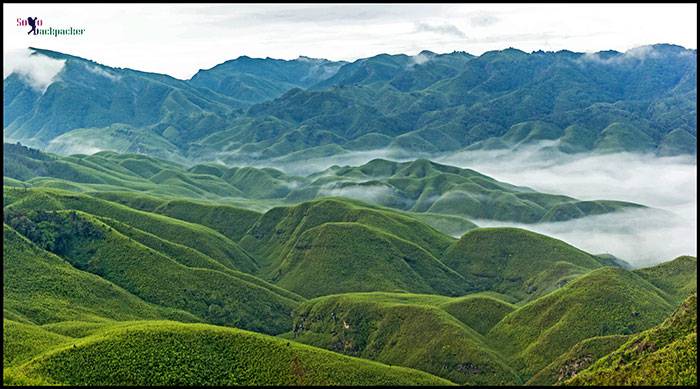
Surrounded by the mighty Japfu hill range and hidden by impenetrable forests of the wild Naga land, the trek offers a thrilling adventure– walking in the dense forests, traversing the raging rivers, meandering through the thick bamboo vegetation and living in an isolation away from the maddening crowd of a hectic urban life. Then comes the monsoon season in the month of July, when the wild flowers bloom in the valley. The hidden secret of North East India turned into a picture perfect paradise after the blooming of Dzuoku Lily and that’s why it is also perceived as the “Valley of Flowers of the North-East”.
Arrival in Kohima
Permit requirements for dzukou valley, trekking to the dzukou valley, trekking to the lower part of dzukou valley, return from dzukou valley, how to reach dzukou valley, entry fee for dzukou valley, accommodation in dzukou valley, is it possible to go solo in dzukou valley, mobile connectivity in dzukou valley.
I was desperate to explore the little paradise of North East India right from the beginning of my arrival in Guwahati, and finally decided to trek alone in the month of September. I departed from Guwahati by an overnight train to Dimapur and without any significant event reached there in the early morning.
The onward journey from Dimapur to Kohima by a shared car was an unforgettable experience. The road condition to Kohima is terribly bad, and there was only slush and mud due to the excessive rain. After 3 hours of a bumpy ride in a Maruti 800, I reached Kohima, a beautiful hill city with a ridiculously low volume of road traffic and peaceful environment. Later I realised that the low volume of traffic was because of the Sunday, the weekly holiday of the most people in Nagaland. A majority of Naga people follows Christianity, and they don’t work on the Sunday and go to the church three times in a day. Most of the shops remain shut, shared passenger vehicles don’t ply on the roads and the life comes to a standstill every Sunday.
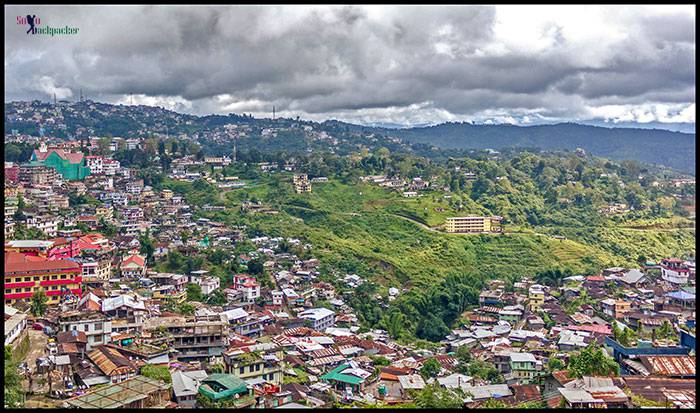
While there is no separate permit requirement to enter into the Dzukou Valley, an Inner Line Permit is required by all Indians except the residents of Nagaland to visit the state of Nagaland beyond Dimapur.
I was already having an Inner Line Permit issued in Guwahati, but in case, you reach there without a permit, you can get it from the DC office in Dimapur.
I arranged a hired vehicle somehow to drop me to Zakhama village, near the starting point of the trekking trail. I could have trekked via Vishwema Village, and it was actually a lot easier, but a hired vehicle to Vishwema village could have cost me much more. I decided to move on Dzukou Valley Trek via the Zakhama route to save a few hundred bucks.
I moved on a newly constructed unpaved road going upwards on the hill and kept asking for the precise direction from the people working in their fields. After crossing a minor river, I reached on the correct trail to the valley. During the rainy season, the river crossing could be a risky situation. Some signboards are placed at frequent intervals, but gradually they disappeared on the trail in the dense concentration of shrubs.
After a while, the vegetation grew so thick that I could not judge the trail under my feet. Imagine a situation, where you trek through the dense vegetation notorious for the poisonous snakes and you even don’t able to see the ground. I did encounter a snake, luckily on a visible trail and slightly away. Alone in a deep forest, I kept moving on the trail. Sometimes, the forest appeared so thick that it conveyed the feeling of a strange darkness in the surrounding.
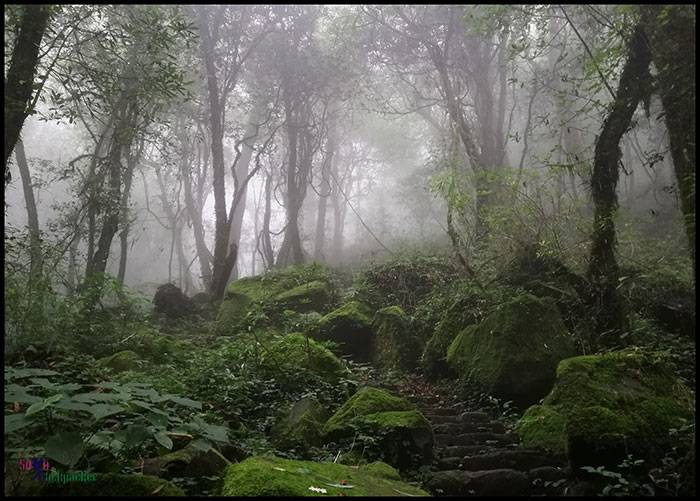
Slowly, the unpaved trail was replaced by stone boulders covered by the slippery green algae. During the dry season, the path is good to traverse with a trekking stick, but during the rain, it would be very slippery and one has to trek with extreme caution. A pair of good trekking shoes is compulsory on this trail. I met few local old women, rapidly descending on the trail through the forest without any trekking shoes, but they were the natives.
On many other trekking trails, we trek over the soil, so falling on the trail doesn’t cause any severe problem. But there on the trek to Dzukou Valley, most of the trail consists of rocks. A slight moment of carelessness can cause you to fall on the stones while breaking your feet, back, waist or something else. Therefore, it is not a pleasant experience to fall over the stones at all. A sturdy trekking shoe and a trekking stick are highly recommended on this trail.
Also Read: Trekking To Kheerganga in Himachal Pradesh- A Himalayan Heaven Of The Restless Souls
The deep forest of Dzukou Valley Trek posses many other challenges for a trekker. The other one is passing over the numerous water rivulets. When the river is dry, it is possible to navigate them without any hassle, but during the rain when they are supplied with high speed water running down from the top, it is extremely hazardous to pass over them. Few unfortunate trekkers have been swept away already in these rivulets. Due to the deposit of algae and moss, the boulders near the rivulets become very slippery. It required a lot of attention to trade them without getting hurt.
I continued moving cautiously through the lush forest for approximately 3 hours without the visible trace of a single soul. Sometimes, the enveloping clouds, impenetrable forest and profound darkness of the trail sacred me so much that kept wondering that why I was doing that. Why was I not going back? The trail is so scary in the deep forest for solo trekking. There was a potential threat of the rain due to the dense clouds over the forest. There was no proper place to find a shelter except under the trees. But luckily I had a rain jacket and a rain pant to adequately protect me from the rain.
After walking farther on the continuous trail, I fortunately found a big tin shed where four young boys were cooking something. They informed that there was around 25-30 visitors in the valley already, so there was no worry for decent shelter or proper food. That valuable news was a significant relief for me. I kept moving with renewed energy to reach at the guest house as soon as possible. Two more hours of walking and met two other boys descending through the forest. They informed that I was very closed to the valley, hardly 30 minutes of more climb was left.
I walked continuously for 15 more minutes. The sun rays were able to filter the canopy of the trees and suddenly the impenetrable darkness of the surrounding vanished with the glowing light. I looked beyond the forest and thought that I was about to reach on the top. The top edge of the pristine forest was a desired end of all suffering on that day. But, the ordeal wasn’t going over so soon.
I kept moving through the turns and twists of the forests for 30 more minutes before reaching the top edge of that deep forest. From the edge of the forest, I could see a magnificent widespread charm of Mother Nature spread in every direction in front of me. I imagined them as a green carpet of wild grasses from the distance, but a closer look revealed that they were the bamboo bushes adequately covering the entire stretch of the lovely valley. In some parts, the bushes were high enough to hide a young man, but the trekking trail is so well marked that there is hardly any chance to get lost there.
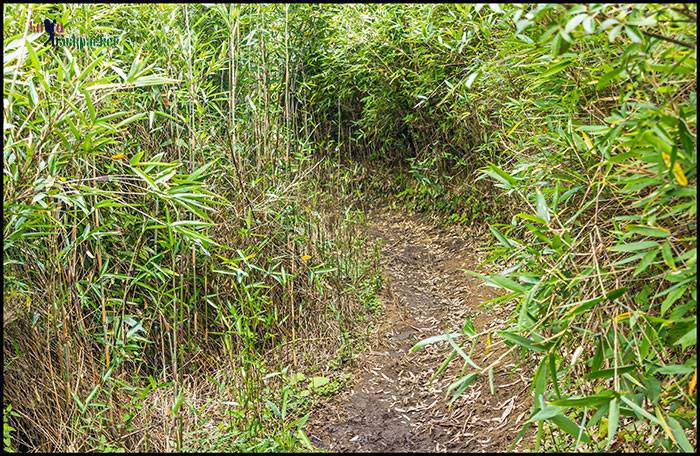
The trekking trail from the leading edge of the pristine forest of the guest house is almost flat through the bamboo bushes. As far as my eyes could see, the breathtaking views of the valley were a memorable experience. Slightly away from the marked trail, in one part of the valley, sun rays were falling gently on a limited portion after penetrating through the enveloping clouds creating a golden hue over the lush vegetation. What a view it was! It was hard to believe a landscape could be so magical. All the pain of a treacherous trek vanished instantly after seeing that breathtaking vista of nature.
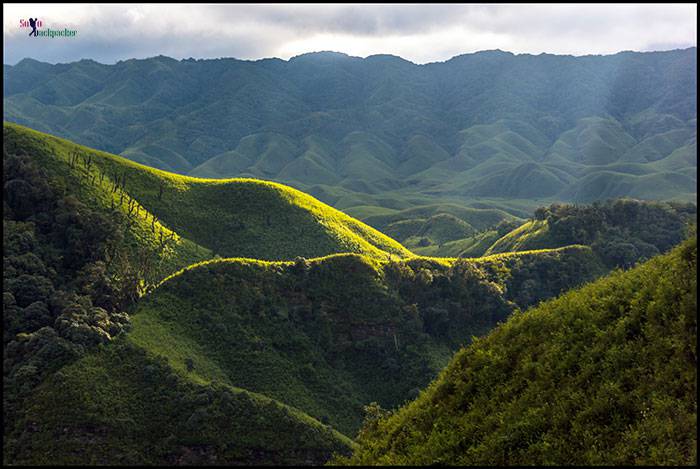
After waking for a few more minutes, I reached at the guest house, already buzzing with many young boys and girls. It was the late evening by the time I reached at that place, so there was nothing to do on that day except making few new friends and chit chatting with them.
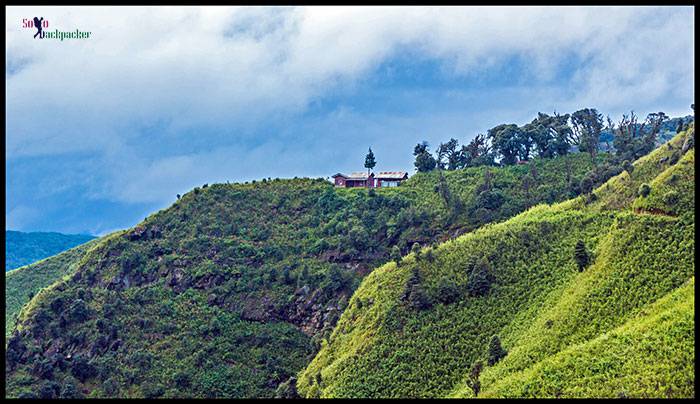
Next day, I moved ahead to explore the lower parts of the Dzukou Valley. From the guest house, a narrow path leads to the lower part of the lush valley. On the way, there is one small helipad. The helipad serves as a vantage point to click some beautiful photographs of the valley. During the rainy season, when Dzukou Lily blooms on the larger scale, the panoramic view of the valley looks beyond imagination.
I reached into the lower parts, that is covered by the wild flowers instead of the bamboo shrubs. I clicked some more pictures and walked all around the lower parts of the valley through the multi-coloured carpet of the beautiful flowers while crossing the narrow rivers filled with crystal clear water. In the month of September, the season of full bloomed Dzukou Lily had been over until then, but at few places small groups of other wild flowers were present, however.
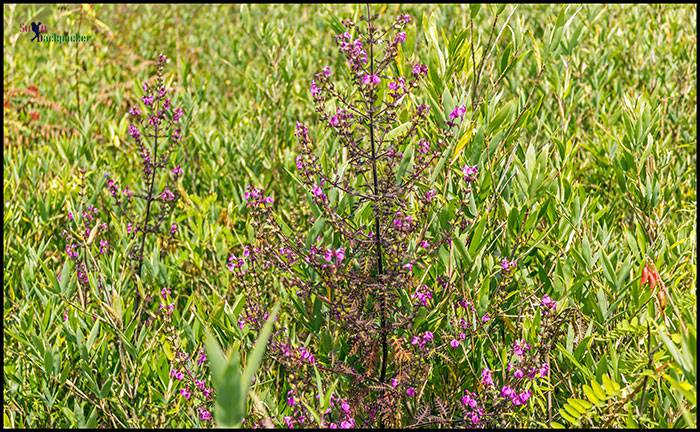
Earlier there used to be a wooden bridge on the narrow river flowing in through the valley. But, it was not there during my trip. The bridge was swept away, probably by floods. Water level in the river was low, so it was reasonably possible to cross the stream without the bridge. A Cross was visible on a distant hill, so I intended to reach there. But just below the grassy hill, the river stream was very deep and it was impossible to cross without getting wet. I promptly returned from that specific point.
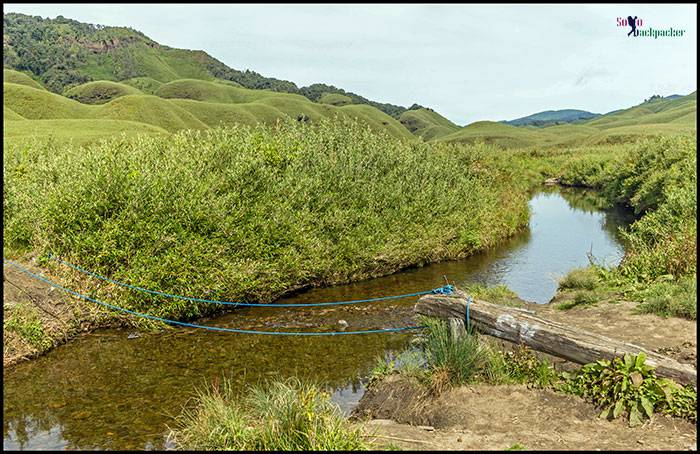
The lower part of the Dzukou valley contains a vast open ground for the camping. There is no fear of wild animals, so this part is ideally suitable for the night camping. If you carry your own tents, you can easily pitch there in the middle of that isolated paradise.
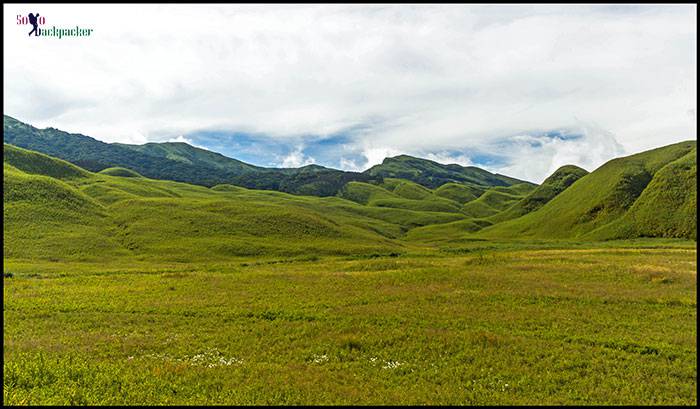
After devoting few hours in the valley, I returned to the guest house. All the fanfare at the guesthouse was already over by then. No one was there except the two caretakers. I also decided to return from the Dzukou valley, this time via Vishwema village route.
After walking for about 20-25 minutes on the same path as on the previous day, I comfortably reached at a tri-junction of three marked paths and found a signboard mentioning the Alternate Trek Route. The marked trail diverting to the left from that point is the one that goes towards Zakhama village, that I already trekked on the previous day. The trail towards the right from that point is the trail to Vishwema village, so I moved on to that path.
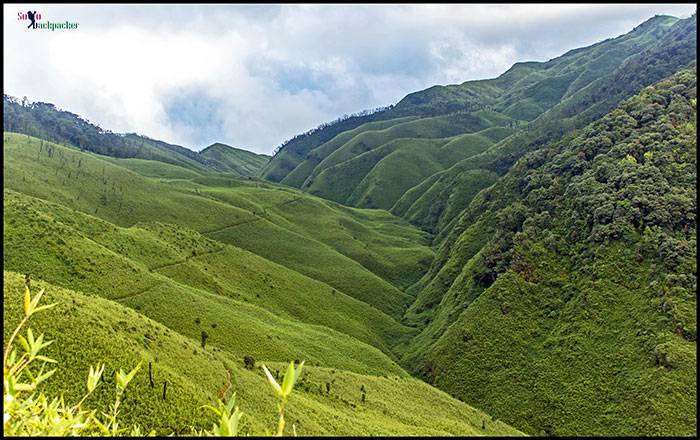
The trail is almost flat for two hours and completely covered with bamboo shrubs. At some points, the bamboo plants are so high and so dense that it is very easy to get lost. But, the trail is perfectly marked, and it is impossible to steer away from the correct path. At the faraway corner of the valley, breathtaking views await at every turn and twist of the trekking trail.
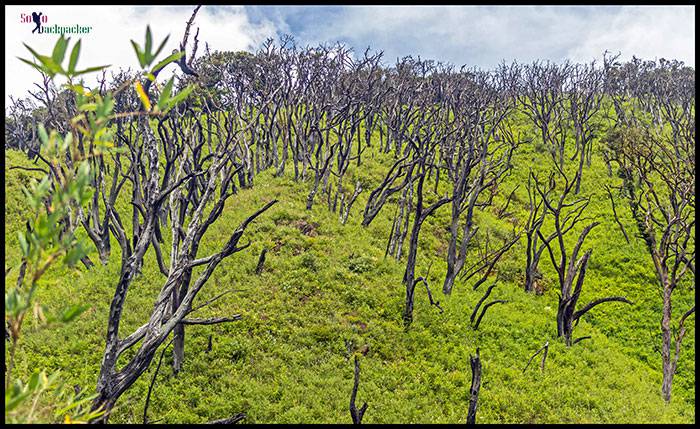
Next two hours was a pleasant walk on a flat terrain and at the end of the valley, I found a rugged trail going downwards into the deep forest. The next one hour walk was through that forest was moreover a tough ordeal, where I had to move carefully without falling down on the stones. Due to the recent rains, the path was very treacherous. I kept moving with utmost care until I reached to the lower end of the forest.
Another Trekking Experience: Trekking to Kedarnath Temple in Uttarakhand
The Dzukou Vally Trek was actually over by that time. Vishwema village was, however 8 kms away. There was no chance of getting a vehicle, so I walked on the unpaved road. The road was covered by long trees and full of water and slush. The view was so monotonous, there was no fun in the walking. Luckily, after 5 kms of walking, I found a pick van that was going towards Vishwema village. The local driver was kind enough to drop me at Vishwema village, from where I got a shared cab to Kohima.
The mesmerising Dzukou Valley is located at an altitude of approx 2438 meters near the border of Nagaland and Manipur in the North East India. It is merely 20-22 kms away from Kohima, the capital city of Nagaland. It is possible to trek in the valley from both the states, Nagaland as well as Manipur. The picturesque valley is best approached from Nagaland side, from the city of Kohima.
To reach Kohima from anywhere in India, one has to reach Dimapur first. Dimapur is considered as a key gateway to Nagaland. It is a major railhead and also served by an airport with two daily flights to Kolkata. Kohima is 75 kms away from Dimapur. The road condition from Dimapur to Kohima is significantly worse, and one has to be ready for one of the most bumpiest rides in his lifetime.
A shared sumo or car takes about 3 hours to cover the 70 km distance between Dimapur and Kohima. The shared vehicle may ask up to 400 Rupees per person, but bargaining is possible.
There are two proper ways to go to Dzukou Valley. The first preferred route starts from Zakhama village and the second from Vishwema village. A third route is also developed from Mao in Manipur, but I have very little information about this route.
Dzukou Valley From Zakhama Village: Zakhama is 16 kms away from Kohima. A shared jeep/sumo typically charges 50 rupees for half an hour journey from Kohima to Zakhama. The trail to Dzukou Valley is slightly ahead of Zakhama Village on the main road. Let the driver know in advance that you are trekking to Dzukou Valley, so that he can drop at the proper place.
If a shared vehicle is unavailable from Kohima, for example on Sunday, then it is possible to arrange a hired one by paying 450-500 Rupees. A signboard is installed there to indicate the path leading to Dzukou Valley. From the signboard, you have to trek through the deep forest for 5-hours and after that walk for 30-40 minutes in the valley to reach at the guest house, where you can stay in the night.
The trail from the Zakhama Village to the Dzukou valley is extremely steep, and the forest is significantly deeper. In the monsoon, it can be extremely challenging, very treacherous, and you have to cross fiercely flowing water streams. Most trekkers traditionally prefer this route for the return journey from Dzukou Valley.
Dzukou Valley From Vishwema Village: The another trail to Dzukou Valley starts from Vishwema village, approx 6 kms further on the main road from Zakhama village. A shared vehicle cost from Kohima to Vishwema village is 60 Rupees. Hired vehicle may charge up to 700 Rupees. A signboard is installed there to indicate the path leading to Dzukou Valley. From Vishwema Village, you have to walk for approx 8 kms on an unpaved road before the actual trekking trail starts through the forest.
This distance can be covered by a hired vehicle also, that may charge up to 800 rupees. The entire 8 kms stretch appears monotonous in landscape, so there is no fun walking on that road for 8 kms. After 8 kms, you have to trek for one hour on an extremely steep trail through the deep forest. After reaching to the edge of the valley, it is a pleasant 2 hour walk on a nearly flat path though the bamboo shrubs to arrive at the guest house. This trail is preferred by most of the trekkers for the onward journey to Dzukou Valley.
A Glimpse of Roopkund Trek in Uttarakhand: Trekking From Wan Village to Bedini Bugyal
While returning from the valley, the last shared sumo from Zakhama or Vishwema is available up to 0400-0430 PM. Plan accordingly. To be on the safe side, try to reach by 0300 PM.
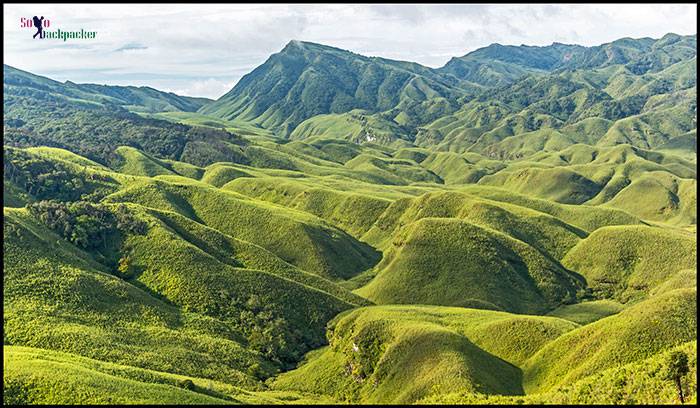
The entry fee for Dzukou Valley is 50 rupees, but there is no ticket counter to levy the entry fee. The caretaker at the guest house charges this fee with other charges related to the food and the accommodation.
During the tourist season, guest house facility is available in the valley for the night stay. Stay in the private rooms cost approx Rs 150. Two big halls are also there, that can be used as dormitories. A single hall can accommodate approx 50-60 people, but you have to sleep on the floor. Sleeping bags, mattresses, blankets, pillows are all available on the rent.
If you do not get any accommodation from the caretaker, then there are 2-3 rock shelters (like a cave) on the riverbank down in the valley from the guest house. But, it requires a lot of courage to stay in the open area in the middle of nowhere, and advisable only if you are in a group.
There are adequate arrangements in the valley for the night stay, but if you wish, you can carry your own tents also.
Yes, it is absolutely safe to trek alone in Dzukou Valley, but the conditions apply. As far as possible, do not trek Solo from Zakhama Route. The forest is really dense, and sometimes the trail is also confusing. If you have to do it, then take a local guide or try from Vishwema route. The best time to trek solo is during the Dzukou Valley Festival in the month of October, when there is a lot of possibilities to find someone on the trail.
Better to avoid trekking in the valley with the children under 10 years of age. If you have to go anyway, always go with a local guide who can help on the trails, especially if the weather gets worse suddenly in the dense forest.
I checked on Airtel, Vodafone and Reliance Jio Networks and there was no coverage at all. At few places on the trail, you may get the mobile signals, but they are very weak. Since, it’s a short duration trek, you can go to Dzukou Valley without losing contact with your family for a longer duration.
How Many Days Are Required for Dzukou Valley trek?
The trek can be easily completed in two days from Kohima, however one added day in the valley is advisable. Some people also complete it only in a single day starting early in the morning from Kohima and returning by evening.
Most Important Tip
This is North-Eastern part of India, so keep in mind that it can rain anytime. When it rains, it rains heavily.
The Dzukou Valley Trek is in fact a short expedition for 2-3 days only, but still there is plenty of adventure in this trek. After reaching the ultimate destination, the breathtaking views of Dzukou Valley are unmatched and unparalleled. It is also possible to add a few more days in the trip itinerary to properly cover the nearby Jafpu peak. Carefully add some village tours to the picturesque villages around Kohima, and you can undoubtedly enjoy a memorable trip in the mysterious land of the Nagas.
Related Posts
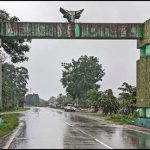
Please Share This Share this content
- Opens in a new window
This Post Has 2 Comments
Very Good information & nice write up
Thank You Sir.
Leave a Reply Cancel reply
UNCONVENTIONAL AND VIVID
LEARNING FROM THE WORLD
Dzukou Valley – A Complete Trekking Guide and its Ecosystem
by upsy · Published August 3, 2019 · Updated August 3, 2019
The undulating rolling hills of Dzukou Valley, sprinkled with colorful blooms, stretched with carpet of wild dwarf bamboo exemplify the best craftsmanship of nature. As the dawn swayed by, the silent murmurs of gentle breeze wrapped me in its invisible armor, the sky slowly turned into cobalt blue pushing away the clouds and the sun illuminated the valley in spectacular hues of green and golden.
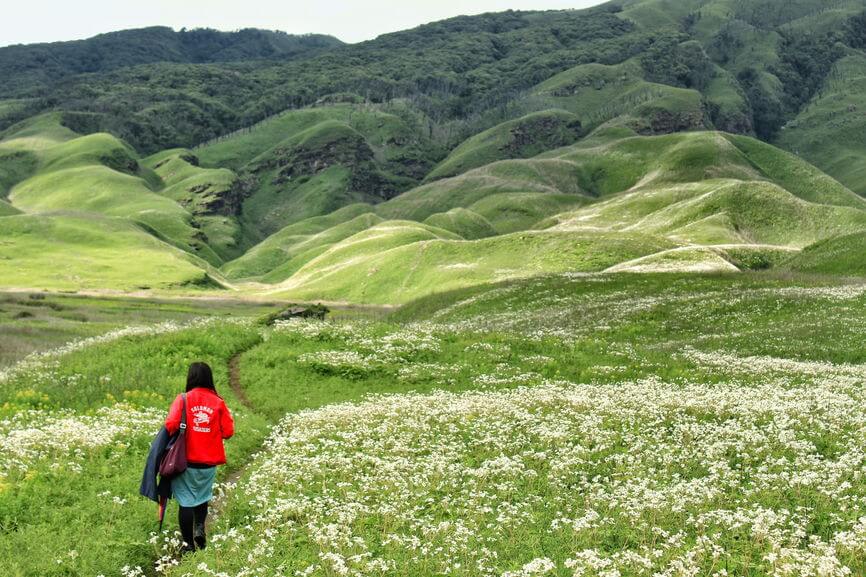
The burnt trees peppered through the valley, reminiscence of two huge forest fires, adds an esoteric element to the expansive vistas. In the misty and sloppy arms of monsoons, the rare Dzukou Lily ( Lilium Chitrangadae) makes it unparalleled appearance.
PIN THE POST FOR LATER
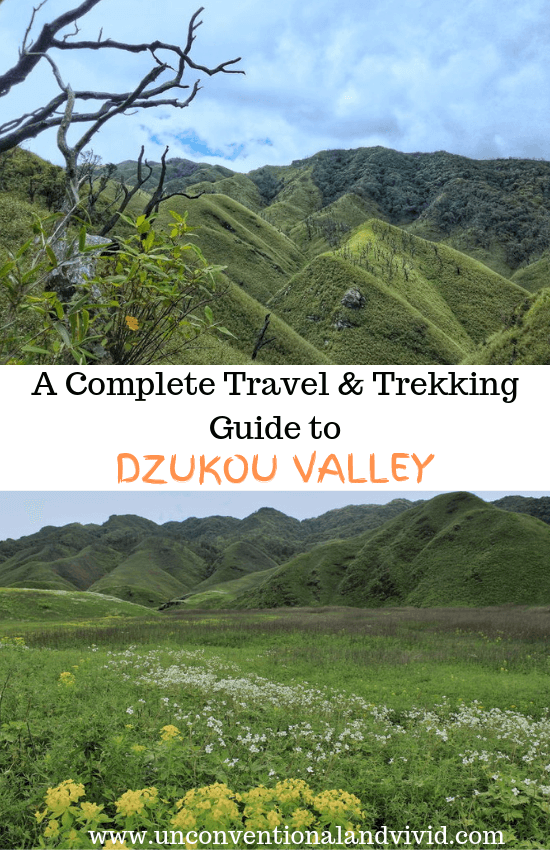
Table of Contents
Dzukou Valley – Where is it located?
At an altitude of 2,452 meters above sea level, the mesmerizing masterpiece of nature spans across the states of Nagaland and Manipur. The picturesque valley peeps above the clouds and open into velvety green treeless knolls, spread as far as eyes can take you. The summers paint a different picture with the valley blooming with colorful flowers but winters turn the valley into a frosty canvas without flowers. The timeless erosion and weathering of the rocks led to the formation of perfectly molded sweeps of hillocks and gave it its distinctive contours.
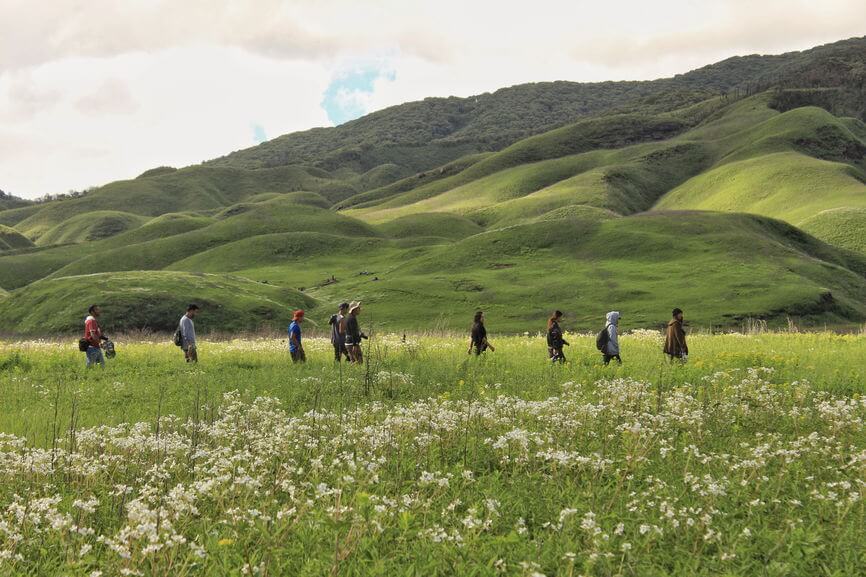
According to Angami dialect, the meaning of “Dzu – ko” means “soulless” and “dull” and this translates into this because of the rough weather conditions unfavorable for harvesting crops. According to legends, ancestors of Angami Tribe tried to establish a new village and settlement in the Dzukou Valley but failed due to the unfavorable weather condition that did not support farming and agriculture. It was considered to be not fit for habitation as it was too cold, nothing edible could grow and lacked trees. There are many myths and legends associated with the valley like existence of a white elephant, healing properties of the river and a place where the dead rest before departing.
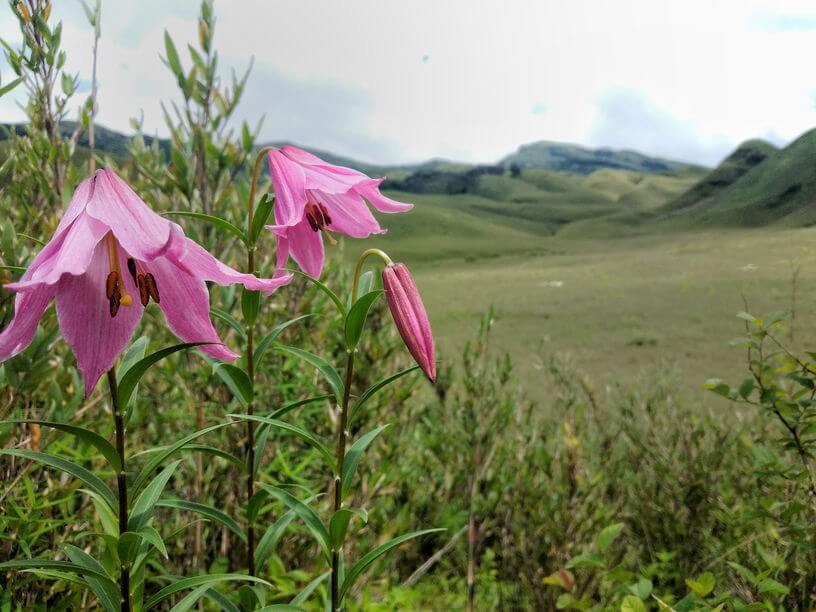
Ecosystem of Dzukou Valley
The ecosystem of the Dzukou Valley favors the growth of the rare Dzukou Lily ( Lilium Chitrangadae) from April to August. The endemic flower is a distant cousin of the lighter pinkish shade Shirui Lily ( Lilium Mackliniae ), a rare species of the Shirui Hills of Manipur. The Dzukou Lily was first identified in 1991 by Late Dr. Hijam Bikramjit, Life Sciences Department, Manipur University on his trek to Dzukou Valley with Manipur Cultural Integration Conference Team. Apart from the endemic variety of lily, many other flowers like Euphorbia sikkimensis , Ranunculus species, Aconitum species etc. adorn the valley in vivid bloom.
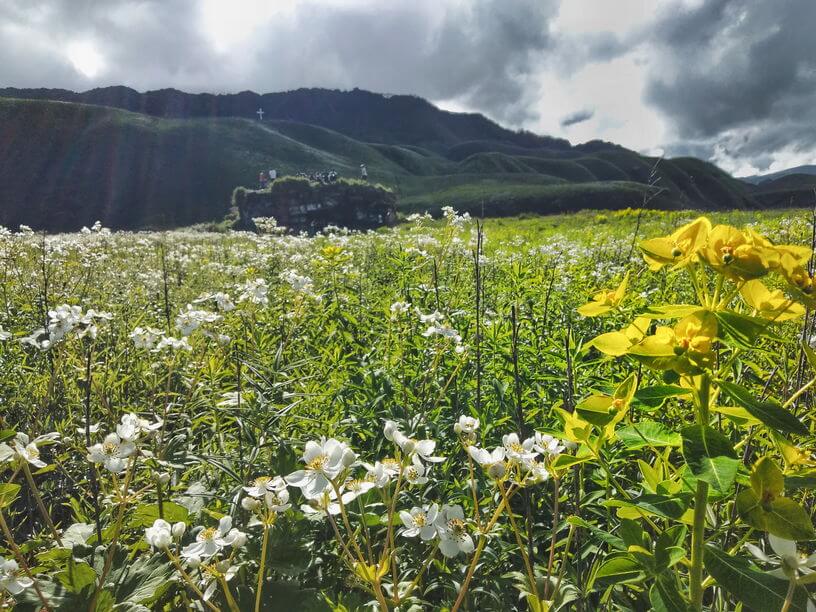
The seasonal flowers bloom during the monsoons and dot the valley in different colors spread across the carpet of dwarf bamboo. The bamboo plants dominate the valley and are known to have suppressed the growth of many other plant species. The endangered Blyth’s Tragopan, also the state bird of Nagaland, is known to silently habitat the woods beyond the valley. The ecosystem of the valley has drastically changed over the years caused by two wildfires in 2012 and 2015.
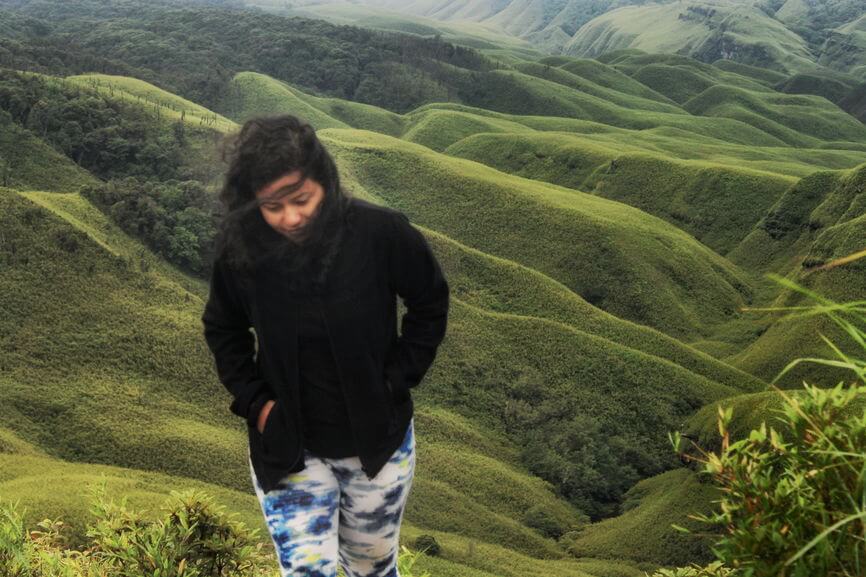
Management of the Valley by SAYO
SAYO stands for Southern Angami Youth Organization, currently managing Dzukou Valley and the guesthouse around the base. Right from providing meals to helping groups find a space for cooking to renting camping essentials, they care of everything. SAYO also banned camping in the valley which is a great move to preserve the essence of the valley.
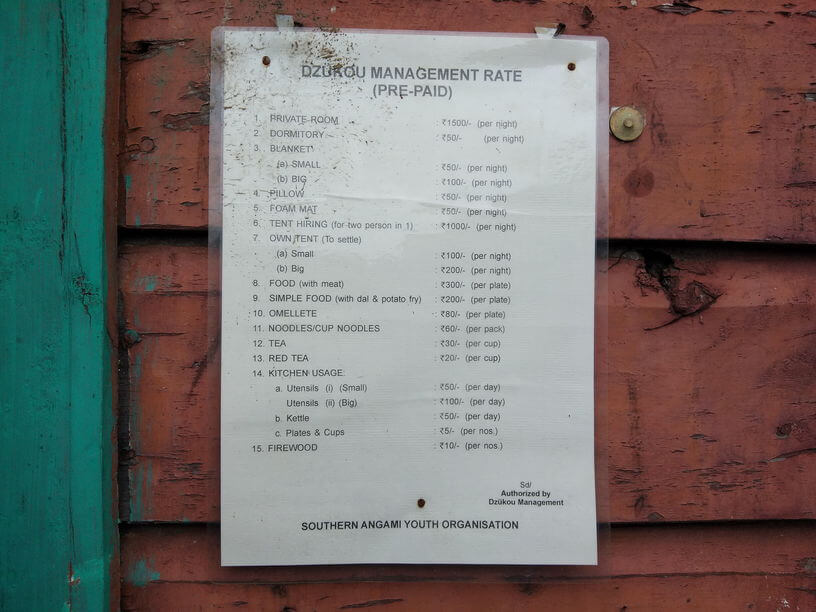
Recently, SAYO also declared the valley as no-plastic zone in a bid to preserve and protect the environment, still fighting with the menace existing plastic has already created. As stated by Mr. Zakieleto Tsukru, President of SAYO, the two major Southern Dzukou entry points, Visvema and Zakhama, will be monitored for implementation of plastic ban. The rates for entry to the valley, renting of things like blankets, mattress, utensils etc., firewood, food, camping, accommodation etc. is all decided and fixed by SAYO.
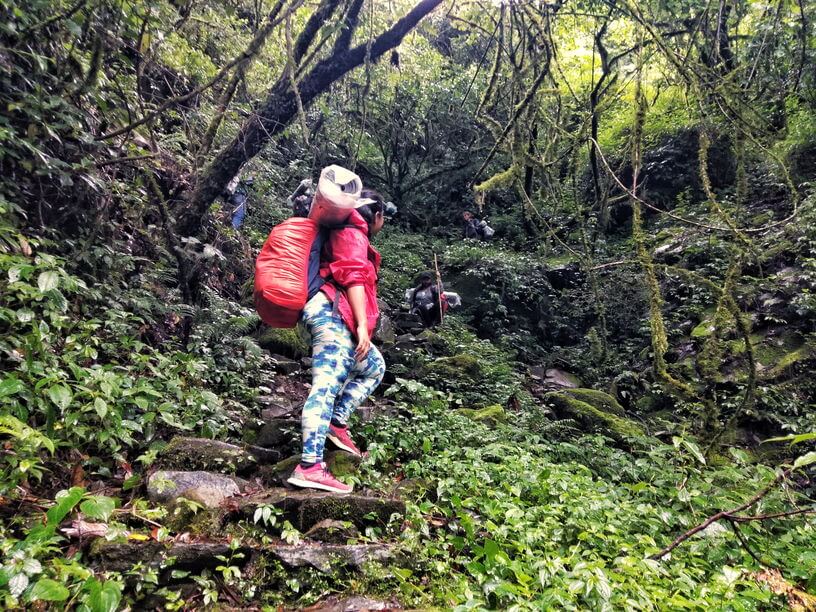
Exploring –Things to Do in Dzukou Valley
The immaculate valley is laid in contours of treeless gentle mounds covered in dwarf grasses, some places dotted with burnt trees standing as reminder of the devastating wildfire. The candy clouds float below the valley at the break of dawn, slowly clearing to make way for the rays of sun, casting a golden hue on the valley.
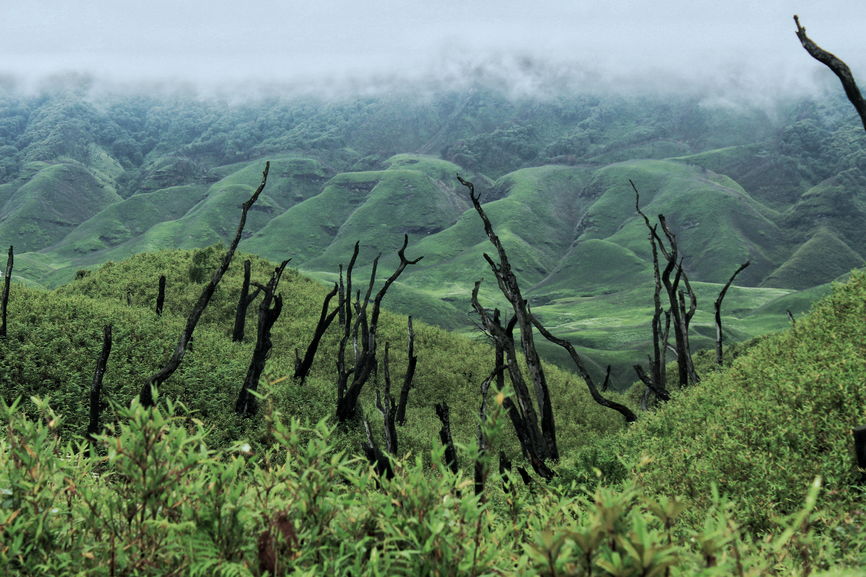
On a perfect sunny day, the valley shines in different shades of green overlooked by the clear blue skies. The winding rivulet flow through the valley with crystal clear water snaking along, perennial waterfalls are tucked in forbidden corners, deep cut ravines and caves, all are perfectly sculpted by nature.
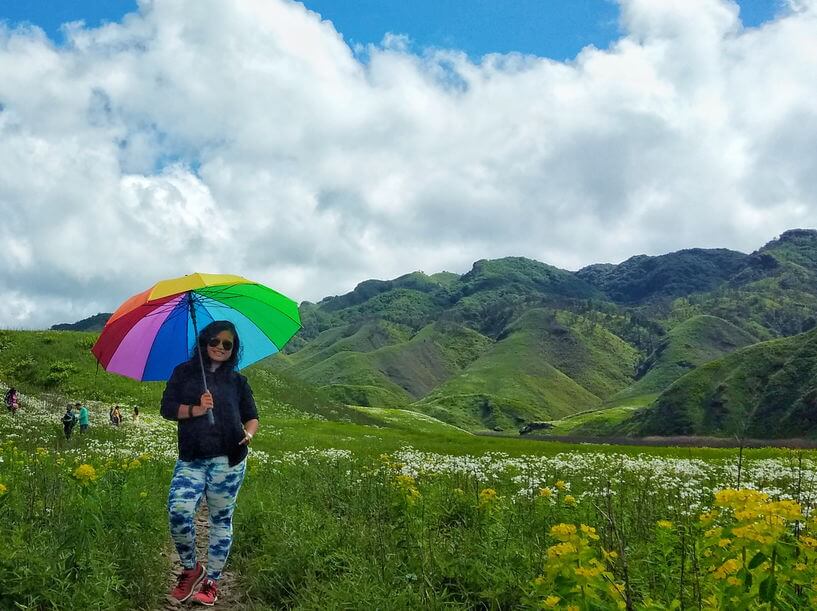
Trek to Bottom of the Valley
The spectacular vista of the valley from the guesthouse located on top of the valley is magical but a trek down the valley open into more spectra of nature. As you climb down, witness the colorful valley sprinkled in flowers, spot the rare Dzukou valley and make all the way up to the huge cross, transcending the flat terrains. The flat land of the valley is surrounded 360° by the rolling hills.
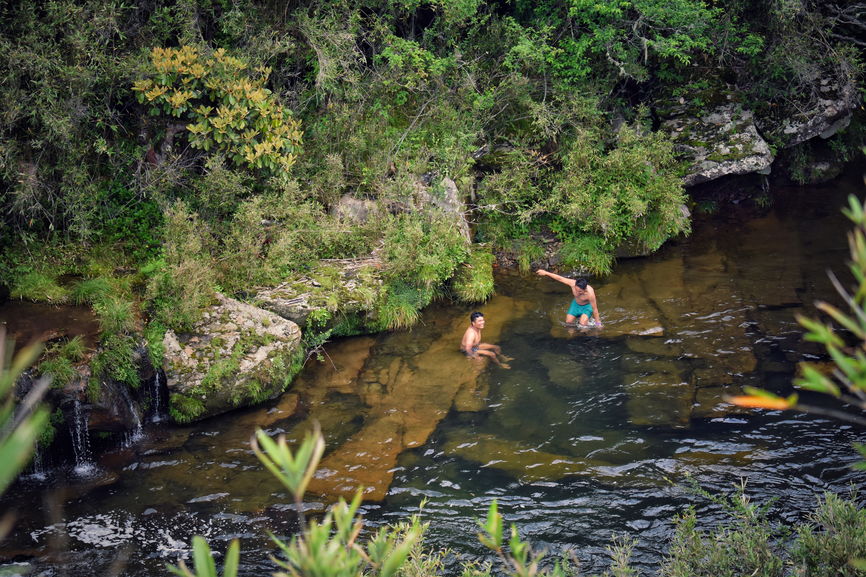
Take a dip in the crystal clear rivulet
The crystal clear rivulet meanders through the valley and becomes shallow towards the centre. It gently flows through rock formations and crevasses tucked in the valley shaping into natural pools. As they run across the valley, the stream takes many forms starting from rivulet to waterfall to water pools. Take a dip and refresh your journey in the valley.
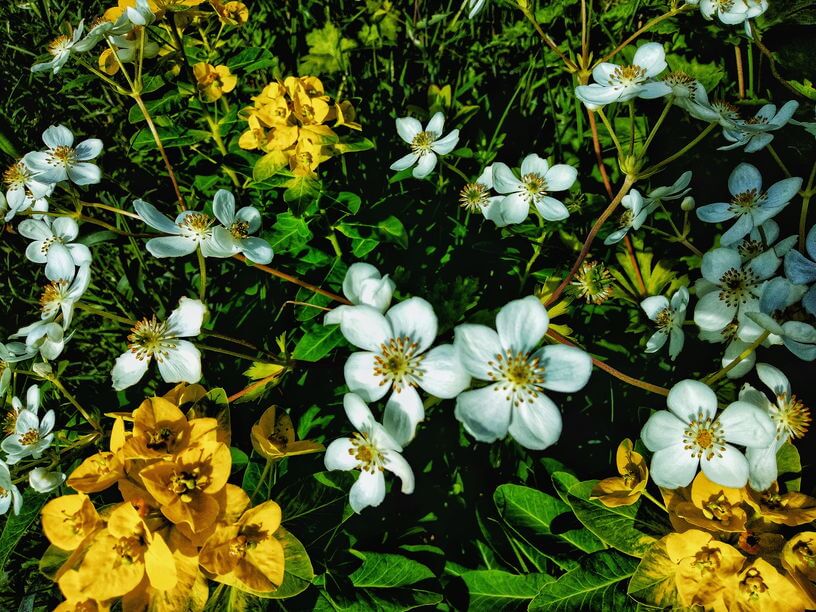
Enjoy the colorful riot of flowers
To witness the valley in full bloom, make sure you visit between the months of May to August, June being the best. Dzukou Valley stands remarkably vivid with blooms in white and yellow, occasionally dotted with blue flowers. The rare Dzukou lily makes its appearance across the valley in sparse location painting the green canvas with sprinkle of pink. With such gorgeous blooms, it is rightly named as “Valley of Flowers in Northeast”.
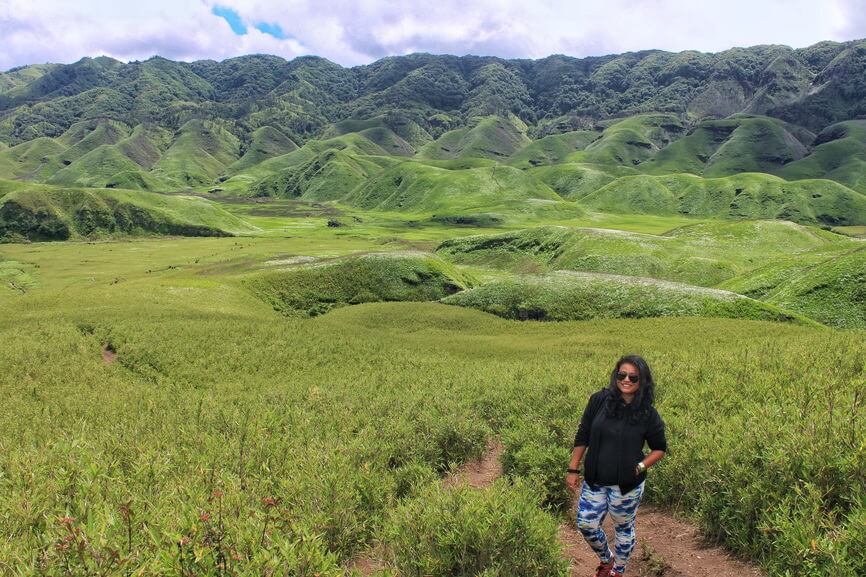
Explore the century old caves
The age old caves sheltered a lot of trekkers and explorers back in days when the valley was a remote dream, a celestial hidden existence. The years of weathering formed these caves and are pretty interesting phenomenon to explore. Some caves are small and right in middle of the bottom of the valley and some are tucked secretly in the lap of the woodlands.
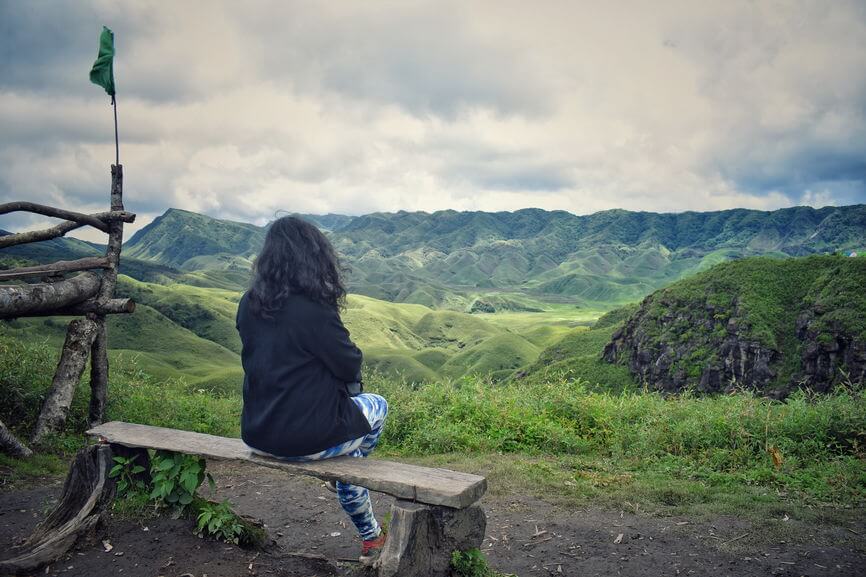
Soak into the celestial beauty of the valley
One of the best things you can do in Dzukou Valley is absolutely do nothing and surrender to the beauty of the moment. Sit and admire the valley, rejoice the air around, live in the moment and get surprised again and again witnessing the round hillocks. From the guesthouse, get a spectacular view of the valley while sipping a cup of coffee or tea.
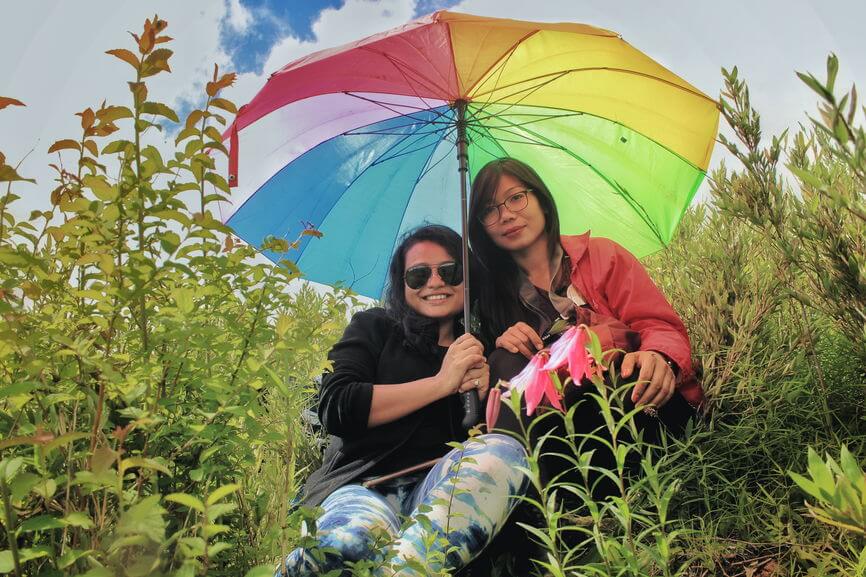
How to reach Dzukou Valley?
Since Dzukou Valley is spanned along Nagaland and Manipur, it can be attempted from either ways but Manipur trail is not marked, quite a strenuous one and needs expertise in mountaineering. Dzukou Valley from Nagaland can be attempted from Southern or Western Dzukou Valley side. The Southern Dzukou Valley trail starts from Zakhama and Visvema Village and for western, it starts from Khonoma Village.
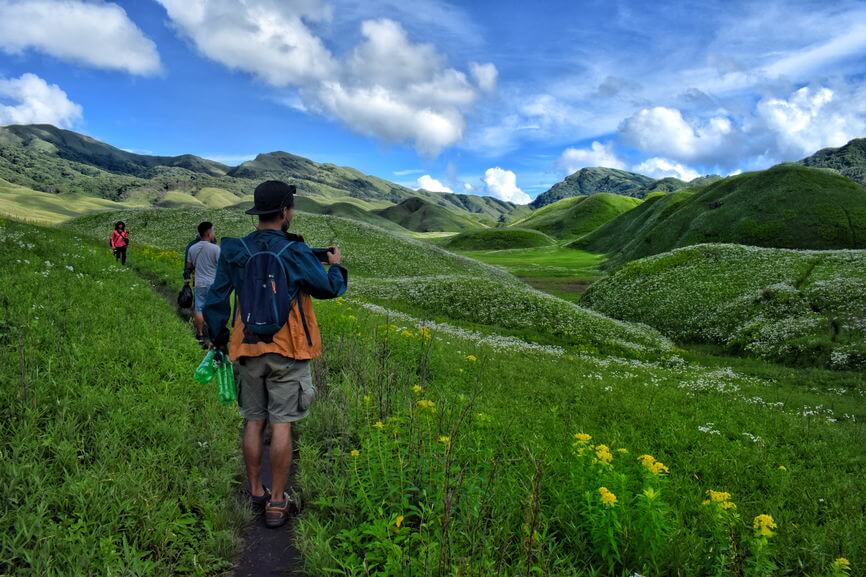
The Southern route is the easiest and maximum attempted with Visvema trail being easiest, more convenient and easily accessible. If you intent to visit Dzukou Valley via Zakhama, be prepared for steep climb of around 4 to 5 hours and 1 or 2 hours of flat land walk. It is not advisable to take Zakhama route during monsoons. Read more about trekking to Dzukou Valley via Zakhama .
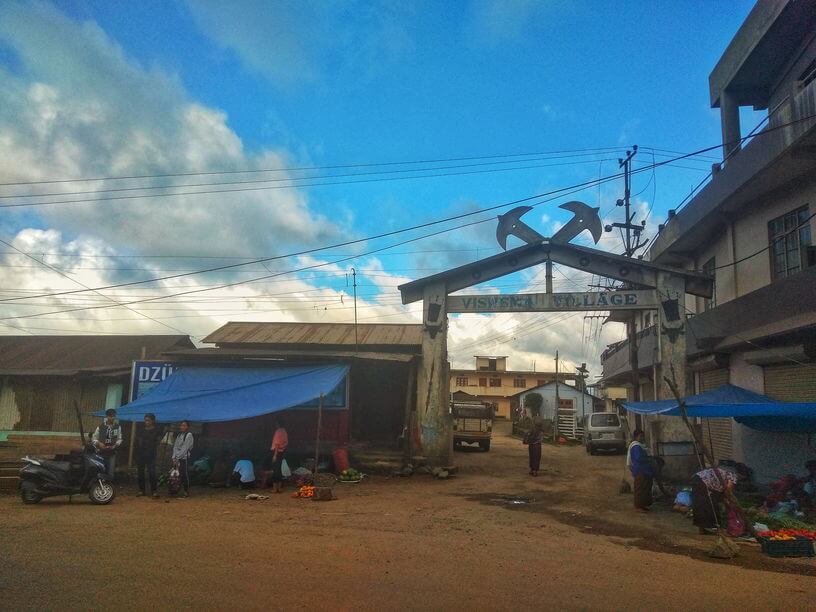
Visvema Route
The Visvema village is the most common base for Southern Dzukou Valley. It is mandatory since June, 2019 to register your name before starting the trek in the registration office. The office is located on left side of the main road, opposite to base of Visvema trail, as you drive from Kohima. The Visvema route of Dzukou Valley goes up towards right from the main road and is motorable till 5 to 7 kms (roads are in very bad condition), beyond which the actual trekking starts on foot. Here are the ways you can reach the base of the Visvema Trail
- If you are planning to do it on your own and in budget, take a shared cab from BOC counter in Kohima and get down at Visvema village. You can either chose to walk all the way up through the motorable road or hitch a ride.
- Second and expensive option is if you have a group of friends; hire a cab that will drop you till the end of the motorable road in Visvema. The same cab will also come and pick you up after you climb down but the both side fare is around Rs 5000/-.
- The last option is join a travel company like Sangai Moonlight Camping where everything is arranged by them as part of the package.
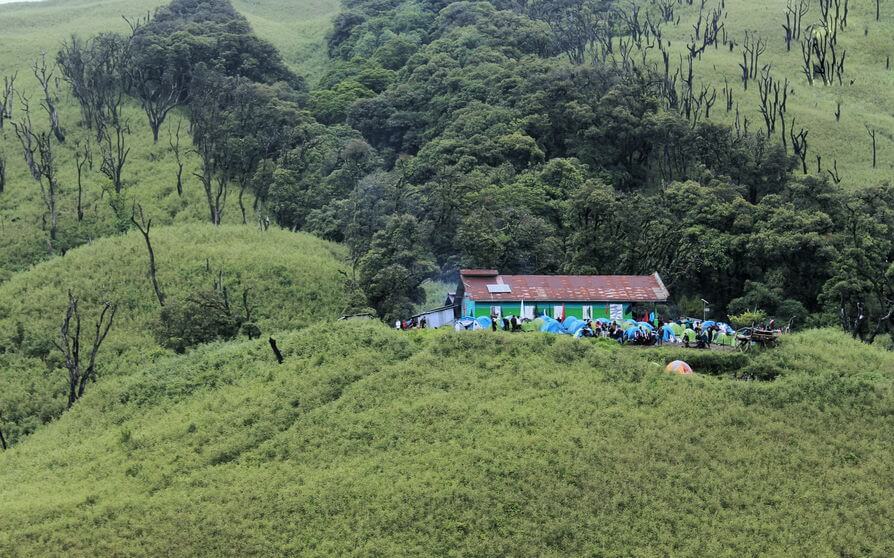
Accommodation – Where to Stay in Dzukou?
Depending on the availability, there are private rooms with very basic amenities at an exorbitant price of Rs 1500/-. However, it is limited to only few rooms and is give first come first basis. Next option is inside the guesthouse that doubles up as dormitory, the foam mattress and blanket can be rented from the management. Also, one can use their own sleeping bag. The last option is camping in tents in designated area. Camping at the base of the valley is not permitted and there is a nominal fee for camping space.
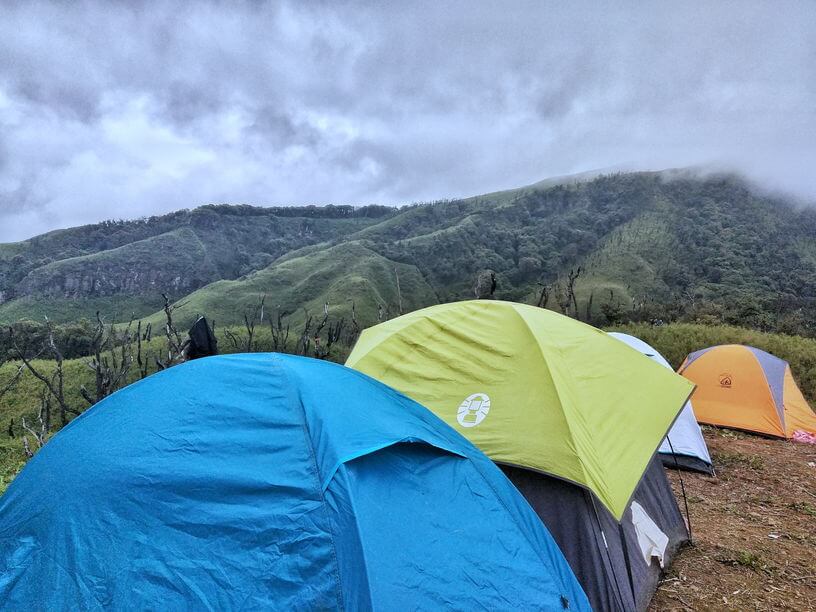
Best time to Visit Dzukou
- April – August – This is the best time if you wish to witness the valley sprinkled with colorful flower blooms. Also, this is the time when the rare Dzukou Valley blooms and lightens up the masterpiece of nature.
- September – November – The valley starts to lose the flowers but it is still green and comparatively dry.
- December – March – The winters cast a different charm as the frost wraps the valley in white during the wee hours of the morning.
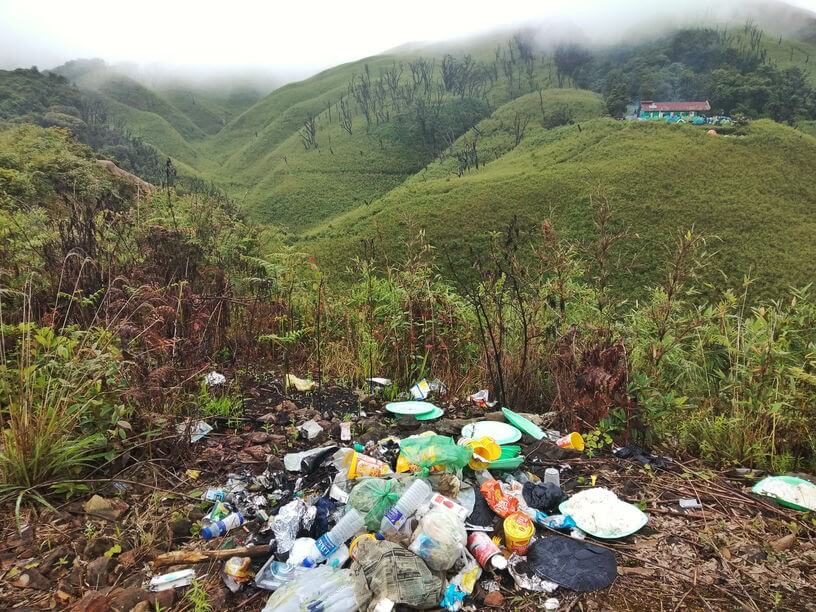
Impact of Over-tourism in the Valley
Awe-inspiring, spectacular and an absolute delight for our ravenous soul – Dzukou Valley bestow to the searching eyes an unconventional paradise, away from the chaos of the morning horns and incessant noise. It stands there silently welcoming every tourist, every bucket list tickers and one picture for social media fanatics. But, the burden of unchecked tourism and camping, the plastics left behind by people and the tons of food waste – The valley is slowly drowning with the eco-system being heavily compromised.
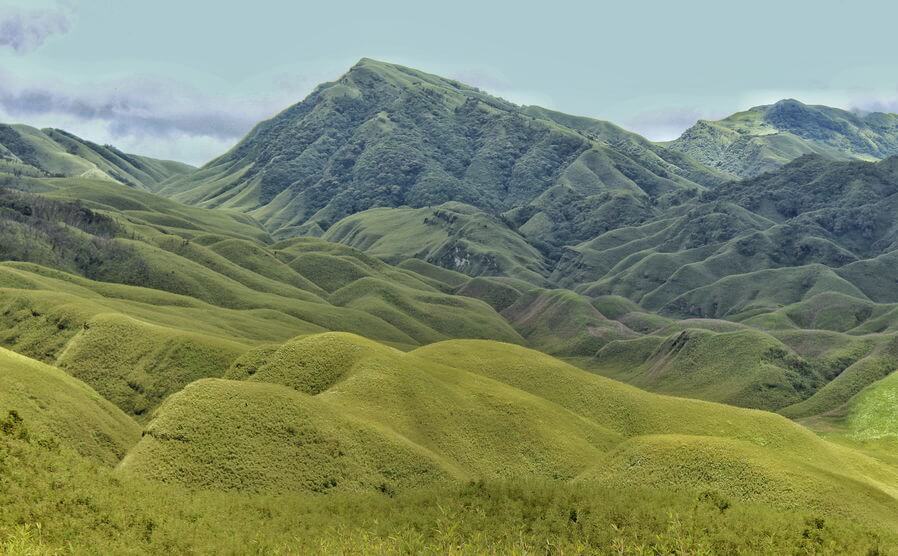
This was my second time in Dzukou Valley while the first was in 2016; it was and still is pristine except, the base of the valley is now hoarded with hundreds of campers. Loud music blares through the speakers suppressing the sound of the gurgling stream. Billow of smoke penetrates mercilessly in the atmosphere from bonfires, introducing pollution in the valley that once breathed in peace and pure air. Oh! The plastic waste buried under the ground, on the surface, in the valley, and around the camping area in the base is getting alarmingly high despite Dzukou Valley declared as plastic free zone.
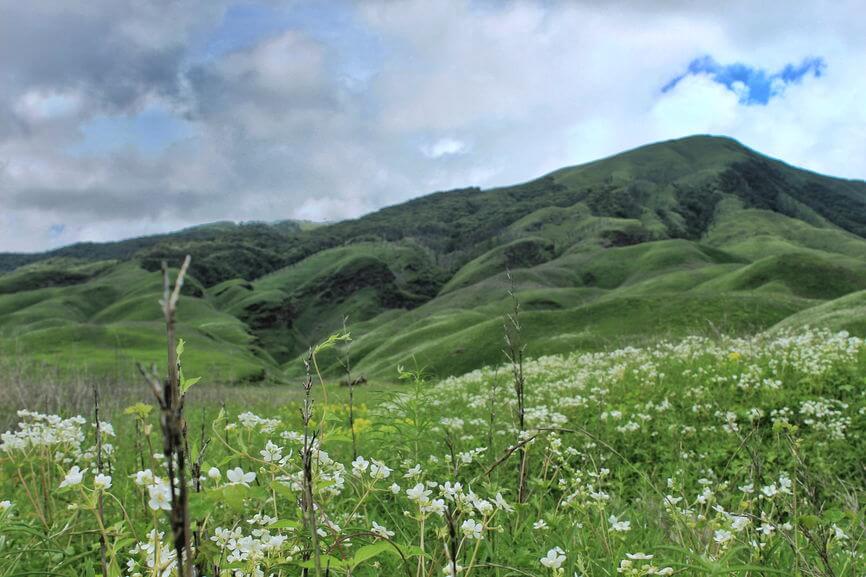
The eco-system has undergone a lot of changes for the valley is not ready to carry the burden of so many people. This year the flowering season arrived a month earlier which might be due to fluctuation in climatic change or shift in the ecosystem. With the increasing food waste dumping out in the open, there is high chance of increasing pest manifestation and introduction of invasive species posing threat for the native fauna. Looking at the bigger picture, if tourism is not checked, the beauty of the valley might become history impacting the wide expanse of flora and fauna.
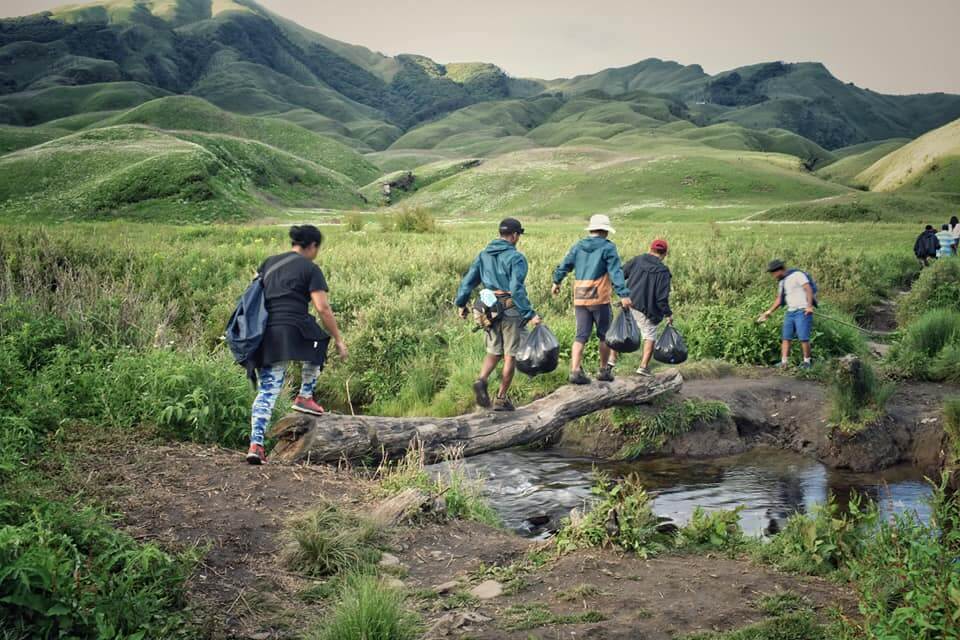
How to maintain the Eco-system of Dzukou Valley?
The picturesque valley is at the peak of its tourism and likely to increase over the coming years. Meanwhile, the viral pictures double up as an opportunity for a lot of people to pocket in money without contributing to the well being of the valley. Few years back, there was not a single tour company organizing trips but with a span of 2 years, the solitude of the desolate valley changed into easily accessible chaos. But, it is never too late and here is what we can do to help the valley revive
CLEAN UP DRIVE WITH TEAM OF SANGAI MOONLIGHT CAMPING
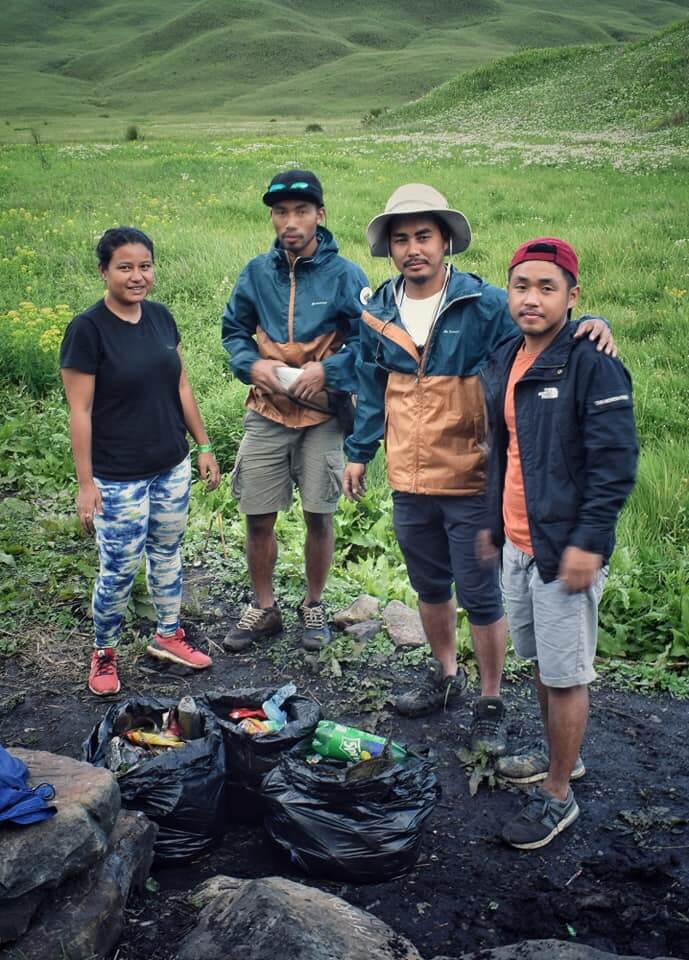
- The management (S.A.Y.O) and Nagaland Tourism must put a capping at number of visitors allowed per day. The restriction will make Dzukou Valley exclusive and will reduce burden on the valley.
- The camping must be allowed only in designated area (which is implied already) and it must be made mandatory for the campers to clean up their area before leaving.
- The travel organizers or tour groups must limit the number of tourists with them. The tour organizers must play their part in organizing clean drive.
- The kitchen space used by campers and tour organizers must be cleaned after use and all the waste material should be compulsorily taken back.
- The food wastage must be minimized and the waste dumping must be done in a pit or closed system to avoid pests and invasive species from posing threat.
- Although Dzukou Valley is declared plastic free zone but the copious amount of plastic everywhere is disturbing. The plastic usage must be better managed; trekkers and tour organizers must be prohibited from carrying plastic.
- Bonfires must be limited so that minimum smoke penetrates into the environment. The smoke and ash increases the pollution and hazardous to health.
- Allow one day every day to heal by prohibiting visitors and closing the entry to the valley. This will give the valley some rest it deserves.
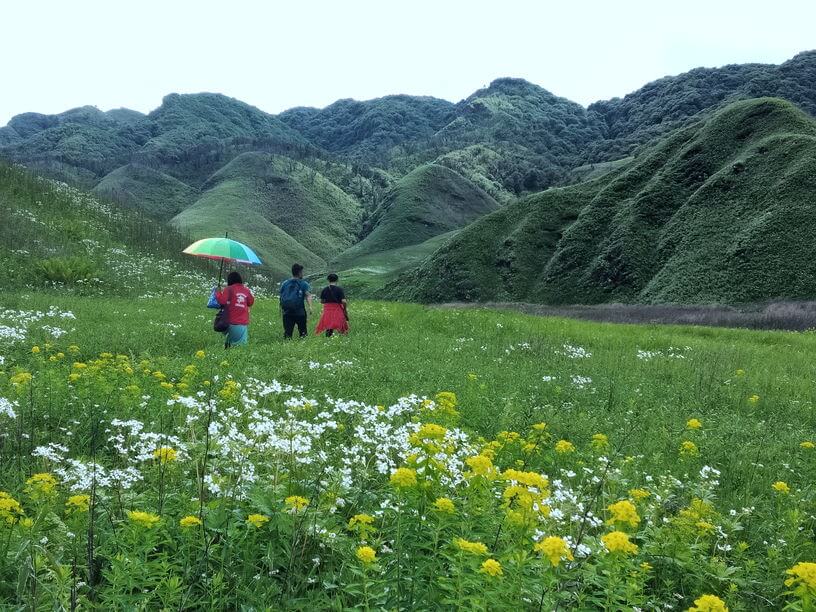
Explore Dzukou Valley with Sangai Moonlight Camping
Sangai Moonlight Camping is a household name in travel and tourism in Manipur with their eco-tourism initiatives and constant war against plastic. I have stayed at their gorgeous Loktak Aquamarine Homestay on Loktak Lake and visited the very remote Kwatha Village along Indo-Myanmar border. My experience with them even this time was great for all the right reasons:-

- Organizing a clean-up drive and continuing their war against plastic. We managed to collect a lot of thrash and buried plastic from the valley.
- Never failed to greet anyone with a smile despite being tired with all the cooking, cleaning and camping set up.
- The team single handedly prepared meals – lunch and dinner for all their guests, irrespective of the smoke burning the eyes in the kitchen area.
- Once the camping was over, the team ensured that the camping area and kitchen was neat and clean, all the waste was collected and brought back.
- You get professional photographs clicked by them and once the trip is over, they send the pictures after editing.
- The team walked us into hidden corners of the valley and into secret ravines tucked in the woodlands.
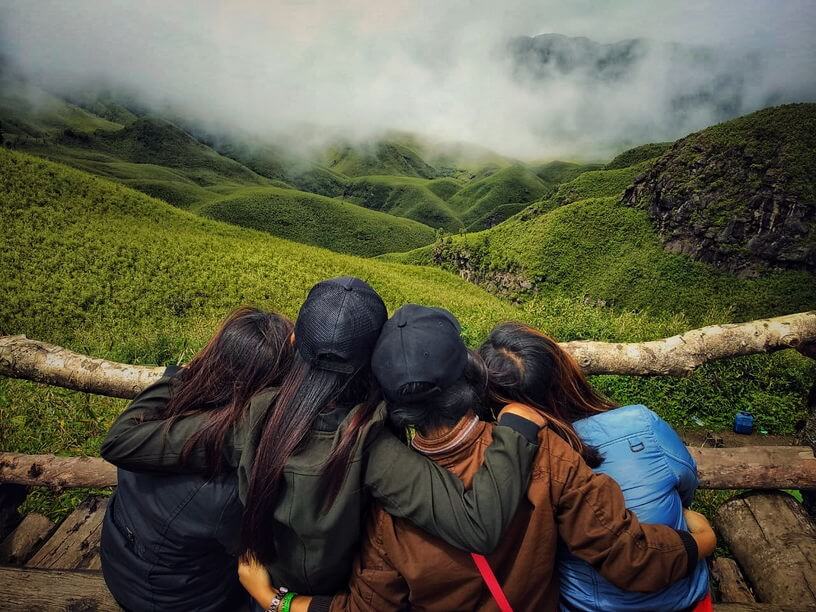
In short, I had an amazing time with the team. It was fun spending time in kitchen, helping them in the chores and listening to Manipuri music. However, due to the experiential tourism initiative and prominent presence in Manipur, the trekking groups with Sangai Moonlight Camping are huge and at times it becomes chaotic with so many people around. So, if you don’t prefer such huge groups, you may contact them directly and they will help you organized a customized trek to Dzukou valley alone or with limited people. You can reach them at – 08014921286 (Ashok Sapamcha).
IF YOU LOVED THE BLOG, PIN THE POST TO READ LATER
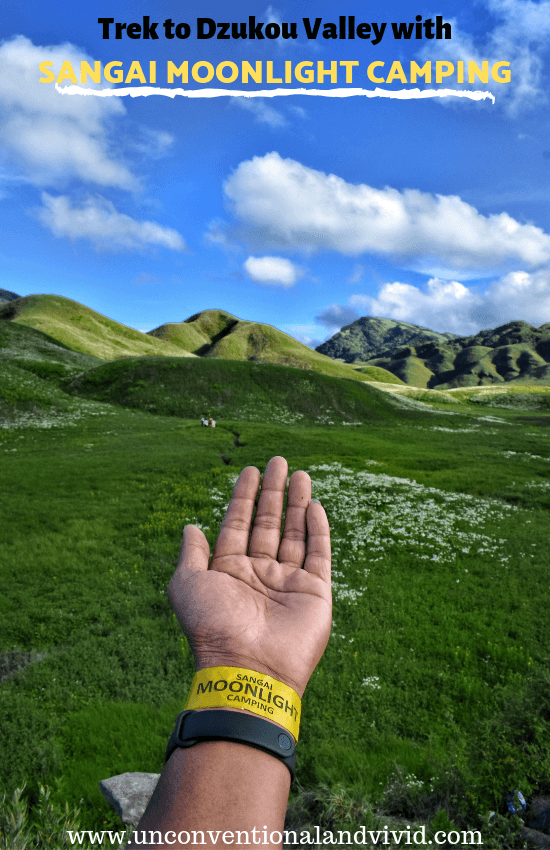
Share on Social Media:

- Share on Tumblr
Tags: Accommodation in Dzukou Valley Dzukou Valley Dzukou valley trek how to reach dzukou valley Offbeat places in Nagaland
You may also like...
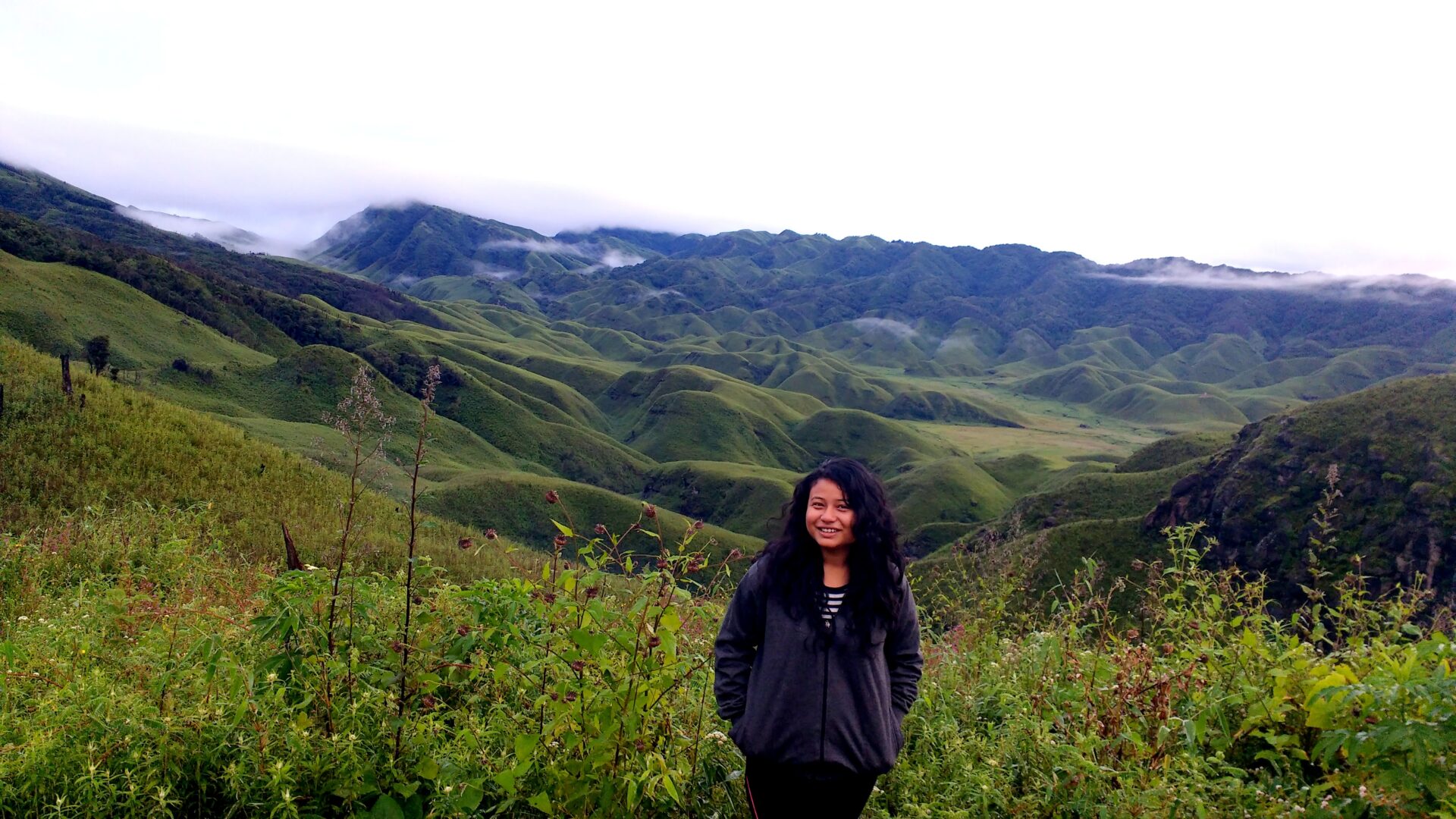
OFFBEAT TERRAINS OF DZUKOU VALLEY, NAGALAND
August 16, 2016
by upsy · Published August 16, 2016 · Last modified March 29, 2018
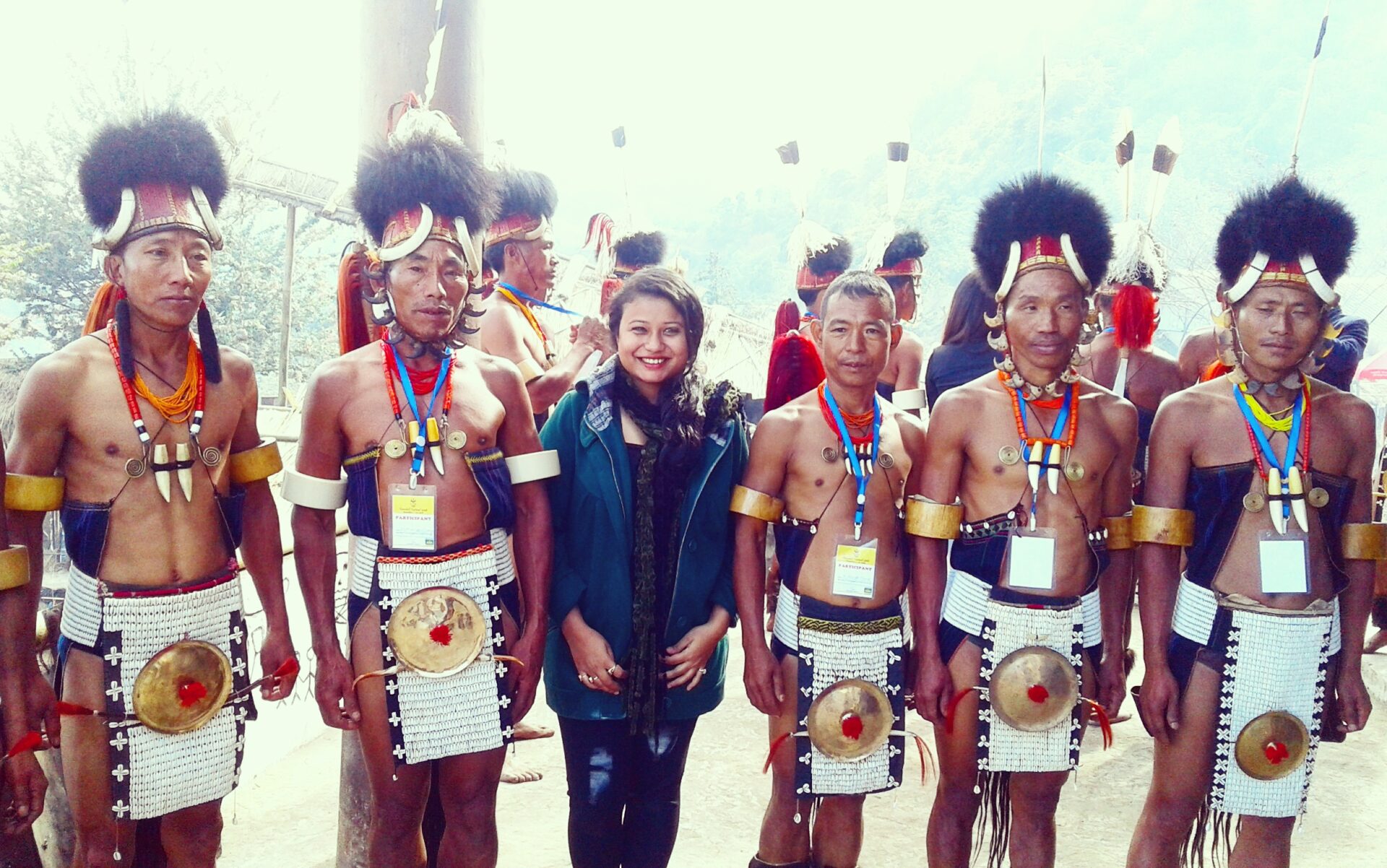
GLIMPSE OF HORNBILL FESTIVAL 2016
December 5, 2016
by upsy · Published December 5, 2016 · Last modified February 17, 2017
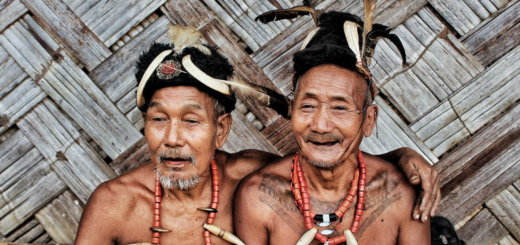
Meet the surviving headhunters of Nagaland in Longwa & Hongphoi
September 14, 2019
by upsy · Published September 14, 2019 · Last modified September 19, 2020
2 Responses
- Pingbacks 2
[…] Read the complete blog on Dzukou Valley […]
[…] rolling hills sprinkled with yellow and white blooms stretched along with the stunning vistas of DzukouValley is occasionally dotted with pink Dzukou lilies. As the sun cast its first rays, the valley change […]
Leave a Reply Cancel reply
- Next story A Comprehensive Kohima Travel Guide
- Previous story Dzuleke Ecotourism – Travel Offbeat and Rural Nagaland
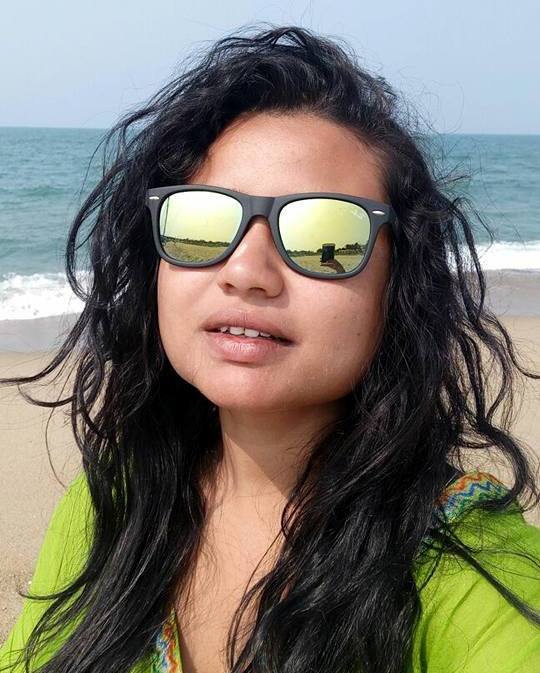
I am Upasana Kakati. I am an avid traveler, teacher, travel blogger and dreamer. I love uncovering hidden gems and exploring places that offer cultural and perspective per se. I am from North East India and currently making my way to offbeat destinations in North-East and rest of the country. I started this travel blog to pursue my passion for writing, keep the side hustle on and share my travel experiences. As of now I do not have any plans to quit my job to travel full time because I love financial security to a point. But, no one knows what tomorrow has in store.
Never miss a travel story – Subscribe
Email address:
Leave this field empty if you’re human:
Follow on Facebook
Choose Trek
Customise Trek
Suggest me a trek
Rent a gear
Volunteer Program
Blogs & Articles
Discounts & Offers
Dzukou Valley Trek (Kohima, Nagaland)
Dzukou Valley is a valley located at the border of the Indian states of Nagaland and Manipur. Its a spectacular visual treat of emerald green hills, lush forests, serpentine streams and myriad colourful flowers that dot the vast plain valley and its meadows. It is popularly known as “Valley of Flowers of the North-East” . It is situated at an altitude of 2438 m above sea level, behind the Japfü Peak located in Nagaland. This interesting valley looks like a mown lawn from a distance and is watered by two meandering streams viz Dzukou river and the Japfu river which often freezes in winter. This entire valley is adorned with lilies, aconitum, euphorbia and multi-coloured rhododendrons. They envelope the valley floor like a carpet so much that there are times when you can’t see the valley at all.
THE BEGINNING (Kohima to Viswema Village, base for Dzukou Valley):-

Kohima, the capital city of Nagaland is 74 Kms from Dimapur, the nearest rail head for reaching Dzukou Valley. From Kohima, one can hire a shared sumo (operating from the BOC point/counter) to Viswema Village. Viswema Village is about 25 Kms from Kohima. The shared sumo service also operates between Kohima and Zakhma. Zakhma is another base for the Dzukou Valley. Zakhma is about 20 Kms from Kohima. The ideal time to visit Dzukou Valley is from the month of June to September. It is at this time that the valley is carpeted with various stunning and vibrant flowers.
THE FIRST STEPS (From Viswema Village to the end of motorable road):-

The trek route starting from Viswema Village is strewn with pebbles in the beginning and gradually unfolds to give a glimpse of the breathtaking view of the surrounding hills as one gains altitude. The 8 km motorable road is covered on both sides by variety of sub tropical evergreen trees and silver ferns. There are two small resting camps situated at a distance of around 3-4 Kms from each other for the purpose of an overnight rest if one is starting a bit late in the evening. Do carry a good amount of food as there is no provision for providing food at the top. One can buy fire woods and kitchen utensils for preparing the meals at the top. The entire stretch is well laid out and is usually devoid of many tourists. In spite of the difficult terrain and non-availability of facilities, this is one of the most frequented trekking spots in the entire North East India.
TWIST IN THE TALE (The right turn at the end of the motrable road):-

At the end of this motorable road, there is a steep hike of about 3-4 Kms through stone carved stairs on the right side. There is a sign board instructing the way to Dzukou Valley perched on one of the trees on the right side at the end of this motorable road. A long fleet of beautifully carved stones on the right leads one to the top of the Dzukou Valley . There is a lot of moss and green algae covering the stones as well as clinging gingerly on the barks of the tall stunning trees. All around, the beautiful and enchanting silver ferns, thick tropical forest and low bamboo scrub along with other evergreen trees will lend a wonderful company amidst less fanfare.
THE CLIMACTIC AROUSAL AT THE TOP

At the top of this sheer vertical climb, one reaches the Dzukou Valley . Its a matter of different fact that entering the Dzukou Valley seems akin to entering the doors of heaven. Untouched by civilisation, this valley otherwise called the Valley of Celestial Charm has a tempting appeal to all who gaze it. In summer, wild herbs and shrubs sprout along the stream banks. Lilies in white and pink, euphorbias, aconitums and hundreds of other botanical species in varied colours adorn the valley in monsoon. Bio-diversity is the main characteristic of Dzukou Valley . Tough bamboo brush is the main vegetation of this region.
THE FINAL FRONTIER:-

From the top of Dzukou Valley , there is a straight walk to the Trekkers Camp or Rest house, which is about 5 ½ Kms from the top. There are lot of caves in this valley and can accommodate close to 2000 people at a time. A large number of dead trees adorn this valley. The valley is neither a volcanic crater nor caldera or meteorite impact, as some trekkers tend to believe about. It is but a simple geosynclinals valley with differential rock weathering and erosion. The age of Dzukou Valley could be anywhere between 2 to 4 million years old.
The rest house consists of two dormitories. One is for Rs 30 per person while the other one is for Rs 50 per person. There are six private rooms in two small huts around the rest house where the cost per person is Rs 300. There is a small shop at the back of the rest house where one can buy instant snacks like maggi and cup noodles. The cost of every food product is double of the MRP of that product. There is an amazing place to sit alongside the rivers viz Dzukou river and Japfu river and spend a memorable day at the far end of the Dzukou Valley . The mesmerising and soothing sound of flowing water enriches every part of your soul like never before.
Dzukou Valley is a picturesque dale that enjoys ethereal beauty. Its variant beauty has a lot in its store to offer every visitor with a distinct taste.
BACK TO SQUARE ONE

After spending a day or two, one can bid goodbye to this amazing valley and make the way down either thrugh the Zakhma route or the Viswema Village route. The Zakhma route is much steeper and hence will take a little less than 3 ½ hours to reach the motorable road to Kohima at the bottom.
Written By:- Sushobhan Roy
- Search for:
A little something about you, the author. Nothing lengthy, just an overview.
- Privacy Policy
Place Attract
Where Every Place Tells a Story

Dzukou Valley Trek: A Guide to the Valley of Flowers
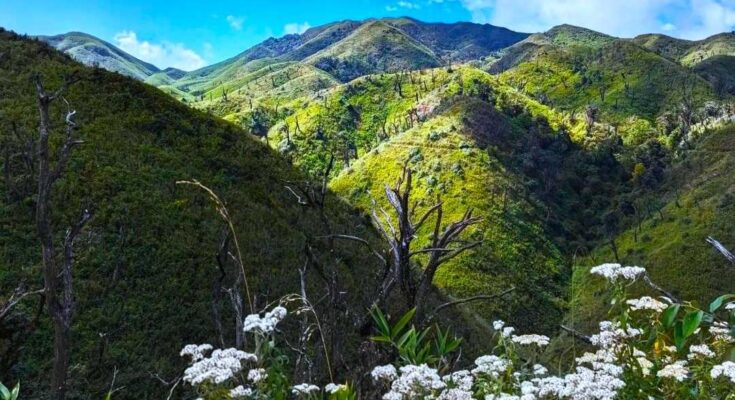
Table of Contents
Introduction to Dzukou Valley Trek
If you are looking for a refreshing and scenic trek, you should check out the Dzukou Valley Trek. It is a beautiful trek in the northeast region of India, where you can witness the natural splendor of rolling hills, lush forests, streams, and colorful flowers. The trek is suitable for beginners and can be done in 2-3 days. The best time to visit is from June to September when the valley is full of the famous Dzukou lilies and other orchids. The trek also offers you a chance to interact with the local people and learn about their culture and traditions.
In this blog, I will tell you everything you need to know about the Dzukou Valley Trek, including its history, geography, location, weather, biodiversity, and instructions. I will also share some tips and gear that you will need for the trek. And finally, I will suggest some nearby attractive spots that you can visit in Dimapur, the nearest city to the valley. So, let’s get started!
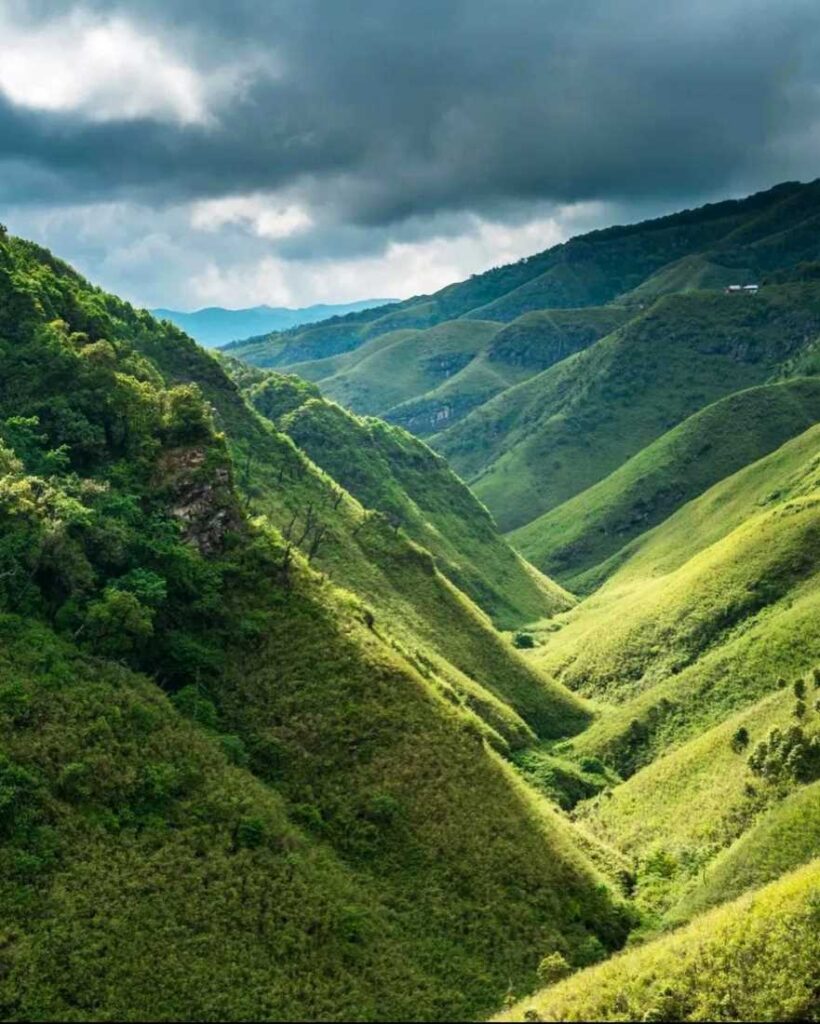
History and Geography of Dzukou Valley
The Dzukou Valley is located at the border of Nagaland and Manipur, two states in the northeast of India. The name “Dzukou” means “cold water” in the local Angami language, referring to the streams that flow through the valley. The valley is also known as the “Valley of Flowers” or the “Valley of Eternal Charm” because of its rich floral diversity and scenic beauty.
The valley has a long and interesting history, dating back to ancient times. According to legend, the valley was once inhabited by a demon named Dzukou, who terrorized the people living nearby. A brave warrior named Japfu challenged the demon to a fight and managed to defeat him. The demon fled to the valley and hid there, giving it his name. The people then celebrated the victory by planting flowers in the valley, making it a symbol of peace and harmony.
The valley is also a part of the Naga culture and folklore, as it is believed to be the resting place of the departed souls. The valley is considered sacred by the Naga tribes, who visit it to perform rituals and ceremonies. The valley is also a popular destination for adventure seekers and nature lovers, who come to enjoy its serene and picturesque landscape.
The valley covers an area of about 80 square kilometers and lies at an altitude of about 2452 meters above sea level. The valley is surrounded by the Japfu range, which is the second-highest peak in Nagaland, after Mount Saramati. The valley has a unique topography, with gentle slopes, flat grasslands, and rocky outcrops. The valley is also home to several streams and rivers, such as the Dzukou River, the Dzuleke River, and the Japfu River, which provide water and nourishment to the valley.
Location of Dzukou Valley: How to get it
The Dzukou Valley is not very easy to access, as it is located in a remote and hilly region. However, with proper planning and guidance, you can reach the valley without much hassle. The nearest city to the valley is Dimapur, which is the largest city and the commercial hub of Nagaland. Dimapur is well connected to the rest of India by air, rail, and road.
From Dimapur, you can take a bus or a taxi to Kohima, the capital of Nagaland, which is about 74 km away. From Kohima, you can hire a local taxi to the base camp at Vishwema village or Zakhama village, which are about 25 km away from Kohima. From the base camp, you can start your trek to the valley, which will take about 5-6 hours.
Dzukou Valley by Train
If you prefer to travel by train, you can take a train to Dimapur, which is the nearest railway station to the valley. Dimapur is connected to major cities like Delhi, Kolkata, Guwahati, Bangalore, Chennai, etc. by various trains. The fare varies from Rs. 500 to Rs. 2000 depending on the class and distance. Here are some of the trains that you can take to Dimapur from different places in India:
From Guwahati: You can take the Guwahati – Dibrugarh Express (15901), which runs daily and takes about 5 hours to reach Dimapur. The fare is around Rs. 200 for a sleeper class and Rs. 700 for an AC 3-tier.
From Kolkata: You can take the Kamrup Express (15959), which runs daily and takes about 18 hours to reach Dimapur. The fare is around Rs. 500 for a sleeper class and Rs. 1500 for an AC 3-tier.
From New Delhi: You can take the Brahmaputra Mail (14055), which runs daily and takes about 38 hours to reach Dimapur. The fare is around Rs. 800 for a sleeper class and Rs. 2500 for an AC 3-tier.
From Bangalore: You can take the Guwahati Express (12509), which runs thrice a week and takes about 52 hours to reach Dimapur. The fare is around Rs. 1000 for a sleeper class and Rs. 3000 for an AC 3-tier.
From Chandigarh: You can take the Chandigarh – Dibrugarh Express (15903), which runs twice a week and takes about 48 hours to reach Dimapur. The fare is around Rs. 900 for a sleeper class and Rs. 2800 for an AC 3-tier.
From Amritsar: You can take the Amritsar – Dibrugarh Express (15933), which runs once a week and takes about 50 hours to reach Dimapur. The fare is around Rs. 900 for a sleeper class and Rs. 2800 for an AC 3-tier.
From Dibrugarh: You can take the Dibrugarh – Dimapur Passenger (55901), which runs daily and takes about 4 hours to reach Dimapur. The fare is around Rs. 100 for a general class and Rs. 200 for a chair car.
From Chennai: You can take the Chennai – Dibrugarh Express (15929), which runs once a week and takes about 58 hours to reach Dimapur. The fare is around Rs. 1100 for a sleeper class and Rs. 3300 for an AC 3-tier.
Dzukou Valley by Air
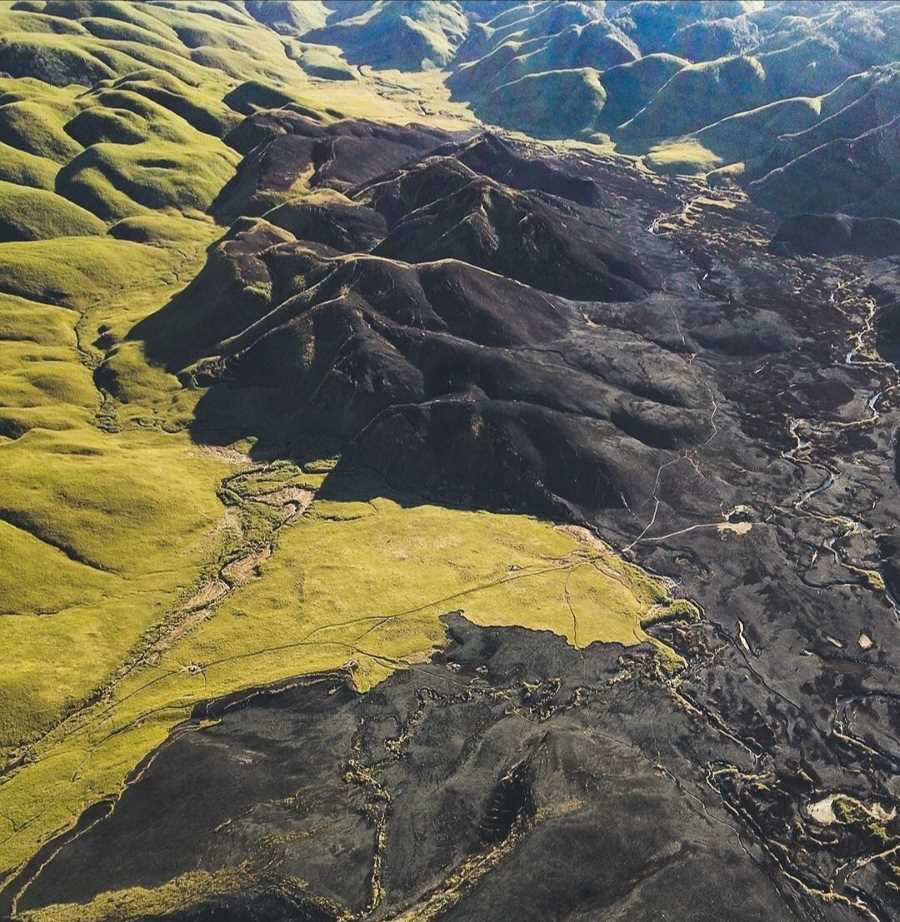
If you prefer to travel by air, you can take a flight to Dimapur, which is the nearest airport to the valley. Dimapur has a domestic airport, which is connected to major cities like Delhi, Kolkata, Dibrugarh, Bangalore, etc. by various airlines. The fare ranges from Rs. 3000 to Rs. 6000 depending on the season and availability. Here are some of the flights that you can take to Dimapur from different places in India:
From Kolkata: You can take the IndiGo flight (6E 797), which runs daily and takes about 1 hour to reach Dimapur. The fare is around Rs. 3000 for an economy class and Rs. 5000 for a premium economy class.
From Delhi: You can take the Air India flight (AI 705), which runs daily and takes about 2 hours to reach Dimapur. The fare is around Rs. 4000 for an economy class and Rs. 6000 for a business class.
From Dibrugarh: You can take the Alliance Air flight (9I 741), which runs daily and takes about 40 minutes to reach Dimapur. The fare is around Rs. 3000 for an economy class and Rs. 5000 for a business class.
From Bangalore: You can take the IndiGo flight (6E 797), which runs daily and takes about 4 hours to reach Dimapur. The fare is around Rs. 5000 for an economy class and Rs. 8000 for a premium economy class.
From Chandigarh: You can take the Air India flight (AI 9813), which runs thrice a week and takes about 3 hours to reach Dimapur. The fare is around Rs. 4000 for an economy class and Rs. 6000 for a business class.
From Dimapur to Kohima
Once you reach Dimapur, you can take a bus or a taxi to Kohima, which is the capital of Nagaland and the gateway to the Dzukou Valley. The distance between Dimapur and Kohima is about 74 km and it will take about 3 hours to cover it. The fare is around Rs. 300 for a bus and Rs. 1000 for a taxi. You can find buses and taxis at the Dimapur railway station or the airport. The buses and taxis are usually available from 6 am to 6 pm.
Biodiversity of Dzukou Valley
The Dzukou Valley is a treasure trove of biodiversity, as it hosts a variety of flora and fauna. The valley is famous for its endemic and rare species of flowers, especially the Dzukou lily, which is the state flower of Nagaland. The Dzukou lily is a pinkish-purple flower that blooms from June to September and can only be found in the Dzukou Valley. The valley also has other types of orchids, rhododendrons, primulas, euphorbias, and aconitums, which add to its beauty and fragrance.
The valley is also home to many animals, birds, insects, and reptiles, some of which are endangered or threatened. The valley has a rich population of mammals, such as the Himalayan black bear, the red panda, the barking deer, the wild boar, the porcupine, and the civet. The valley also has a diverse range of birds, such as the pheasant, the hornbill, the partridge, the cuckoo, the woodpecker, and the sunbird. The valley also has many insects, such as butterflies, moths, beetles, and bees, which pollinate the flowers and create a buzzing sound. The valley also has some reptiles, such as snakes, lizards, and frogs, which live near the streams and ponds.
The valley is a paradise for nature lovers and wildlife enthusiasts, who can observe and admire the biodiversity of the valley. The valley also offers a great opportunity for photography and videography, as it provides a stunning backdrop for capturing the beauty and diversity of nature.
Dzukou Valley Trek
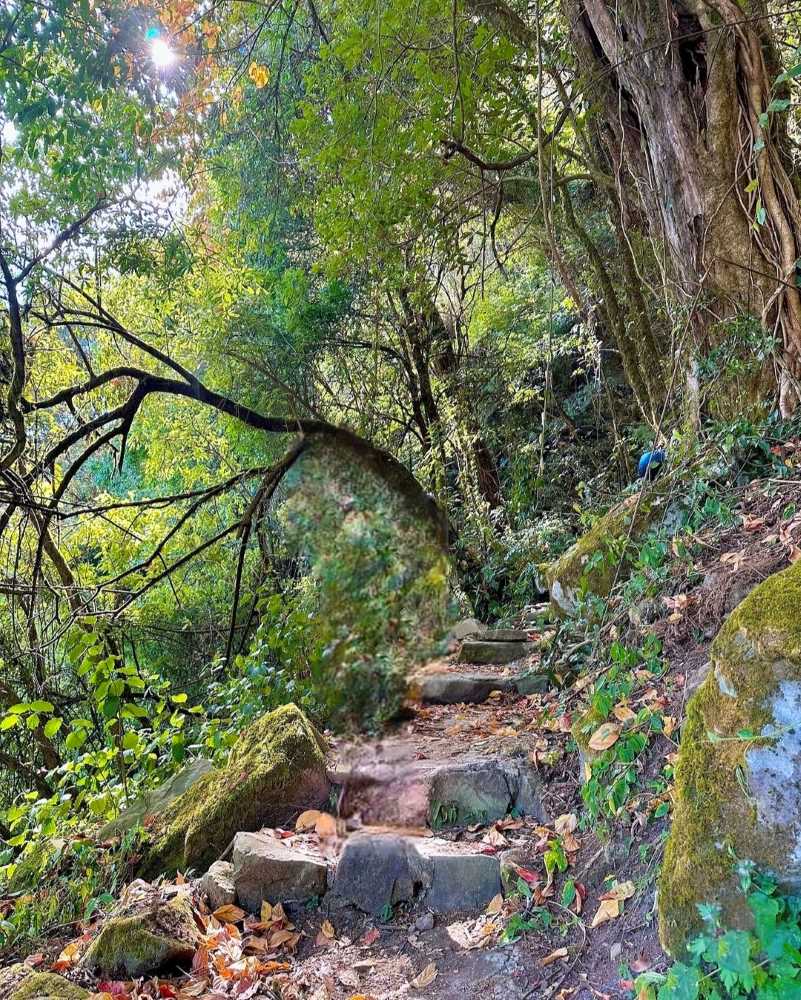
The Dzukou Valley Trek is one of the most popular and rewarding treks in the northeast of India. The trek takes you to the enchanting valley of flowers, where you can enjoy the panoramic views of the hills, forests, and streams. The trek is suitable for beginners, as it does not involve much climbing or technical skills. The trek can be done in 2-3 days, depending on your pace and preference.
There are two main routes to reach the Dzukou Valley from the base camp at Vishwema village or Zakhama village. The first route is via Zakhama, which is shorter and steeper. The second route is via Vishwema, which is longer and gentler. Both routes converge at the Dzukou Valley, where you can camp for the night. The next day, you can explore the valley and return to the base camp by the same route or the opposite route. Here are the details of each route:
From Kohima to Via Zakhama Trek
The Zakhama route is the more popular and faster route to reach the Dzukou Valley. The distance from Zakhama to the valley is about 15 km, and it takes about 5-6 hours to cover it. The trail starts from the Zakhama check post, where you have to register and pay a nominal fee. The trail then ascends through a dense forest, where you can see various types of trees, plants, and birds. The trail is well-marked and easy to follow, but it is also steep and slippery at some places. You have to cross several streams and bridges along the way, which can be refreshing and challenging.
The trail then reaches a point where you can see the Japfu Peak, which is the second-highest peak in Nagaland. The trail then flattens and widens, and you can see the Dzukou Valley in the distance. The trail then descends to the valley, where you can see the Dzukou River and the Dzukou hut, which is a wooden shelter for the trekkers. You can camp near the hut or anywhere in the valley, as long as you respect the nature and the culture of the place. You can also enjoy the sunset and the starry night from the valley, which can be a mesmerizing experience.
Start from Kohima and reach Zakhama by taxi, which will take about an hour. The fare is around Rs. 1500 for a round trip. Start the trek from the Zakhama check post, where you have to register and pay Rs. 50 per person as an entry fee. Trek through the forest, crossing streams and bridges, and reach the point where you can see the Japfu peak. The distance is about 10 km and it takes about 4 hours to cover it.
Trek downhill to the Dzukou Valley, where you can see the Dzukou River and the Dzukou hut. The distance is about 5 km and it takes about an hour to cover it. Camp near the hut or anywhere in the valley, and enjoy the evening and the night.
Explore the valley and admire the beauty and diversity of the flowers, especially the Dzukou lilies and orchids. You can also visit the caves and the waterfalls in the valley, which are hidden and mysterious. Return to the base camp by the same route or the opposite route, depending on your choice. The distance is about 15 km and it takes about 5-6 hours to cover it. Reach Kohima by taxi and end the trek.
From Kohima to Via Vishwema Trek
The Vishwema route is the less popular and slower route to reach the Dzukou Valley. The distance from Vishwema to the valley is about 20 km, and it takes about 7-8 hours to cover it. The trail starts from the Vishwema check post, where you have to register and pay a nominal fee. The trail then ascends through a pine forest, where you can see various types of trees, plants, and birds. The trail is well-marked and easy to follow, but it is also long and gradual. You have to cross several streams and bridges along the way, which can be refreshing and challenging.
The trail then reaches a point where you can see the Dzukou Valley in the distance. The trail then descends to the valley, where you can see the Dzukou River and the Dzukou hut, which is a wooden shelter for the trekkers. You can camp near the hut or anywhere in the valley, as long as you respect the nature and the culture of the place. You can also enjoy the sunset and the starry night from the valley, which can be a mesmerizing experience.
Start from Kohima and reach Vishwema by taxi, which will take about an hour. The fare is around Rs. 1500 for a round trip. Start the trek from the Vishwema check post, where you have to register and the entry fee for each person is Rs=50.
Trek through the pine forest, crossing streams and bridges, and reach the point where you can see the Dzukou Valley. The distance is about 15 km and it takes about 6 hours to cover it. Trek downhill to the Dzukou Valley, where you can see the Dzukou River and the Dzukou hut. The distance is about 5 km and it takes about an hour to cover it. Camp near the hut or anywhere in the valley, and enjoy the evening and the night.
Explore the valley and admire the beauty and diversity of the flowers, especially the Dzukou lilies and orchids. You can also visit the caves and the waterfalls in the valley, which are hidden and mysterious. Return to the base camp by the same route or the opposite route, depending on your choice. The distance is about 20 km and it takes about 7-8 hours to cover it. Reach Kohima by taxi and end the trek.
Instructions, Tips, and Gears for Dzukou Valley Trek
The Dzukou Valley Trek is moderate, but it still requires some preparation and precautions. Here are some instructions, tips, and gear that you will need for the trek:
Take Permit
You need to obtain a permit from the Nagaland Tourism Department or the Nagaland Adventure and Mountaineering Association (NAMA) before going for the trek. You can also get the permit from the check posts at Zakhama or Vishwema, where you have to pay the entry fee of each person is Rs=50. You also have to carry your identity proof and passport-size photos for the permit.
Hire Local Guide
You need to hire a local guide or a porter for the trek, as they can help you with the route, the culture, and the safety. You can find them at the base camp or through a travel agent. The cost is around Rs. 500 to Rs. 1000 per day, depending on the service and the season.
Carry Necessary Equipment
You need to carry your camping equipment, such as a tent, a sleeping bag, a sleeping mat, a stove, a utensil, a water bottle, a torch, and a first aid kit. You can also rent them from the base camp or a travel agent. The cost is around Rs. 500 to Rs. 1000 per day, depending on the quality and the season.
Food and Snack
You need to carry your food and snacks, as there are no shops or restaurants in the valley. You can also buy some local food, such as rice, dal, vegetables, and meat, from the villagers at the base camp. The cost is around Rs. 100 to Rs. 200 per meal, depending on the quantity and the season.
Clothes and Shoes
You need to wear comfortable and warm clothes, such as a jacket, a sweater, a cap, a scarf, a glove, and a sock, as the weather can be cold and windy in the valley. You also need to wear sturdy and waterproof shoes, such as trekking shoes or boots, as the trail can be rough and wet in some places.
Carry Essential Items
You need to carry some essential items, such as sunscreen, lip balm, sunglasses, a camera, a power bank, a book, a map, and a compass, as they can be useful and enjoyable in the valley. You also need to carry some extra cash, as there are no ATMs or card machines in the valley.
Follow the Rules
You need to follow some rules and etiquette, such as respecting the nature and the culture of the place, not littering or polluting the valley, not plucking or damaging the flowers, not making noise or disturbing the wildlife, not trespassing or entering the private property, and not taking photos or videos without permission.
Nearest Attractive Spots for Tourists in Dimapur
If you have some extra time and energy after the Dzukou Valley Trek, you can also visit some of the nearest attractive spots for tourists in Dimapur, which is the largest city and the commercial hub of Nagaland. Dimapur has a rich and diverse history, culture, and nature, which can offer you a glimpse of Naga life and heritage. Here are some of the places that you can visit in Dimapur:
Kachari Ruins
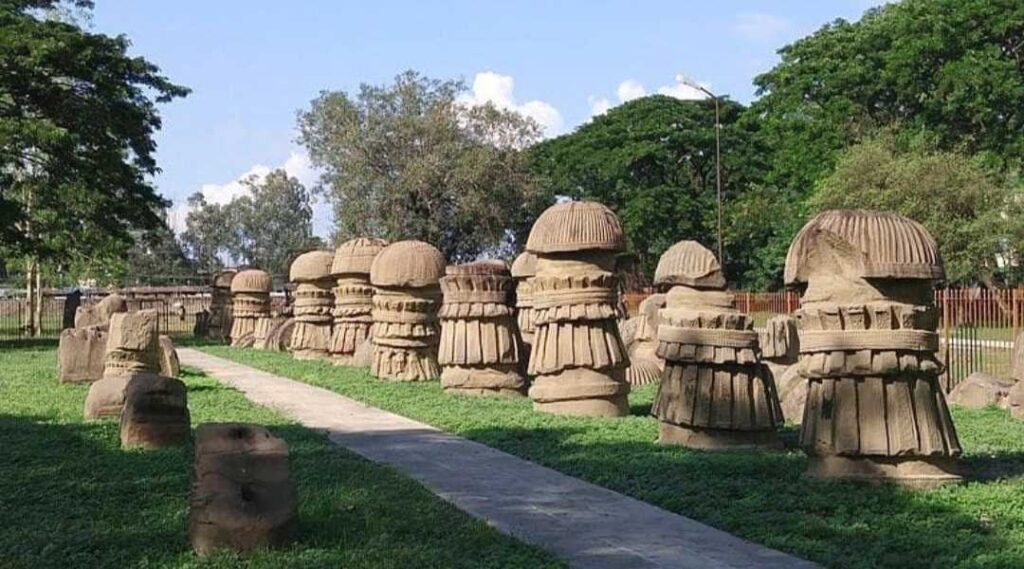
The Kachari Ruins are the remnants of the ancient kingdom of the Kachari tribe, who ruled over the region from the 13th to the 19th century. The ruins are located near the Dimapur railway station and consist of various stone structures, such as pillars, arches, domes, and tanks. The most prominent and mysterious feature of the ruins is the mushroom-shaped monoliths, which are believed to be associated with some rituals or ceremonies. The ruins are a testimony to the architectural and artistic skills of the Kachari tribe, and also a reflection of their culture and religion.
Triple Falls
The Triple Falls are a spectacular sight of nature, where three streams of water cascade down from a height of about 280 feet, forming a pool at the bottom. The falls are located in the Seithekima village, which is about 16 km from Dimapur. The falls are surrounded by lush greenery and rocky cliffs, which create a scenic and serene atmosphere. The falls are also a popular spot for picnics, camping, and trekking, as there are several trails and spots to explore and enjoy.
Nagaland Science Centre
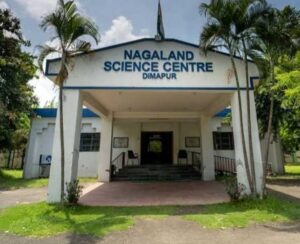
The Nagaland Science Centre is a place where you can learn and have fun at the same time. The centre is located on the Dimapur-Kohima road and is a part of the National Council of Science Museums. The centre has various galleries and exhibits, such as the Fun Science Gallery, the Children’s Corner, the Our Senses Gallery, the Taramandal, and the Science Park, where you can interact and experiment with various scientific concepts and phenomena.
The centre also organizes various programs and activities, such as workshops, quizzes, competitions, and shows, to promote scientific awareness and curiosity among visitors.
Nagaland Zoological Park
The Nagaland Zoological Park is a place where you can see and admire the wildlife of Nagaland and other regions. The park is located in the Rangapahar Reserve Forest, which is about 6 km from Dimapur. The park covers an area of about 176 hectares and houses various animals, birds, and reptiles, such as the tiger, the leopard, the deer, the hornbill, the peacock, the python, and the crocodile.
The park also has a botanical garden, where you can see various types of plants and flowers. The park is a great place to visit for nature lovers and wildlife enthusiasts, who can observe and learn about the biodiversity and conservation of the region.
Accommodation Options in Dzukou Valley
There are no luxury accommodations or hotels in Dzukou Valley, as it is a remote and natural place. The only option for staying in the valley is a basic rest house, which offers two dormitories and five private rooms. The rest house has a wooden shelter, a fireplace, and a kitchen, but no electricity or running water. The price for a bed in the dormitory is Rs. 50 per night, and the price for a private room is Rs. 200 per night.
Alternatively, you can bring your tent and camp anywhere in the valley, as long as you respect the nature and the culture of the place. You can also rent a tent from the rest house or a travel agent in Kohima. The price for renting a tent is around Rs. 500 to Rs. 1000 per day, depending on the quality and the season.
Accommodation Options in Kohima
There are many staying options in Dimapur, the largest city and the commercial hub of Nagaland. You can choose from hotels, homestays, campsites, and heritage properties, depending on your budget and preference. Here are some of the popular and recommended places to stay in Dimapur:
Hotel Grand Tizu:
This is a relatively posh hotel, with spacious rooms, modern amenities, and a restaurant. The hotel is located near the Kohima War Cemetery and the Naga Bazaar. The price for a double room is around Rs. 5,074 per night.
Razhu Pru:
This is a rustic heritage boutique hotel, with cozy rooms, traditional decor, and a garden. The hotel is located near the Kisama Heritage Village and the Japfu Peak. The price for a double room is around Rs. 2,500 per night.
The Heritage:
This is a superbly situated, converted colonial bungalow, with elegant rooms, antique furniture, and a fireplace. The hotel is located near the Kohima Museum and the Catholic Church. The price for a double room is around Rs. 3,000 per night.
Native Stories Homestay Tribal Heritage:
This is a homestay that offers a complete experience of the tribal culture of Kohima. The homestay is nestled in the lap of Mt. Japfu, and offers traditional and organic food, along with basic amenities. The price for a double room is around Rs. 800 per night.
Hillfoot Camp & Home Stay:
This is a campsite and a homestay that offers a relaxing getaway in the hills of Kohima. The campsite and the homestay are located near the Dzukou Valley and the Pulie Badze, and offer tents, cottages, and huts, along with a bonfire and a barbecue. The price for a double room is around Rs. 1,000 per night.
The Dzukou Valley Trek is a wonderful and memorable experience that can fill your senses and soul with joy and peace. The trek takes you to the Valley of Flowers, where you can see the beauty and diversity of nature. The trek also allows you to learn and appreciate the history and culture of the Naga people, who live in harmony with nature and the spirit. The trek is suitable for anyone who loves adventure and nature and can be done in 2-3 days with proper planning and preparation.
If you are planning to visit the Dzukou Valley, you can also visit some of the nearest attractive spots for tourists in Dimapur, which can offer you a glimpse of Naga life and heritage. Dimapur has a rich and diverse history, culture, and nature, which can offer you a lot of things to see and do. You can visit the Kachari Ruins, the Triple Falls, the Nagaland Science Centre, and the Nagaland Zoological Park, which are some of the places that you can visit in Dimapur.
Q: Which month is the best to visit Dzukou Valley?
A: The best time to visit Dzukou Valley is the blooming season from April to September.
Q: What is the myth of Dzukou Valley?
A: There are many myths and stories ranging from ghosts, existing white elephants and dead stop before departing.
Q: What is the difficulty level of Dzukou trek?
A: Trek difficulty level ranges from easy to moderate and the tip is start trek as early as possible.
Q: Does it snow in Dzukou Valley?
A: When the winter is at its peak the entire valley gets covered with snow.
Q: Where is the starting point of Dzukou Valley Trek?
A: Kohima is the starting point of Dzukou valley trek.
Q: What is the nickname of Dzukou Valley?
A: Dzukou Valley is also called the valley of flowers.
Q: What is the meaning of Dzuko?
A: It comes from the Naga tribe name Angami/Mao, which means “Cold Water”.
Q: Is there Internet in Dzukou Valley?
A: Sorry to say, there is no internet and mobile network in the valley.
Q: What is the quote from Dzukou Valley?
A: There are many but the famous one is “going to Dzukou is nothing hard like going to heaven”.
Q: What is the hardest trek in India?
A: I can’t specify but 3 most difficult treks are “Auden’s Col Trek”, “Kang La Trek”, and “Pin Parvati Pass Trek”.
Q: Which is the hardest trek in Kerala?
A: No doubt about that and it is “Agasthyarkoodam”.
Q: Is Dzukou Valley the capital of Nagaland?
A: No, Kohima city is the capital of Nagaland.
Q: Which peak is in Kohima?
A: “Japfu Peak” is one of the difficult trek in Kohima, Nagaland.
Thank you for joining me on this incredible adventure to some of the most beautiful places on Place Attract! I hope you enjoyed seeing these amazing places with me through your screen. But this is not the end! There are still more secrets and wonders to uncover. No matter if you are a seasoned traveler or a novice, Place Attract is the best place to find travel ideas. So, what are you waiting for? Dive deeper into the marvels of our planet and explore more magical places like: Polo Forest , Mukeshpuri
Related Posts
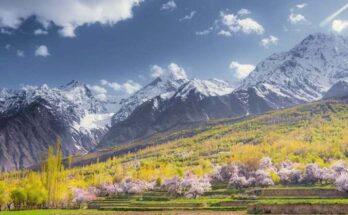
Chunda Valley: No 1 Treasure in Pakistan
March 18, 2024 March 20, 2024
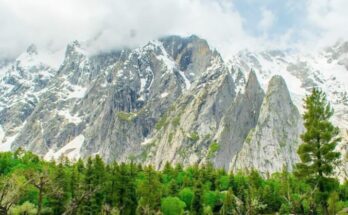
Haramosh Valley: A Hidden Gem of Northern Pakistan
February 28, 2024 March 20, 2024
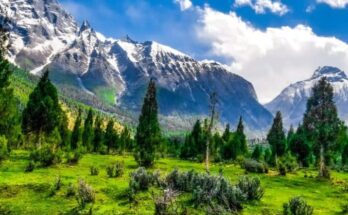
Basho Valley: A Beautiful Place in Skardu
February 21, 2024 March 20, 2024
About Arsalan
One comment on “dzukou valley trek: a guide to the valley of flowers”.
- Pingback: Franklin Falls Trailhead: A Hiker’s Guide - Place Attract
Leave a Reply Cancel reply
Your email address will not be published. Required fields are marked *
Save my name, email, and website in this browser for the next time I comment.
Listed 40 times as Top Travel Blog Of India!

Dzukou Valley trek in Nagaland: Complete Guide
Last Updated on January 28, 2022 by asoulwindow
Table of Contents
About Dzukou valley
Dzukou valley, is an easy level trek near Kisama and Kohima, the venue for annual Hornbill Festival of Nagaland. Dzukou valley is known for the unusual shapes of its verdant hills, surreal sunsets and the rare Dzukou valley lily.
Located near Kohima and Kisama, people can trek to Dzukou valley from both Nagaland and the neighbouring North East Indian state Manipur. This must-see place is just a quick weekend destination from Kohima.
Here is the most comprehensive travel guide to Dzukou valley trek on internet.
Nomenclature of Dzukou valley
Dzukou valley is also spelt as Dzükou Valley or Dzüko Valley. It is interesting to note that the word Dzüko is not really a happy and positive word. Dzüko is a word derived from Viswema dialect of one of the major tribes of Nagaland called as Angami tribe .
I was surprised to know that the literal meaning of Dzüko is ‘dull and soulless. Others say that ‘Dzu-kou’ in Angami/Mao language stands for cold waters. It indicates at the icy cold water that flows in Dzüko valley.
In the Mao language of Manipur, the word Dziikou also stands for ‘Dream like’ thanks to the mystical charm of this offbeat place. As per the legends in Mao, it is said that when lovers visit the Dziikou Valley, the night turns like a day and the moonlights shines as if it is sun!
As per the local folklore, in old times, the ancestors of Viswema wanted to build a new village in Dzüko. However, they found the climate and weather of Dzüko unfit for farming and harvesting crops. This is why the ancestors labelled Dzüko as ‘A beautiful but dull and soulless valley.’
Why is Dzukou Valley famous?
So, why do tourists visit Dzukou Valley in Nagaland? There are many reasons to why the Dzukou Valley is so famous around the world. Many Indians and foreigners head to the annual Hornbill Festival every year in Kisama near Kohima. Most of them also club the Dzukou Valley trek, which is located nearby.
The proximity of Dzukou Valley from Kisama, the venue of Hornbill Festival has continued to its popularity over the years. Also, the beautiful landscapes of the hills of the Dzukou Valley have added to its fame over the years. The shapes of the hills at Dzukou Valley are very unusual. People come from near and far just to sock in the breath-taking views of the Dzukou Valley.
Despite its soaring popularity, the Dzukou valley is still one of the best offbeat places to visit in Nagaland and North East India. This is so because even now the number of people who trek to Dzukou valley are very small.
Needless to say, the Dzukou Valley trek is the most famous trek throughout the North East India . I have done other treks in North East India such as Bat Cave Trek and Odi Pudo trek in Basar in Arunachal Pradesh . They were all easy one-day treks .
Dzükou valley trek: My Experience
I finally made it to Dzouko valley trek. It’s just a 3 hour long easy trek from Visvema village. I, however freaked out at the narrow path in the Dzukou valley. It lasted for 1.5 to 2 hours.
I found the dome shaped meadows of Dzouko valley breathtakingly beautiful. I kept staring at the verdant knolls and the iconic rolling hills, losing any sense of time. The sunset at Dzükou was also one of the most amazing ones I have seen.
I did the famous Dzükou valley trek with my co traveller Amit Chandana from Delhi. We had just met in the Hornbill festival, became good friends and the next thing we know is that we travelled together for many days in Kohima, Loktak Lake and Imphal in Manipur and the special Moreh and Tamu border between India and Myanmar .
I and Amit began our journey from Kisama, outside the venue of Hornbill festival. We negotiated with a driver at the taxi stand. He dropped us at the Viswema village, the starting point of the Dzükou valley trek. But we insisted that he drop us even further as we had got late already.
The poor young man had recently lured into being converted to Christianity from Hinduism . The shrewd Christian missionaries are found in plenty in North east India. I saw many similar Christian missionaries in Uganda and Africa as well whose sole agenda is to convert people to Christianity and give them ridiculous names such as Tom, Dick and harry, eh!
Our ‘Harry’ already seemed frustrated and we added fuel to his woes by making him drive on the rocky patches leading up to the actual start of the Dzükou valley trek.
Soul Window Tip
The driver kept complaining but it was a good idea that we stood our ground and drove over this rocky patch. This part which must have been some 8-9 kilometres didn’t offer much of a view and saved us from unnecessary extra trekking.
It was not even the actual trek. It can take you upto 3 hours to negotiate this gradual incline. You must therefore avoid walking here and save energy for the actual Dzukou Valley trek.
Start of Dzukou Valley Trek
We finally arrived at a flat ground. There were some houses and other cars parked there. We confirmed the route of Dzükou valley trek from the ladies drying the red hot Bhoot Jholokia chillies. The driver ran away as soon as we turned towards the Dzükou valley trek route.
It was end of autumn and beginning of winter, so our path was laden with golden brown dry leaves.
As we navigated our way through Dzuköu Valley, the mere sight of the wooden huts made me excited! When I finally had my first bird’s eye view of Dzukou Valley, I was stunned at its unusual beauty!
Dzukou valley Height or Altitude
The altitude of Dzukou valley is not much.The total height of Dzukou valley above sea level is merely 2,462 meters or 8077 feet which is same as the height of Lukla , the base village of Everest Base Camp Trek or Lohajung, the base village of Roopkund trek in Uttarakhand in North India.
Just to give you a perspective, the height of Lukla is 9383 feet or 2860 meter and the height of Lohajung is 7545 feet or 2300 meters. I have fond memories of these treks as well.
Dzukou valley difficulty level
I had checked out from my tent in Kisama. Before we left Kisama for Viswema, I had dropped my huge bag-pack in the tent of Amit in Kisama which turned out to be a good decision because the first 1 hour of the trek is a tiring steep climb through dense forests. This rock patch was around 1 kilometre long.
Though, the climb on the rough stone steps is very steep, it is still an easy one. It reminded me of the tougher endless stairs I climbed in Ulleri during the Poonhill Trek in Nepal in the Annapoorna Range in the Great Himalayas .
Arriving at Flat Ground
When we reached the top of the ascent of Dzuköu Valley, we were greeted with sweeping bird’s eye views of the valley and mountains in distance. It was our first beautiful panoramic view since the climb started. I was impressed to see how green the place was even in winter.
The tall mountains in far distance made for a dramatic setting! The final destination of Dzukou valley trek is located at a distance of just 4-5 kilometres from here.
Narrow passage
From here it is just a 2 hour walk of easy trek to the final destination of Dzukou valley trek . It was a relatively very easytrek.I, however was not very comfortable with the narrow passages.After having done high altitude treks like Roopkund trek and Dodital-Darwa Pass trek in Uttarakhand and Everest Base Camp trek in Nepal , I have developed this phobia of heights, especially when the path is narrow.
My co trekker Amit Chandana whom I met for the first time in Hornbill festival gave me good company. He sincerely waited for me as I navigated through the treacherous patches on trek.
As for the technical difficulty, I feel that you do not need to have a prior trekking experience to be able to complete the Dzukou valley trek successfully. Anyone with a moderate fitness level can do the Dzukou valley trek easily.
There was just a small rock patch which one needs to cross cautiously. One mistake and you can fall straight into the seemingly harmless valley. Amit helped me cross it. It reminded me of a similar patch I saw during the famous Bhimashankar Monsoon Trek in Maharashtra and Gokarna Beach Trek in Karnataka .
Route of Dzukou valley trek
The entire route of Dzukou valley trek is well marked. We did the trek on our own and didn’t really need a guide. We saw many people from different states of India and European nations such as Netherlands , doing the Dzukou valley trek on their own.
There is just one place which might confuse you on which trek route to take, just follow the path where most people are going and you will be sorted. This place comes when you reach the top after ascending the stairs. You can reach Dzuköu Valley from both Nagaland as well as its neighbouring Indian state Manipur.
There are three main routes of Dzukou valley Trek
Viswema Route
I took the popular Viswema route! It took me 3 longs and was a very easy well marked route. The signboard of ‘Dzuköu Valley’ throughout this route further helped us. It is the most popular route.
Jakhama Route
Though Jakhama route is shorter it is not very popular because it is very steep and the path is confusing. It is also considered to be a difficult route. Jakhama is also spelt as Zakhama. Be warned that the ascent on this route is difficult and tiresome. It is not very popular but still some trekkers prefer this alternative route. Jakhama is 20 kilometres away from Kohima.
Manipur route
The other route of Dzukou valley starts from the Mount Issi at Senapati district in the neighbouring state of Manipur. It is the least popular route. The amenities on the Manipur side are not proper. The trekking route from Manipur is also strenuous. Manipur Mountaineering and Trekking Association or the MMTA often takes the 5-hour long trek from the Senapati route.
Soul Window Travel Tips
Many trekkers also start with the Viswema route and conclude it with the Jakhama route. This not only gives an idea of the alternate views but also rewards the trekkers with different views of the Dzukou Valley.
Views during the Dzukou valley trek
I trekked to Dzukou valley in the winter months. It was lush greenery no matter which location I turned to. The way to the final spot in Dzukou valley trek is equally beautiful.I avoided looking down immediately fearing vertigo so I admired the mountains far in distance. Despite the Hornbill festival, we didn’t quite meet many people on the way perhaps because we started late for the trek.
The unique trees of Dzuköu Valley are its hallmark. The stunning landscape of Dzuköu Valley impressed me even before we had reached its final stop.
How long Dzukou valley trek takes
The Dzukou valley trek took me just around 3 hours to complete, despite my slow pace and camera breaks. Out of these 3 hours, the first 1 hour is the toughest because it is a steep climb. The next 2 hours are a breeze in case you are not bothered by the narrow pathways. To summarise, Dzukou valley trek was one of the shortest and easiest treks I ever did.
Dzukou valley location
Where is Dzukou valley located? Dzukou valley is located in both Nagaland as well as Manipur. In Nagaland, Dzukou valley is located near Kisama and Kohima, while in Manipur, Dzukou valley is located near Senapati district.The Dzukou valley stands behind the famous Japfu Peak in Nagaland.
Dzukou valley Ghost Cave
Ever wanted to narrate ghost stories in a dark cave? Well, that is possible in Dzukou valley cave. There is a famous Bhoot Gufa or the Ghost Cave nearthe Trekker’s Hutor Rest House. This is another popular tourist places in Dzukou.
You can just trek for 15 minutes to arrive at the Bhoot Gufa.It is an easy descend and an important place of interest in Dzukou.
It is a long and dark cave so it is advised to carry torches and flashlights while visiting the cave.The cave at Dzukou valley is one kilometre long. You must visit this tourist attraction of Dzouko, probably with a local tourist guide.
Dzukou valley helipad
There are so many other places you can explore in and around Dzukou valley such as a helipad and a bridge. It is one of the most unusual things to do in Dzukou valley.
The Dzukou valley helipadis used once in a while by VIPs. The helipad is not much in use through most part of the year.
Dzukou Valley Bridge
Did you know that you can also go to a Dzukou valley bridge? But it takes around 3 hours to the bridge and back to the base of rest house. Still, many trekkers go here for great photo opportunities. It is a free thing to do in Dzukou valley.
The real Dzukou valley
Do you know that you can arrive at the actual open Dzukou valley from a nearby route which starts from the Rest House? It takes around 30 minutes of an easy gradual descent from the Rest House to reach the open valley which we saw from the Rest House.
This route from the rest house also passes through a helipad You will also pass the Dzukou river on this route. These are some major points of attractions here.
Dzukou valley camping
I saw tourists camping on the helipad as it offers stunning alternate views of Dzukou valley. Trekkers either carry their own tents and can pitch it at a designated spot for a small fee. In case, you want to do camping only after arriving here and have not brought along any camping gears, fret not!
The staff at Rest House can provide you with tents and other camping gears as well. Needless to say, these cost more.
Dzukou valley landscape
The landscape of Dzukou valley is unlike anything else I have seen in India or abroad. The cute little mounds enveloped entirely by grass, makes for a picture postcard perfect setting! The spectacular landscape of Dzukou valley also makes for great photo opportunities.
The topography of the valley is such that it looked like as if the Dzukou valley is a vestige of a massive volcanic crater or caldera of a prehistoric volcano.
Bonfire at Dzukou valley
The staff at the Guest House can also arrange for bonfires for extra fees. You can see many Indian and foreigners huddled around the bonfire, chatting the night away. This is a major attraction here. No wonder, Dzukou is also a famous picnic spots for many locals from mostly young trekkers from Nagaland, Manipur, Assam, West Bengal etc.
Wildlife of Dzüko
Dzüko is a terrain rich in wildlife . Though I didn’t spot any wildlife in Dzukou valley during my visit, it hides several magnificent animals and exotic birds in its undulating fields.
Some rare species of mammals such as the Asiatic Black Bear, Clouded leopard, Asian Golden Cat, capped langur and the only Indian ape: the Hollock Gibbon are found in and around the Dzukou valley.
The unusual looking serow, stump-tailed macaques , the capped langur and the indigenous Dzuko Valley horned toad (Megophrys dzukou) are some of the other exotic species you can find in Dzukou valley.
Birdwatching is also one of the top things to do Dzukou valley.
Dzukou Valley Vs Japfu peak
If you have time then you can do both Dzukou valley and Japfu peak at one go! In fact, Dzukou valley stands right behind the Japfu peak. Most of Dzukou valley and entire Japfu peak is located in Nagaland.
The trekking route here is punctuated with emerald green knolls,serpentine water streams,lush jungles and the constant company of exotic birds and butterflies such as Bhutan Glory (Bhutanitis Lidderdalii). These are must-visit places in Nagaland.
Japfu peak is located at a height of 6,000 feet only. The trek route of Japfu peak is 6 kilometers long and it takes around 6 hours to complete the Japfu peak trek. It is a moderate trek with mostly an ascending trail. Both are important sightseeing attractions of Nagaland.
Dzukou Valley Sunset
I have seen one of the best sunsets of my life in the Dzukou valley. Once we reached the final destination of Dzukou valley trek, it was time to ‘do nothing’ . Tired after an easy but long walk to Dzukou valley, I spent time just talking with Amit when suddenly the skies started to behave dramatic. The mystical golden hour of Dzukou started to unveil its myriad shades.
Everyone who was present there, including the locals, were silenced when the setting sun lyrically revealed its hues, one at a time. The chatty trekking team from South India and Maharashtra in West India also allowed nature to talk. A local man, draped in his stylish red Naga shawl stood on a rock, perhaps reflecting or missing the company of a loved one. It was a surreal moment.
I ran to my spot in the hall to get the camera. Just as I started clicking, I stopped. After a few shots, I switched off the DSLR camera and packed it in my bag. I wanted to feel the moment. I sat silently on the bench with Amit and soaked in the spectacular views of the scattered colours of a surreal sundown.
Sunset in Dzukou happens between 4 p.m. to 5 p.m. in winters. By 6 p.m. most places across North East India starts to begin desolate. So, it is advised to reach early. We had arrived just before the sunset. The sunset at Dzukou is not to be missed! It is the best thing to do in Dzukou valley. I had no prior knowledge of this and had just lucked out.
Soul Window Reflections
The lack of crowds and distractions made the sunset even more ethereal. Birds, flying in and out of sun in far distance, yellows turning into deep oranges, the works!
The other amazing sunsets I saw in North East India were in Majuli and over the mighty Brahmaputra River on a ferry ride near the famous Bogibeel bridge , both in Assam. Sunset in the famous Loktak Lake in Manipur if not stunning, was comforting!
As the stillness of the Dzukou sunset started to grow on me, it lulled me into a chain of philosophical thoughts. Isn’t that what a good sunset supposed to do!
Where to stay in Dzukou valley
I stayed at the only dormitory available there. It is run by the Nagaland Union and is the only place where you can stay in Dzuköu Valley. It has below basic facilities. I opted for the dorm type stay. I rented mats, pillows and blankets and failed to sleep anyways. It was too cold to sleep. Thanks to my down jacket I was able to stay protected from extreme cold for some time.
You have seen that jacket before on my previous trips such as the epic Kailash Mansarovar Yatra in Tibet , haven’t you? It had become my best friend on Treks. The leather free shoes also served me well.
I stayed at the huge community hall aka dormitory or rest house at the Dzukou valley. Painted with unpleasant art and graffiti, the huge wooden hall is built on stilts. We slept on the floor of the unkempt hall which was made up of large wooden planks. It was one of my most uncomfortable bed ever. Since I had trekked to Dzukou valley in harsh winters, I had tossed all night due to biting cold.
Though I had rented 2 thin blankets and a pillow, it was not helping much. The blankets were not clean either. Amit, on the other hand was in a better position as he was carrying a warm and clean sleeping bag with him. It is thus advised to carry sleeping bags with you (if you can)!
Be warned that during high season the room at Dzukou Valley Rest House might be full. During low season, the staff might not be present at the Dzukou Valley Rest House. The staff of Rest House wear many hats. They are responsible for collecting admission fees, providing beddings, make bonfires and even cook food for the trekkers.
Vegan and Vegetarian Food in Dzukou valley
We had delicious vegan and vegetarian food in Dzukou valley. The people who manage the accommodation also make fresh food every-day. We had filling dal-chawal with vegetables. (Lentils, rice and vegetables.) It was accompanied by super spicy bhut jolokia chutney.
Bhoot Jholokia is the hottest chilly of India. Needless to say, I had very small quantity of bhut jolokia. It went well with Daal Bhat and a potatoes bhujia .
I would also advise you to carry some food packets with long shelf life such as chips, farsaan , dates, chocolates, khakhra, thepla etc. It can come handy as the evening snack as the dinner can be served very late at times. Even during breakfast, your packed food can add some comfort. The facilities and food served at Dzukou valley is very basic. They do make Lalcha or Laal Chai or the red tea also on request here.
They also have a local source of freshwater from where we filled our water bottles. If you are not comfortable with drinking this water do carry a water purifying bottle along-with you. Thankfully, they do not sell plastic water bottles here.
I have drunk water from a cave in Rajmachi trek in Maharashtra and from holy rivers during Kailash Mansarovar Yatra so I found the water in Dzukou drinkable.
Languages spoken in Dzükou Valley Trek
Nagamese is the most popular language spoken by locals in Dzükou Valley Trek. Nagaland is a multi-cultural land, therefore smaller dialects such as Sümi, Lotha, Angami, Ao and Chakhesang are also spoken. However, Hindi and English are also very easily understood and spoken by most people of Nagaland.
Photography Tips for Dzükou Valley Trek
Most tourists and trekkers visit Dzükou Valley Trek before the sunset to save cost of accommodation. But I recommend to stay here for sun set. You can not only witness some of the best sun sets of your life but also capture the beauty for posterity. There are also many visually sightseeing places nearby. You must explore these unusual places to see for great shots.
Timings of Dzükou Valley Trek
There is no fixed timing for Dzükou Valley Trek.Much like most treks, you are free to visit anytime for the day. However, the unsaid rule is that tourists must reach the final entry gate of Dzükou Valley Trek before sunset, so that the caretakers can take orders, prepare meals and provide facilities. Most people leave Dzükou Valley on the next day after sun rise and breakfast.
Duration of Visit
How many days to spend in Dzükou Valley?
You can do Dzükou Valley trek in both one day and two days. I recommend at least 2 days in Dzükou Valley.
What can I do in 1 day in Dzükou Valley
Many people, like my close friends have visited Dzükou Valley for only one day. It is absolutely fine to do just a day trip to Dzükou Valley, but chances of missing some of the best hidden gems and offbeat vantage points are high if you return back before sun set.
What can I do in 2 days in Dzükou Valley
I stayed at Dzükou Valley for 2 days. It was rewarding to stay at Dzükou Valley for 2 days as you can get extra time to:
- Visit helipad
- Enjoy bonfires
- Chat with strangers
- Enjoy views of sun rise
- See Dzükou Valley lilies
- Go off the beaten track
- Visit Dzükou Valley bridge
- Discover new hidden gems
- Experience ethereal sun set
- Trek further to the rolling hills
- Sleep in bone chilling dorm (It’s an experience!)
- Enjoy the dinner with hot bhoot jholakia chutney
Doing all the above-mentioned activities are not possible in one day. You will miss many of such cool things to do in Dzükou Valley if you visit for only 1 day.
Best time to visit Dzukou Valley
The best time to visit Dzukou Valley is as early as possible. It gets dark as early as 5-6 p.m. in all the 7 sister states of North East India . It is thus advised to reach at the dorm aka rest house early so that you can spend time in the Dzukou Valley.
Also, you should leave Dzukou Valley the next day early morning as well, so that you can reach Viswema early and find a taxi to Kohima or Kisama.
I do not recommend returning to Kisama or Kohima the same day. What’s the point in rushing when you can enjoy the beauty of Dzukou valley at a slow pace? Also, the sunset is unmissable here.
Dzukou Valley can be visited any time of the year and it still looks just as stunning. Let us see which months are the best to visit Dzukou Valley.
Dzukou Valley trek is hot and humid in summer months. However, it is also the best time to see wildflowers like the famous Dzukou Lilies. You can see the Dzukou Lilies blooms from late May to early June.
I visited Dzukou Valley in winter in the month of December. It was green all around and pleasantly cold in the day. However, the night was nail-biting cold. It is not the best time to visit Dzukou Valley because it is a dry and dull season in Dzukou. However, I found Dzukou Valley equally stunning in December. It was worth a trek! Most tourists go to Dzukou Valley only in December as they can easily club it with the vibrant Hornbill Festival which always happens in December.
would personally never travel to Dzukou Valley during rains. It would be very easy to slip and fall in the valley, thanks to the very narrow paths. It rains heavily in Dzouko valley during the months of July and August.
Sometimes, even in the month of September it rains a lot in Dzouko region. However, it is also the time when the Dzukou Lilies bloom and Dzukou Valley looks its best. It is the peak of Dzukou Valley flowering season. I would still avoid this season due to the risk factors and slippery muddy path. But if seeing the famous Dzukou Valley flowers is your thing, maybe you could give it a try!
Dzukou Valley temperature
Generally, the weather and the temperature at the Dzukou Valley is pleasant throughout the year. However, it was super cold when I visiting Dzukou Valley in the extreme cold of December. During the day, as I trekked towards the Dzukou Valley, the day was bright and sunny in December. I was able to manage in a shirt.
However, a jacket is a must when during sunset and afterwards. I was not wearing thermals and rolled in my dysfunctional hired blanket all night due to extreme cold. The cold air was able to seep in through the cracks in wooden floor of the dorm hall which could have easily passed off as a refugee camp in France or Bangladesh . The ever-changing climate of Dzukou Valley must be dealt with appropriate clothing.
What to carry for Dzukou Valley Trek?
It is a good idea to leave your excess baggage in your homestay or hotel in Kisama or Kohima. In case you are checking out and do not want to pay extra money for just keeping your luggage, you can request the hotel/hostel owner to keep your luggage till you come back. Most of the hotels agree to do that with or without extra payment.
Alternatively, you can leave the luggage at some of your friends who are also visiting the place. I dropped my luggage at Amit’s tent. I was doing the mistake of carrying the heavy backpack all the way to the Dzukou Valley trek, but Amit suggested that I could keep the bag pack in his tent as he was not checking out yet.
Here is a checklist of what you should carry for 2 days stay (and trek) at Dzukou Valley:
- Water bottle
- Light healthy snacks like Aam papad, dry fruits, khakhra etc
- DSLR Camera/Go Pro/Point and shoot (Drone is not allowed here)
- Zoom lens and wide-angle lens
- Empty SD cards: Carry at least 16 BG
- Book (because no internet)
- Headphone and some soulful songs in your mobile
- Sleeping bag
What to wear in Dzukou Valley?
Here is a detailed clothing checklist (winter) for Dzukou Valley Trek
- Down jacket
- Thermal wears
- Sturdy non leather shoes
- Woollen socks
Walking pole is not required here as most of the walk is flat.
Also read: What to wear for Kailash Mansarovar Yatra
Frequently Asked Questions
Below are some of the commonly asked questions on Dzukou Valley explained in this information packed guide to Dzükou Valley Trek. All you wanted to know is answered below in an exhaustive manner.
You will not find these answers in not found in outdated traditional guide books on North East India. Perhaps, this is why A Soul Window continues to be ranked as Top Travel Blog of India and No.1 travel blog of India consistently.
Is Dzukou Valley in Nagaland or Manipur?
Dzukou Valley straddles between the border of Nagaland and Manipur, two of the most charming states of chicken’s neck in North East India .
You will often see cultures of Manipur and Nagaland overlapping with each other. For example, I saw heavy Naga influence in the local lifestyle of Manipur in Ukhrul , a charming hill station of Manipur near Imphal .
How are Electricity and Internet facilities at Dzukou Valley?
There is no internet since the start of the Dzukou Valley. You may get patchy internet in Viswema. Kisama and Kohima has better internet. This is why it is a better idea to inform you parents, kids and spouse about your plan to embark upon the Dzukou Valley trek at least a day in advance.
This also means that in case you have no company, you must carry a book with you. Depending too much on the mobile phone for entertainment is also not advisable due to shortage of electricity. You might not able to charge your phone.
How are the toilets in Dzukou Valley?
Yes, there is a proper Indian style concrete toilet in Dzukou Valley. However, be warned that there is no running water or washbasin here. You will have to fill the bucket of water to the washroom. Hand wash is done by another mug and bucket.
Also, do not expect to have a bath in Dzukou Valley. You may still take a bath in the expensive yet unkempt private rooms available at the Rest House. I personally did not have bath because of how cumbersome it was. There is no hot shower in Dzukou Valley. You may have to request the Rest House staff for heating up the water for some extra money.
Is Dzukou valley in Manipur?
Many people asked me if Dzukou Valley is in Nagaland or Manipur? Well, a part of Dzukou valley exists in Manipur as well as Nagaland. However, Nagaland route is more popular.
Do I need ILP for Dzukou Valley?
Yes, inner line permit aka ILP is a must even for Indians from other states when visiting anywhere in Nagaland. It is a good idea to secure an ILP online before the trip commences because otherwise you will waste lot of time in getting the ILP from the office at dusty town of Dimapur .
In my case my ILP was arranged way before I even landed in North East India from New Delhi. Sange Tsering from Holiday Scout helped me get ILP using just the online copies of my identity cards.
Is Dzukou Valley Safe?
Yes, Dzukou Valley trek is very safe even for the solo female traveller. I saw some solo female travellers during the trek. That said, it is a good idea to start early on the trek . You will face problem and might even fall in valley if you trek here after dark.
What is the shape of Dzukou Valley?
Dzukou Valley, the rolling hills are shaped very unusually which is why it is also so famous. I found them to be shaped like dome like structures carpeted with lush green grass. I have never seen any other mountains shaped like Dzukou Valley.
Is Dzukou Valley Plastic Free Zone?
Yes, Dzukou Valley is a Plastic Free Zone. It is a beautiful place and must be maintained from the sudden intrusion of the locals and outsiders. In case you are carrying any plastic bags to Dzukou Valley , then you must take it back to Kohima. Do not expect anyone else to clean up after you!
Who discovered Dzukou Lily?
Hijam Bikramjit of the Life Sciences Department, Manipur University is credited with identifying the Dzukou Lily during his trek to Dzukou Valley in the summer of 1991.
What is special about the Dzükou Lily (Lilium Chitrangadae) is that it is found only in the Dzükou Valley. You can see the Dzukou Lilyin the month of May or June. However, do not expect a carpet of Dzukou Lily like valley of flowers near Badrinath Dham in Uttarakhand and the carpet of flowers I saw in the Kass Plateau in Satara in Maharashtra .
The pink coloured Dzukou Lily when in bloom are spread across the Dzukou Valley and not concentrated like the above-mentioned places.
There is another variety of lily found nearby. The rare Shirui Kashung Timrawon or Shirui Lily (Lilium Mackliniae) found in abundance in Ukhrul in nearby Manipur was discovered by the British Botanist F. Kingdom Ward in the year 1948. Shirui Lily is found only in the upper reaches of the Shirui Hills in Manipur.
People come from near and far to just see the famed Dzukou Valley flowers. It is therefore wise to visit here during the Dzukou Valley flowering season.
Also read: 2 days spent in Ukhrul in Manipur
Dzukou Valley ghost stories
There are many myths and legends associated with Dzukou valley. The aura of Dzukou is such that it compels you to share mysterious ghost stories and paranormal activities. Dzukou valley is a lonely place with little or no electricity, which is a perfect excuse for some small talk on haunted places or unnatural events. I remember hearing such ghost stories atop the historical Raigarh Fort and during the Rajmachi trek in Maharashtra in West India .
Dzukou valley is no exception. I heard some tourists in their early twenties talking sotto voce about some ghost stories. I didn’t want to hear it and avoided eavesdropping. Later, while I was trying hard to sleep at the main shared hall, the same boys started explaining in grotesque details on how the goat head is cleaned and filled with rice and spices and cooked in some places.
The ‘Semi vegetarian’ Amit was as disgusted as me and blurted out suddenly, admonishing the ‘kids’ to stop their hideous stories. These were definitely not the thoughts we wanted to sleep with!
Tips for Solo Self-Guided Trek to Dzukou valley
It is possible to trek to Dzukou valley by your own like I did. Though I was not traveling solo, I know enough people who trekked solo to Dzukou valley with much success. I had Amit as company. It was his first-time trek to Dzukou valley as well. Both of us didn’t know anything about the route of Dzukou valley. We just kept following the path and made it to the end without any hassle.
Hire a local guide
However, that said, I also know of people who have lost their way to Dzukou valley. In case you are not sure of doing the trek solo, you must hire a local guide who is easily available at Kisama, Kohima and Viswema Vilage. Just ask around! They can show you some lesser-known places around Dzukou.
The local guide for Dzuköu Valley trek is available for around INR 1,500 for a day trek.
Dzukou Valley Trek on low backpacking budget
Much like the day treks of Maharashtra in the Sahyadri range of mountains, Dzukou valley is also a very inexpensive day trek. For the kind of value we got, we had spent very less money.However, the shared space in the dorm was the most uncomfortable bed I got into.
Expenses at Dzukou valley
This is how much I spent on the Dzukou Valley Trek:
- Hostel stay in Kohima – INR 500
- Private cab to Viswema Village – INR 400
- Camera Fee (DSLR) – INR 200
- Foam mattress aka Sleeping Mat – INR 50
- Thin Blanket – INR 50
- Dorm Fee – INR 300
- Viswema village to Kisama: INR 200 (we hitchhiked)
- Dal Bhat Sabzi at Rest House: INR 200
- Tea: INR 20
- Cup Noodles – INR 60
- Welfare Charges at Rest House: INR 300
- Hiring Tent: INR 1200
- Pitching Own Tent: Rs 100
- Firewood for bonfire: INR 10 a piece
- Utensils for hire: INR 100 per set and INR 50 for a big pot.
- Environmental donation: Optional
Hitchhiking at Dzukou valley
I also hitchhiked after a long time. It’s another thing that we paid INR 200 to lorry driver. He sounded like he is from Bihar in North India . He refused to take money and we hate to travel for free! We insisted and won. And that was our Incredible India moment!
Luxury travel Tips for Dzukou valley
Not many know but there are some a private-rooms available at Dzukou valleyas well. I didn’t opt for it as it was a budget trip for me. The private room (double bed) with attached loo was available for a reasonable INR 1500.However, it was not luxurious but a basic concrete room with more warmth. But the price is justified, given the remoteness of the place. It is also a lesser-known fact.
Entry Fee to Dzukou valley
Also, there is a small entry fee which is charged at the Rest House even if you do not stay here overnight. It is worth paying it because this is where you get the best views of the Dzukou Valley. The camera fee is charged only for proper cameras such as DSLR, point and shoot and Go Pro etc. No camera fee is charged for mobile cameras.
Needless to say, there are no ATMs available at the Dzukou Valley trek. Even in Viswema village it is hard to find ATMs. It is a good idea to withdraw money at Kohima (preferably) and Kisama before starting the trek. You will have to spend in cash for entry fees, food, bed etc when you reach the Dzukou Valley. Credit cards and digital payment is not accepted in this remote location.
Dzukou valley Fire
It is common for Dzukou valley to catch fire. The wind in this area helps the fire further. Though, I saw the proper ‘Green Dzukou valley’, a local man pointed out a patch of burnt forest in the distance. Despite the very much visible aftermaths of fire, I found the Dzukou valley to be worth avisit.
Excursions from Dzukou Valley
There are many interesting places to see in Nagaland which you might not even have heard of. I had personally clubbed Kohima, Kisama, Dzukou valley, Khonoma and Dimapur in one trip. On another trip to Nagaland, I visited Mon, Hongphui headhunters village, Longwa at India Myanmar border etc.
These places are raw and located a bit far from Kohima. Many of these touristy destinations are top places to visit with family and kids.
Some of the best places to visit near Dzukou Valley in Nagaland are as below:
- Trek to high altitude Saramati Peak
- Trek to Japfu Peak
- Trek to Mount Tiyi
- Pfutsero peak trek
- Mokokchung
- Ungma
- Wokha Caves in Peren in Puilwa Village
- Mao (In Manipur): Mao is also short form for Mao Gate. Mao is a border town between Nagaland and Manipur. Mao is the last town in Manipur before Nagaland starts.
Places to stay in Kohima
I travelled with Holiday Scout, the pioneer of travel in North east India. They helped me arrange an amazing stay right inside the Kisama Village in the Hornbill Festival venue. You can connect with them to find lovely stay options in not just Kisama and Kohima but anywhere in North East India.
They also run customised trips anywhere in 7 sisters states of North East India, viz. Arunachal Pradesh, Nagaland, Assam, Meghalaya, Tripura, Mizoram and Manipur.
You can stay at Kohima and Kisama like I did and start very early in the morning. Alternatively, you can also stay at Kingwema and the small villages in Viswema, but these places are not well developed and it could be cumbersome to find a stay with good connectivity here.
Kohima and many other places in North East India are expensive. It is impossible to find the super cheap accommodation, the way I did in say, Amritsar in Punjab and Shimoga in Karnataka .
Most of these homestays are also seasonal which means that they are functional only during the annual Hornbill Festival which happens in the month of December.
Eco Stay Hostel in Kohima: Apart from the tent in Kisama Heritage Village, I also stayed at the Eco Stay Hostel in Kohima. The cool bunk beds are the highlight of this place. It is located at walking distance from the War Cemetery of Kohima.
The breakfast is lacklustre but then you can’t expect a lavish Alu Paratha and Puri Bhaji at any hostel. It is one of the best places to stay in Kohima for backpackers like me. There are many shops nearby and it is easy to catch a taxi from here to nearby places such as Viswema, Khonoma and Kohima etc.
You can also stay at below hotels and homestays:
- Backpackers Hostel
- Central Guest House Kohima
- Rovi’s Homestay in Kigwema
- Pine Hotel, Kohima
- Central Guest House, Kohima
- Morung Lodge Homestay in Midland Colony in Kohima run by Nino charges a lot for dorm bed with breakfast and dinner.
Distances from Dzükou Valley Trek
Distance between Viswema and Kohima is only 22 kilometres. Kisama is located even closer to Viswema. You will see a gate when you arrive at Viswema.
As per the BRO or Border Roads Organisation signboard, Viswema is located
- 6 kilometres away from Viswema
- 8 kilometres away from Mao
- 31 kilometres away from Maram
How to reach Dzukou Valley
Dzouko Valley is a popular weekend getaway from Kohima and Kisama. It is an unexplored place, away from the crowds.
This is why, it is not easy to find public transport to Viswema, the base of the Dzukou Valley trek. Hence, it is advised to book a private cab from Kohima or Kisama, which is also closer. Viswema is a very small place with few shops and a garage. Below are the best ways to reach Dzukou Valley.
I had arrived at Dzukou valley from Kisama Heritage Village near Kohima. I was visiting Majuli, Sivasagar and Hollongapar Gibbon Wildlife Sanctuary in Assam when I decided to head to Kohima next.
I took an early morning empty bus to Dimapur in Nagaland from Jorhat in Assam. It was the last bus leaving for Dimapur. Once in Dimapur, I took a shared cab (people packed like Rajma) from Dimapur Railway Station. It was the last cab leaving Dimapur.
I made it in my hostel in time, spending the night exploring the vibrant Night market which happens during the Hornbill Festival. I explored Hornbill festival for next few days followed by a trek to the famous Dzukou Valley.
Private taxi
Most people, like me reach Dzukou Valley by private taxi. You can hire them easily from Kohima or the taxi stand of Kisama outside the Hornbill festival venue. You must negotiate well as most taxi drivers quote absurdly in Nagaland, especially when the Hornbill Festival is on.
During the Hornbill festival, it is easy to find a company. You can approach a stranger who might also want to go to the Dzukou Valley trek. We got lazy and started late, so we hired a private cab. You can split the cost by going together at Viswema and pay per head cost. While returning you will see 1-2 taxis waiting to drop you to Kohima or Kisama.
Much like anywhere in Nagaland, they also quote absurd prices so it is better to negotiate hard with the taxi drivers. When our negotiations didn’t work out, we left and hitchhiked instead. More on that later in this blog.
The nearest airport from Dzukou valley is the Dimapur Airport in Nagaland. You can also consider the Lokpriya Gopinath Bordoloi International Airport or the Guwahati airport of Assam. From here buses and shared cabs are available to Kohima.
The nearest railhead from Dzukou valley is at Dimapur railway junction. Guwahati airport is the biggest railway station near Kohima.
Local Transport for sightseeing near Dzukou Valley
It is easy to find vehicles from Viswema to Kohima. If you are confused, just ask the people at the auto repair garage located right from where path to Dzukou Valley trek begins. This is also where shared cabs coming from Kisama and Kohima drops passengers.
You can also take a shared cab (yellow vans and Sumos) to Viswema from Network Travels AOC Bus Stand. You need to ask the local people about the cabs heading to Viswema. It can take a long time to leave as the taxi drivers wait until it gets full. It takes between 30 and 45 minutes to arrive at Viswema by this route.
Conclusion: Why visit Dzukou valley?
Is Dzukou valley worth visiting? An unknown destination for a long time, the popularity of Dzukou valley is only soaring with time. Many tourists embark upon the Dzukou valley Trek during the Hornbill festival in Kisama Heritage Village in December. Unarguably, the unusual Dzukou valley is one of the best places to visit in Nagaland and North East India.
Located in Viswema, close to Kohima, the capital of Nagaland, Dzukou valley is easy to get to if not entirely inexpensive. However, it is still possible to do the Dzukou valley trek on a low backpacking budget. Do visit Dzukou valley, perhaps with a special Angami Sticky Rice Wine stashed somewhere in your messy backpack. To summarise, Dzukou valley is worth a visit, especially with friends during Hornbill Festival.
Do share this detailed travel blog on Dzukou valley with your friends and family.
The view from my Soul Window is so unusual!
Pin this blog to save the blog and plan a trip later!
Related Blogs
Hornbill Festival Guide
Longwa Mon Guide
North East India Packaged Tour
Kisama Guide
Kohima Guide
Khonoma Guide
Vegetarian Food of Nagaland
Related posts:
Top Travel Blogger from India
2 thoughts on “Dzukou Valley trek in Nagaland: Complete Guide”
Can I go ahead to Mainpur through Dzakou valley trekking instead of coming back to Kohima ? Actually I want to visit Kohima, Dzakou valley… Then I mohol, loktak lake and ukhrul .. Please give me reply.
Hi Somenath. I didn’t attempt that! Let me see if someone reads this comment and has a better answer!
Leave a Comment Cancel Reply
Your email address will not be published. Required fields are marked *
Save my name, email, and website in this browser for the next time I comment.
Oddessemania
Travel Sustainably Explore Differently
Dzukou Valley Trek: A Guide To Nagaland’s Hidden Valley!
Table of Contents
Dzukou Valley Trek
Will you believe me if I say there is a place tucked in one of the remotest corner of Northeast India? A place too far out of reach for humans to exploit which remains untouched by grounded travelers. A place where the only audible sounds come from the tranquil murmurs of perennial brooks, the rustle of the bamboo shrubs and our footfall on the ground. A place where flowers of all colors dance to the rhythm of the wind. A place that is not only for those seeking serenity and spirituality but also for the adventure seekers, trekkers, etc.
A place to which you can run away from the hustle and bustle of city life with no distraction at all. Yes, such a place exists and it’s called ‘The Dzukou Valley’. Nestled in the border of Nagaland and Manipur, this place must be in every traveler’s bucket list, a place which will leave you spellbound with its magic and beauty.
The Dzukou Valley, on the boundary between Nagaland and Manipur, is a gorgeous spot with rolling slopes, flowing streams, and tangled wild growths all having unique beauty. Northeast India is adorned with this significant feature. Dzukou Valley, times known as Dzükou Valley, is 2,452 meters above sea level. The lush green hillocks contrast with the bright blue skies and exuberant flowers, making the place even more stunning in the summer. The location is transformed into a tropical getaway throughout the winter months. A white layer of snow blankets the valley. It wasn’t much popular before and was primarily visited by locals. In the information era, however, such a location could not have remained secret for long. The Hornbill Festival too did a lot of it to make the place vibrant.
Where is Dzukou located?
The Dzukou Valley is a valley in northeast India that lies between the states of Nagaland and Manipur. The natural surroundings, seasonal flowers, and flora and animals of this valley are well-known.
The valley is known for its diverse array of flowers in all seasons, but the most famous is the Dzukou Lily, which can only be found in this valley.
The Best time to visit Dzukou-
The months of June through August are optimum for visiting Dzukou Valley. The weather is pleasant at this time of year, and it is quickly becoming the finest time to visit the valley. This valley, which is located in picturesque northeast India, is already rich in biodiversity, landscape beauty, and natural art. So, to get the most out of your trip, you must pick the optimal time to visit the location.
Some people prefer winters, while others prefer monsoons or summers. This is entirely dependent on the whims and fancy of the traveler.
Read Best time to visit Dzukou Valley trek
Ecosystem of Dzukou valley-
During the monsoons, the seasonal flowers blossom and dot the valley in a rainbow of colors, spreading across the carpet of dwarf bamboo. Bamboo plants dominate the valley and are believed to have inhibited the growth of a variety of other plant species. The rare Blyth’s Tragopan, Nagaland’s state bird, is said to live quietly in the woods beyond the valley.
From April through August, the Dzukou Valley’s ecology promotes the growth of the uncommon Dzukou Lily (Lilium Chitrangadae ). The endemic flower is a distant cousin of the Shirui Lily ( Lilium Mackliniae ), a rare species native to Manipur’s Shirui Hills.
About Dzukou valley Trek-
“Dzu – ko” means “soulless” and “dull” in Angami dialect, and this translates to this because of the terrible weather circumstances for crop harvesting.
Legend has it that the Angami Tribe’s forefathers attempted to create a new village and settlement in the Dzukou Valley, but were unsuccessful owing to harsh weather conditions that made cultivation and agriculture impossible. Because it was extremely cold, nothing edible could grow there, and there were no trees, it was deemed unfit for human habitation.
The valley is associated with various myths and stories, including the existence of a white elephant, the river’s healing properties, and a location where the dead repose before departing.
How to reach dzukou valley from Nagaland?
Dzukou Valley is easily accessible from Kohima, Nagaland’s capital. You have to land in Dimapur first and drive to Kohima. The valley is accessible from two towns: Jakhama and Viswema, both of which serve as base camps. Kohima is around 20 kilometers away from Jakhama, and Viswema is about 25 kilometers away. In an hour, you can reach either town by using a shared taxi. You’ll have to hike to Dzukou Valley from there.
How to approach the valley from Viswema?
You will have to travel for 8 kilometers on a motorable road to reach the Dzukou valley trek point via the Viswema path. The route then progressively ascends. Then, for around 3 hours, hike along the trekking track. From the highway to the end of the motorable road, you can also rent a taxi or a cab.
After arriving in Viswema, trek 45 minutes along the path to the valley’s beginning point. This location has a resting area where you can take a relaxing lunch break. Then go for a two-hour nature stroll in the valley. At the end of the trail, you’ll find a lovely rest stop.
How to approach the valley from Jakhama?
This way is significantly more difficult than the Viswema approach, but adventurers and adrenaline seekers can take it. The steep, rough-hewn stone route will put your legs to the test. You can use this trail to descend from the valley because it is less slick than Viswema.
If you’re traveling up to the Dzukou valley from Jakhama, take the 4-kilometer motorable route. Then go on a 5-hour adventure hike through the rugged terrain. The walkway eventually connects with the Viswema trail.
Where to stay in Dzukou valley?
There are various stay options in the valley.
- A simple rest home with basic amenities overlooks the valley, with two common dorms. It’s kind of a hall and you will have to sleep n the floor sharing the entire hall with other fellow travelers.
- There are 3-4 personal guest houses where you can spend nights without having shared with others but they are about 300m away from the main kitchen.
- Last but not the least, you can always carry your tent and pitch outside the common dorms.
Note: You will get blankets, pillow, mats etc on rent over there.
Food in dzukou valley.
In the valley, there is a kitchen arranged which is maintained and secured by their community and provides food to the people. The basics of food are easily accessible there consisting of rice, dal, sabji and pickle.
However, in total, there are almost seven such kitchens where you can make and prepare your food. You can take the materials required for that such as the utensils and the wood logs for the fire. The money is to be paid in a per-day system for the services to be used.
Nonetheless, a guide is recommended all the way because a good communication bridge can be building up among the locals and can help with the issues that can occur there.
Note: Bathroom facility is not quite good as there are three common bathrooms to pee and poop. There’s a tap from where you have to carry bucket full of water for use.
At Dzukou Valley Trek, There Are A Lot Of Fun Things To See And Do.
It’s a blessing that Dzukou Valley hasn’t been destroyed by human civilization; else, we’d never see such a paradise on Earth. After a difficult climb to the resthouse, you’ll be rewarded with a panoramic view of the world’s most stunning sight. Inhale deeply for a second to soothe your silent struggle, and then sprint downhill to the valley’s grassy portion to feel the breeze against your face. The soothing breeze will persuade you to let go of your worries. Reassure yourself that Dzukou has a lot of interesting locations and things to see.
- For avid trekkers, the Dzukou trail is the most desirable hiking and trekking trail. Enjoy the best trekking in the Dzukou Valley.
- It’s intriguing to see a type of short bamboo shrub that has taken over the entire area. The shrubs provide yet another reason to appreciate the destination’s distinctiveness. The scene conjures up a mental image of the Bliss wallpaper scenery from Windows XP in beautiful weather. The smooth hillocks and neighboring mountain peaks provide a rich and tempting view.
- The picturesque Japfu range and its peak are approachable for trekkers. Then they may camp and enjoy a spectacular bird’s-eye view of the flower valley. At night, one can stare at the stars and enjoy the calm of nature’s solitude.
- During the peak season, seasonal blooms and different species of lilies adorn the entire valley, making it a truly wonderful spot to visit. The valley is covered in a multi-colored carpet of wild and wavy flowers. The valley is home to an indigenous flora known as the Dzukou Lily, which attracts scholars and explorers alike. It normally blooms in April, when the sky is blue and there is plenty of sunshine. The weight of beauty is indescribable in terms of compliments.
- During the winter, the frost completely covers the entire area. It’s normal to find being bewitched fascinating. Meanwhile, the small brook that runs through the valley freezes, making it possible to walk on solid ice. A random trail’s small bridges over the brook provide a ravishingly lovely vibe.
- It’s the ideal site to acquire a perfect backdrop for influential photos and selfies for insta reels and posts, as well as any other social media. Whether it’s winter or summer, the camera can take some pretty cool photos that you’ll enjoy.
Things you must carry
- Bring along some comfy track trousers and tees to keep you warm while going up.
- Bring a jacket with you in case it gets cold which it will when the sun sets. It’s also a good idea to bring a raincoat, as the area is known for its sudden downpours.
- For a good trek, a strong pair of shoes is advised.
- Power banks are a godsend! However, because electricity (pitch dark after sunset) is not available there, it is necessary to bring a power bank as well as a torch.
- Bring quick or packaged foods with you.
- You can also bring along some light munchies. However, there is a snack shop upstairs that offers food for twice the price.
- Those that get queasy frequently should bring motion sickness treatment with them.
- Having a personal first-aid kit is always a good idea.
- Keep a sanitizing spray such as pee spray on you at all times.
- Do not forget to carry sanitizers and soaps. Use sunscreen to avoid your skin burn.
How to Reach Dzukou Valley?
Dzukou valley trek guide –, . guwahati to dimapur.
. Guwahati being the nearest place to Nagaland, outlanders first have to come to Guwahati and from there they can choose which way to go.
- Book a flight ticket from Guwahati(GAU) to Dimapur(DMU)
. Dimapur to Kohima
From Dimapur it is a lengthy and bumpy journey to Kohima. it takes around 4 to 5 hours to get to Kohima and the best way is to go is with a shared taxi. You can also book a private cab but it will cost a lot more.
. Kohima to trek point
There are two ways from where you can start your trek.
.Viswema route- this one is for beginners and it is a little bit easy.
.zakhama route- it is not a straight route and comparatively difficult than viswema route but takes less time..
It is suggested that you go upwards through Viswema and come down through Zakhama.
So far you need to book a cab for both ways to get to the starting point of the trek on the first place you need to pay entry fees to enter the valley
https://youtube.com/watch?v=LwZqY7SPz08%3Ffeature%3Doembed
Dzukou Valley Itinerary
On the first day you will reach Dimapur at around 5 am in the morning. From there you’ll be booking your cab and directly head out to Kohima. It is a long journey on bumpy roads. The roads are still crude and under construction but the views are breathtaking.
Once you reach Kohima, you can directly head out to the starting point of the trek or you can stay the night in Kohima and rest as the bumpy journey will already drain out all your energy. We prefer staying the night at the guest house in Kohima and explore nearby places and markets in the capital city of Nagaland. The markets are open till 5 pm in the evening and you can still get out for walking around.
On this day your actual journey just gets started. After having breakfast, get on the cab to reach the starting point of the trek. Do not carry plastic up there, even if you do so keep them with you without littering. The road to the trek point is also something you’ll never forget but it is totally rocky and undulating. it takes around an hour to reach the point with a cab. it is an hour and a half long uphill path. It has amazing views and you’ll see other local people and children coming down from the valley with bamboo bushes. it is very normal for them to go up and down without any sign of tiredness as they are habituated. But for beginners it is very relentless, so better start working out on your body in advanced.
After the uphill climb of about 1 to 1 and half hours you’ll finally be in Dzukou valley. The moment you reach the valley you’re definitely going to be mesmerized by the surroundings which is impossible to put into text or words. We stopped for some time to properly get to feel the area with the absence of any humans having an appearance like that of Windows default wallpapers. Only the sounds of grass and leaves rustling, bug buzz of cicadas and the wind along with our footsteps could be heard while we resumed the trek. Among the vegetation it was a green background with the only presence of bamboo shrubs.
With enough sightseeing it was time to go to our dorms. The road to accommodation was actually double the distance and one must cross a dozen more hills in the trek. A beginner may need 3 to 4 hours but one who is familiar with such adventures can cover up the distance in 2 and a half hours. We reached the place of stay with an ample amount of tiredness but it was covered up by the nearby trees without any leaves, the stumps with their naked branches was a pure beauty. It was around 5:30 in the evening and most of our fellow trekkers opt out to stay at the dorms while the others set out to live in the tents. After a couple of hours food was prepared in the dormitory’s authentic kitchen, dinner was served simple. In a matter of time it was pitch black dark as the night sky took over, a sky full of stars. Bonfire was set up under the night sky which couldn’t stop twinkling after which one by one, everyone was sleeping.
The next morning was not another day to waste so the campers and us started waking up at around 5 in the morning. It was the chilliest feeling ever, even brushing teeth felt like putting ice inside the mouth. We noticed a wooden platform kind of thing nearby on the edge, still wrapped up in blankets we went and saw the valley down below which had zero visibility. The area was covered by thick clouds appearing as a fluffy white blanket around the whole world. The transitioning of the cloud cover clearing out into the deep green valley was as beautiful as a sunset near the sea.
We brought some loaf along made sandwiches and tea, breakfast was done. After putting on the boots and running shoes it was another beautiful day to explore. While we were going downhill the trees on the path were seen marked by psalms from the Bible. Reading those in the morning had positive vibes on everyone as all living beings big and small is forever grateful to God. A further beyond we could see a large cross standing tall at a distance. It was windy at that time we reached a helipad which presented us with a 360 degree wide brilliant view. After rumbling down for a couple hours we nearly reached a point which can be referred to as a dead end. It was a place beyond the pines with streams flowing into brooks which was like an adventure save point we stopped by washed our faces with the crystal clear water and clicked a lot of pictures. There was a cave like geographic structure with colorful engravings of the names of every hikers over time which was called the Spirit Wall, so we had another new story to tell. It took one and a half hour to get back to our campsite to have our lunch as the stomachs were already growling. As it was dusk the sun dipping below the horizon beyond the valley was magical. As the night sky arrived an usual bonfire was set and for activity, it was decided a karaoke night. After a nice singing session we cooked our dinner and went to sleep.
As it was the last day in the valley we had to pack up all the things and clean up the mess and get the area cleared. Oh a fun fact! There’s a saying that if you do not shout out your name before leaving Dzukou valley your soul that’s inside you gets left behind there. It becomes mandatory for everyone ultimately, after capturing some more memories in photos and videos we came back down the hills of the valley as our vehicle was waiting at the entrance of the trek. In a matter of time we got back to Kohima had some food then reached Dimapur quite advanced for boarding the train, the night was passed in the train itself.
By the time we opened our eyes we already came back to Guwahati. This is how it ended.
You may also like...
Why is kaziranga national park famous for an a-z guide, the spectacular nongjrong, meghalaya, everything about the tribes of arunachal pradesh, (1) comment.
Oh Man!! This blog help me to plan my Dzukou Trek. Thanks Oddessemania
Leave a Reply Cancel reply
Your email address will not be published. Required fields are marked *
Save my name, email, and website in this browser for the next time I comment.

Dzukou Again: Lilies of the Valley
Finally I managed to do it! I reached Dzukou Valley in the right season and spotted Dzukou Lilies , avenging the previous disappointments. Rarely do I get a chance to say it but this was one of those occasions where a lot could have gone wrong but didn’t. Regular readers here would know that I have already made one failed and one successful visit to the Dzukou Valley in the Nagaland-Manipur border, probably the most famous trek in the entire Northeast India nowadays along with Nongriat . Even when I finally made it a couple of years ago, it was December and the hills were devoid of colour. On top of that it even rained and all I could do was to reach the entry point and come back after a while.
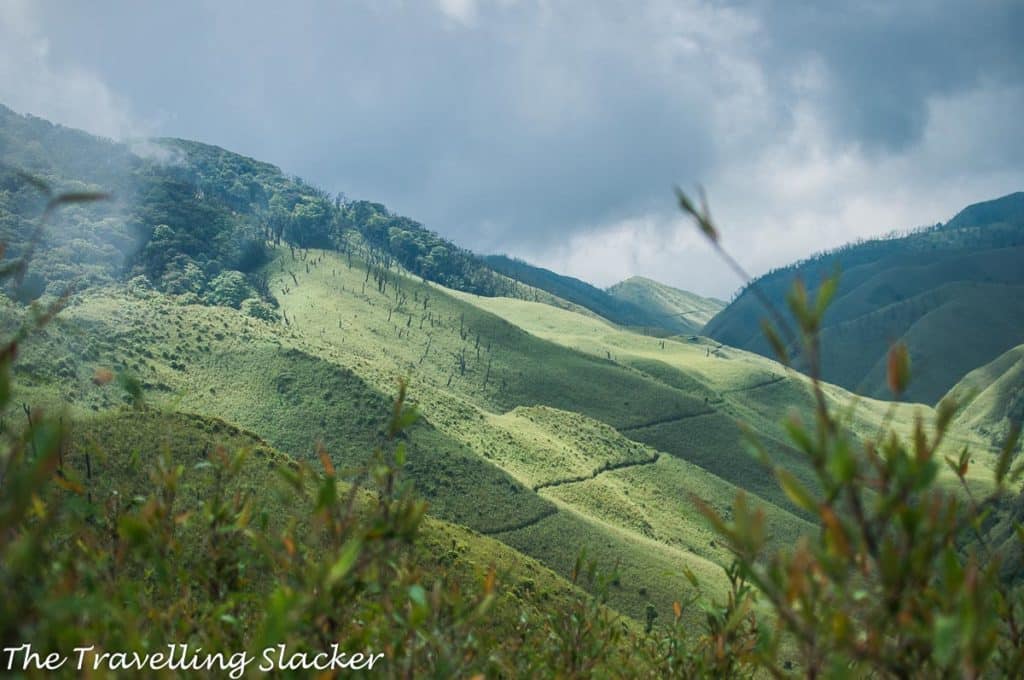
In comparison, this time I hesitated and postponed a few times looking at the weather forecasts. Rain starts as early as April in the North East, so I was prepared with a raincoat and waterproof shoes. But when I finally did it, I got consecutive days of abundant sunshine, and the Dzukou Lily season had started already. Due to my previous experiences, it was hard for me even to imagine an azure sky above those rolling greens, but this I time had that too along with the starry sky at night, although I did not have the right equipment for star trails.
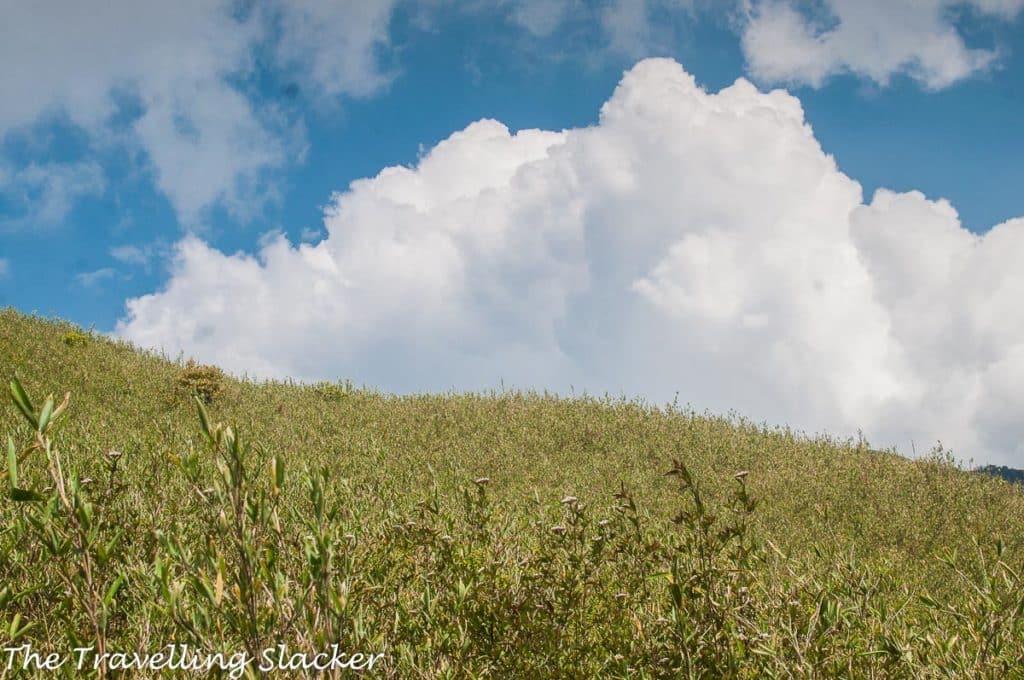
Viswema to Dzukou Ascent: The Usual Route
I did not want any hiccups to start with, so I preferred to take the usual but boring Viswema route. I was willing to spend extra if somebody agreed to drop me at the trekking point from the highway. I left as early as 6.45 AM from my hostel in Kohima skipping the complimentary breakfast with a heavy heart (it was already very bright outside), and reached Viswema by 8.00 AM. Learning from previous experiences, I directly asked the guy at the auto-repair shop out there, and he agreed to provide a car for INR 1500 to drop me at the trekking point. Thankfully another guy had arrived by then and we shared the cost. Do note that while you can hike through this 8-9 KMs of motorable stretch, it eats up around 3 hours and tires you off and considering the mercurial weather and other issues on this trail, these 3 hours can be the difference between a successful and a failed trip.
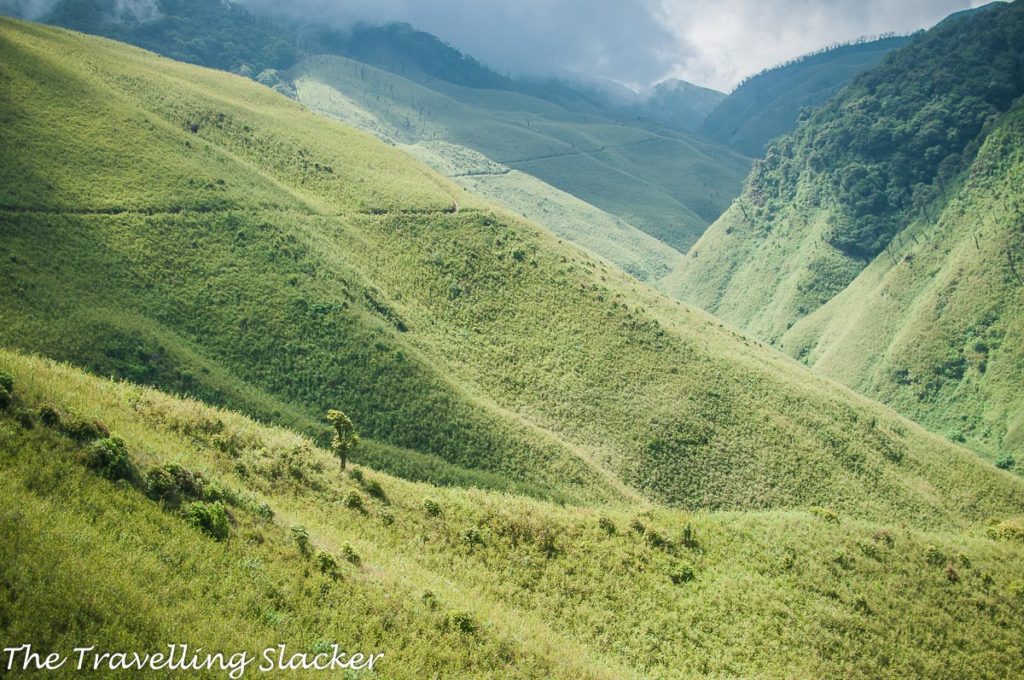
Also, since I had done it before, I had no patience to walk through that road again and wanted to quickly reach the valley, even if by spending a bit extra. So, the car dropped me at the starting point at 9 AM, and I went through the short but steep portion through the jungle in an hour or so. It should have been faster but I realized that a few months of cubicle life in Bangalore followed by a month of rice-siesta-rice routine at home preceding this trip had taken a toll. As I finally neared the end of this steep stretch, the sky seemed gloomy through the jungle. However, as I took the final step, the sunny valley opened up in front of me. The threatening gloom was literally behind me as the thick veil of mist was being driven away by the strong winds coming from the valley.
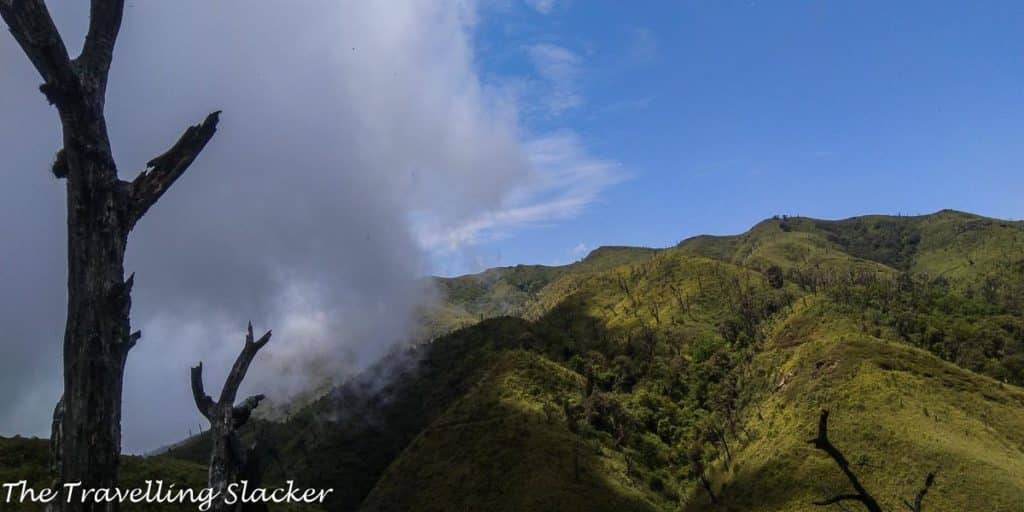
I walked briskly through the rest of the stretch and I was at the Dzukou Guesthouse by 11.15 AM. The caretaker, who also collects the entry fees, wasn’t there (apparently he had gone to a certain spot, from where one can catch the signal and make a phone call). So, I decided to go ahead and enter the actual valley.
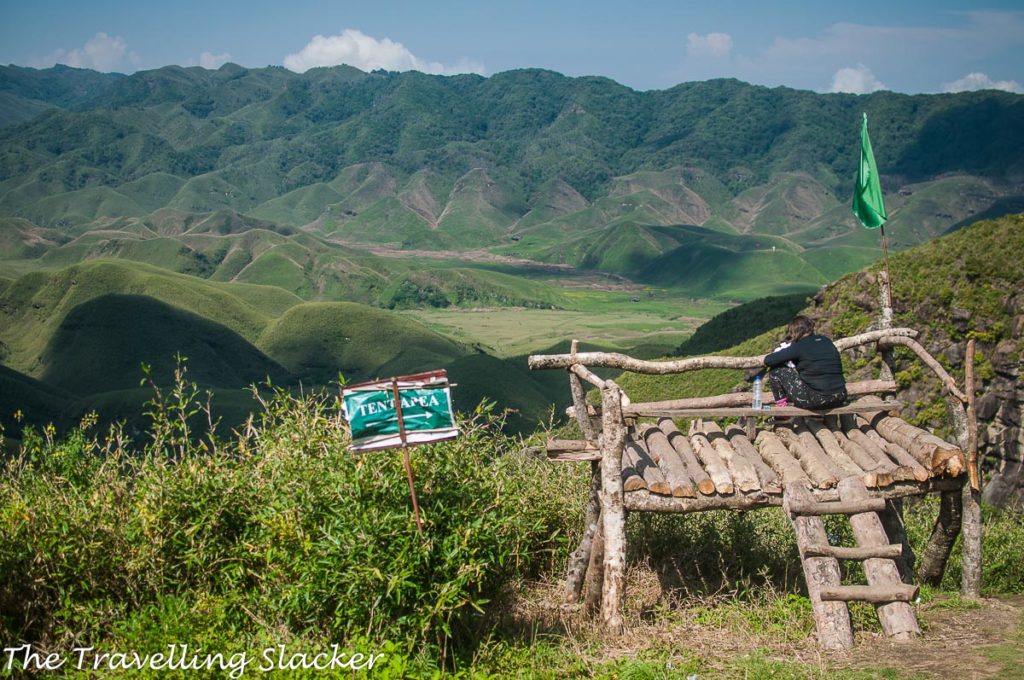
Spotting the Dzukou Lily
The real Dzukou Valley is a couple of KMs hike down from the Guesthouse. Initial stretches involve small descents and ascents through a well-marked trail bypassing the helipad (yes, that is there too, but thankfully only used sparsely for VIPs) and eventually you need to go downhill for 30 mins to reach the open valley, and also the stream (the Dzukou River).
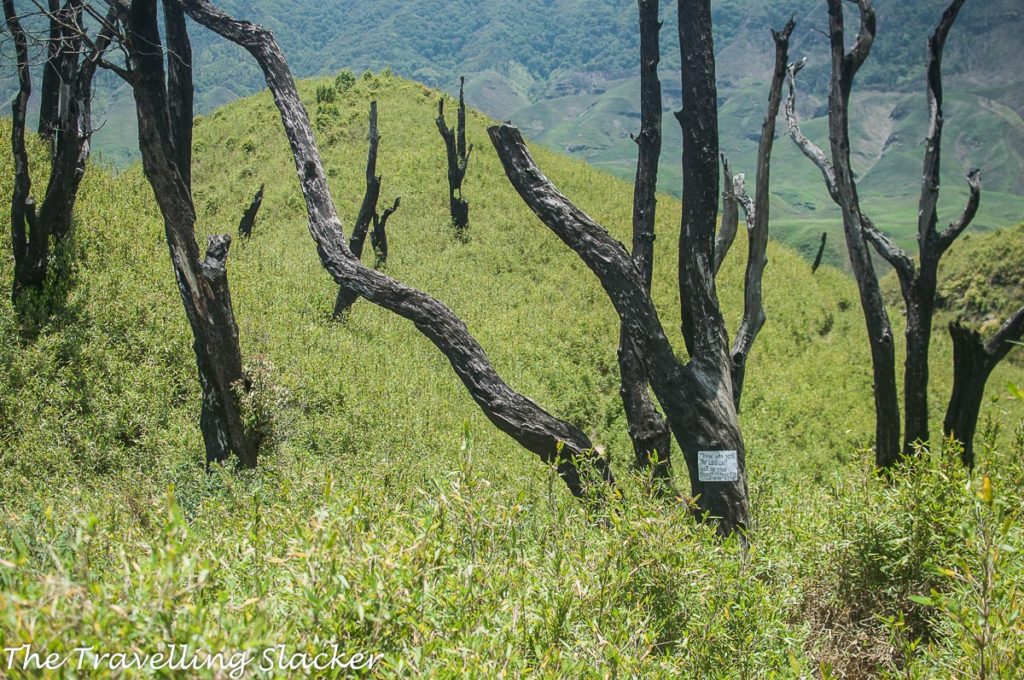
As I have mentioned already, spotting the Dzukou Lily ( Lilium Chitrangadae ) was my primary intention. I had information that it was blooming already but it was not visible near the guesthouse. As I started to hike down towards the valley, I suddenly spotted one hidden inside the bushes. After that, I started seeing them more often as I encountered other visitors coming back from the valley. However, they were too few and far too scattered to provide the spectacle I was hoping for. It took another 15 minutes before I noticed a much thicker concentration on the right side of the trail, and I also noticed pink and yellow patches at a distance. The pink patches were the actual fields of Dzukou Lilies while the yellow ones were a different flower not known to me. Forgive me with the overdose of these floral closeups but I could not decide which one to use and which one to ignore.
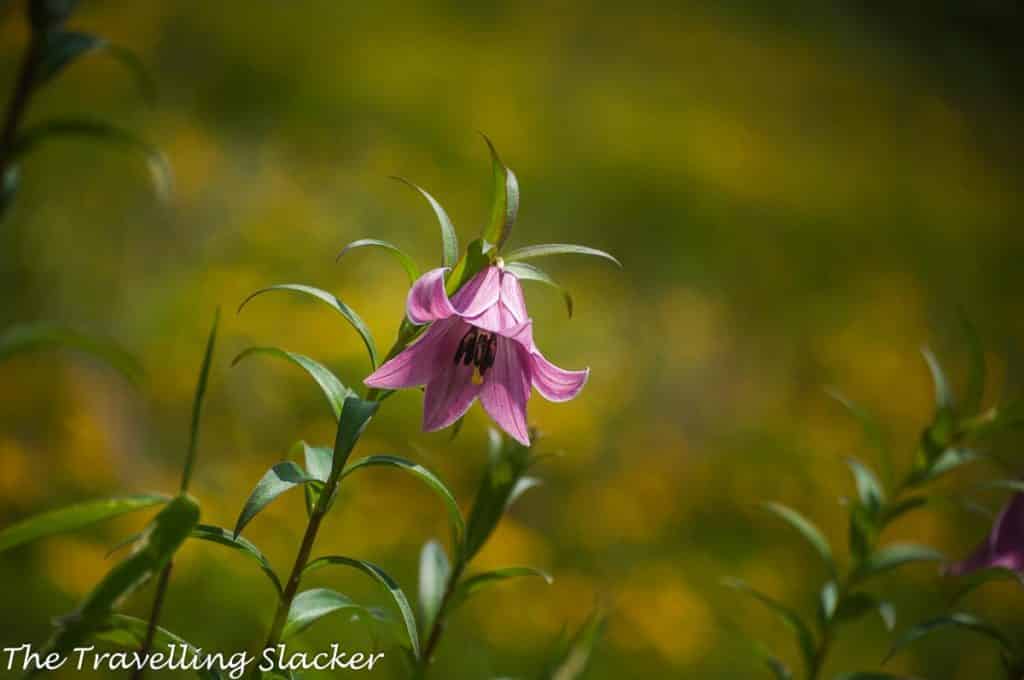
As I reached the flat portion of the valley, I saw one trail going straight and another going towards the right. At first, I took the right one, crossed bridge over a small tributary stream, and reached those aforementioned pink and yellow patches and clicked many photographs. A lot of small birds and insects were visible too, although they were hard to click.
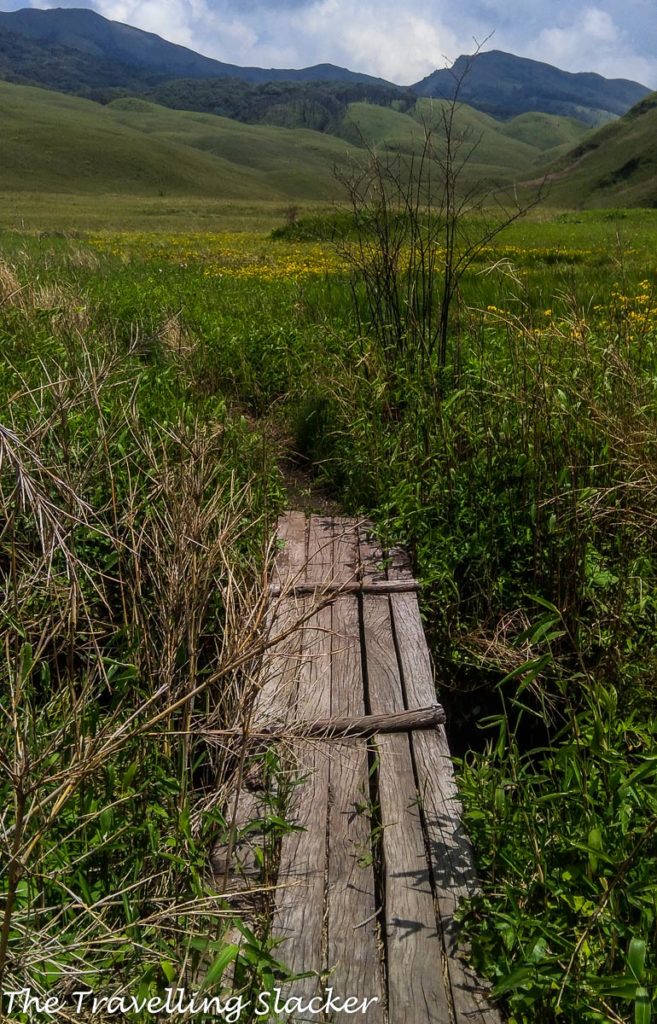
After a while, I turned back and decided to take the straight path, that took me to the largest stream, with only a log as a “bridge”. It was hard to balance but the water was only ankle-deep, so I just walked through the water and reached the other side.
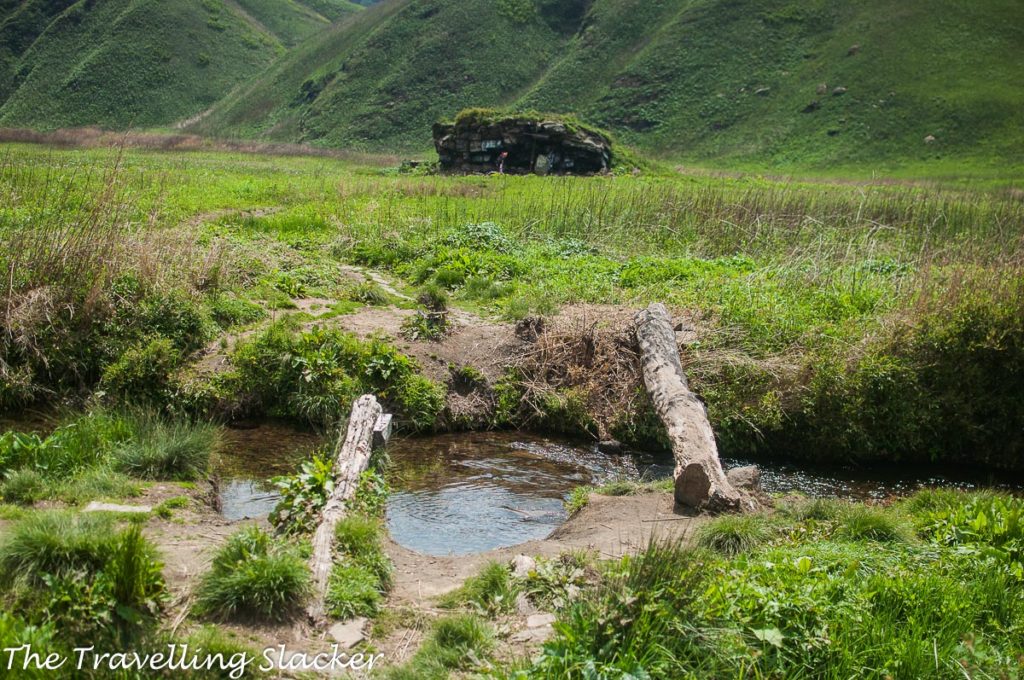
This side was even wider and the stone pathway through the field of lilies was reminding me of the original Valley of Flowers . As a matter of fact, the valley continues even after this point, although I also had to return back to the guest house, so I reluctantly started coming back, which was harder as I had to hike up again after a tiresome day without any proper food and by that time I had run out of water too. I dragged myself while clicking photographs and finally reached the guesthouse and thankfully also found the caretaker and purchased some overpriced noodles from him (as usual, most items in the treks are overpriced due to supply problems).
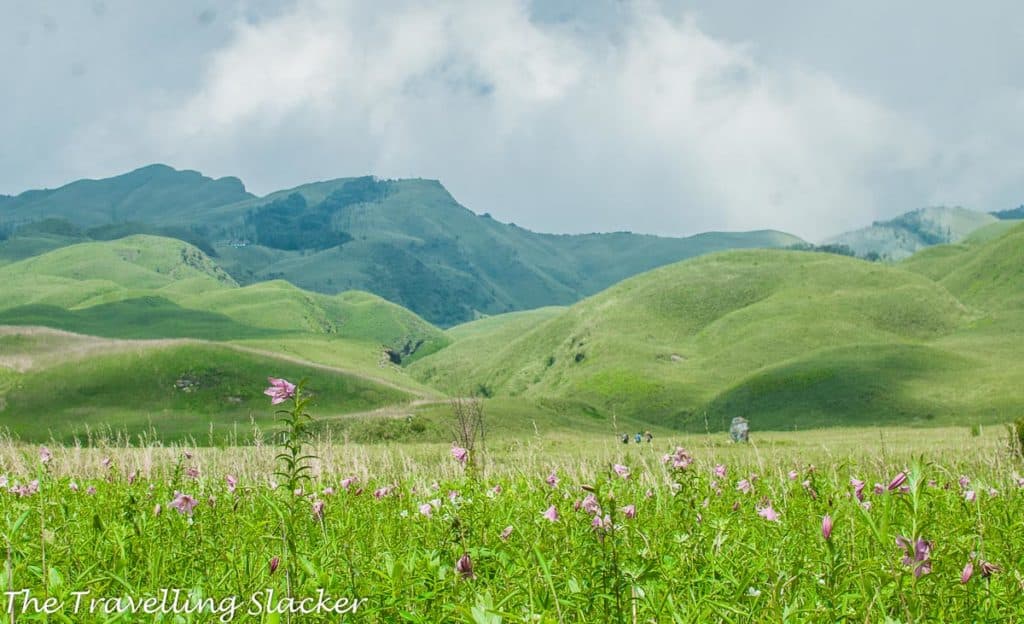
The Night at the Dzukou Tourist Hut
To be honest, I was initially planning to complete the trek and go back to Kohima by the evening. However, I was too tired after exploring the valley and had taken an hour extra than my original plan. I was unlikely to make it to the highway before dark and I was not sure if any transport was going to be available at that time. So, I decided to stay back at the tourist hut (which is nothing but a big empty hall, where people can sleep) although I was grossly unprepared for the cold night. Nevertheless, I’d spent a lonely night without food in the jungle on my first attempt here (a failed one), so it could not have been worse than that.
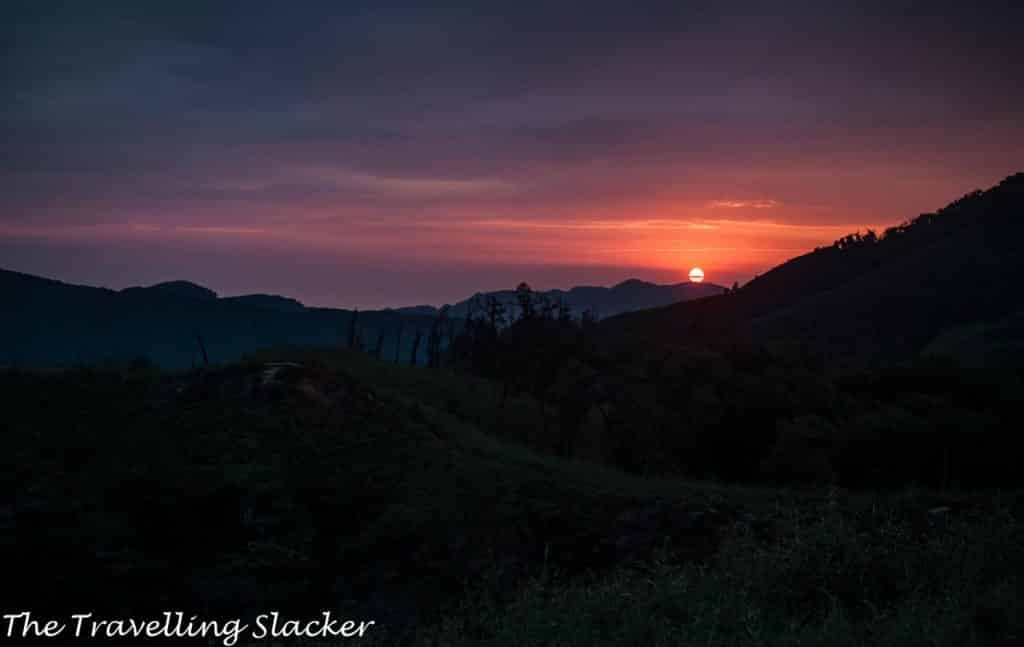
Eventually it turned out to be a good decision as I also got the sunset pics from the valley. A lot of other visitors from various parts of the world had arrived at the guesthouse by then and the conversations around the bonfire was more interesting than what I had experienced of late. It was not exactly a very comfortable night in that dormitory with the mat and blankets provided by the caretaker (no pillows), but after a tiring day, I managed to sleep anyway.
Dzukou to Jakhama: The Alternate Route
The next day, I decided to join a few other guys and come down through the Jakhama or Zakhama Route , something I had not tried on my previous attempts. Initially, after a bit of straight walk, this trail bifurcates, and goes higher up. This ascent was short but tiresome for someone who was already tired but but as it was a bit higher in altitude, I got some interesting frames.
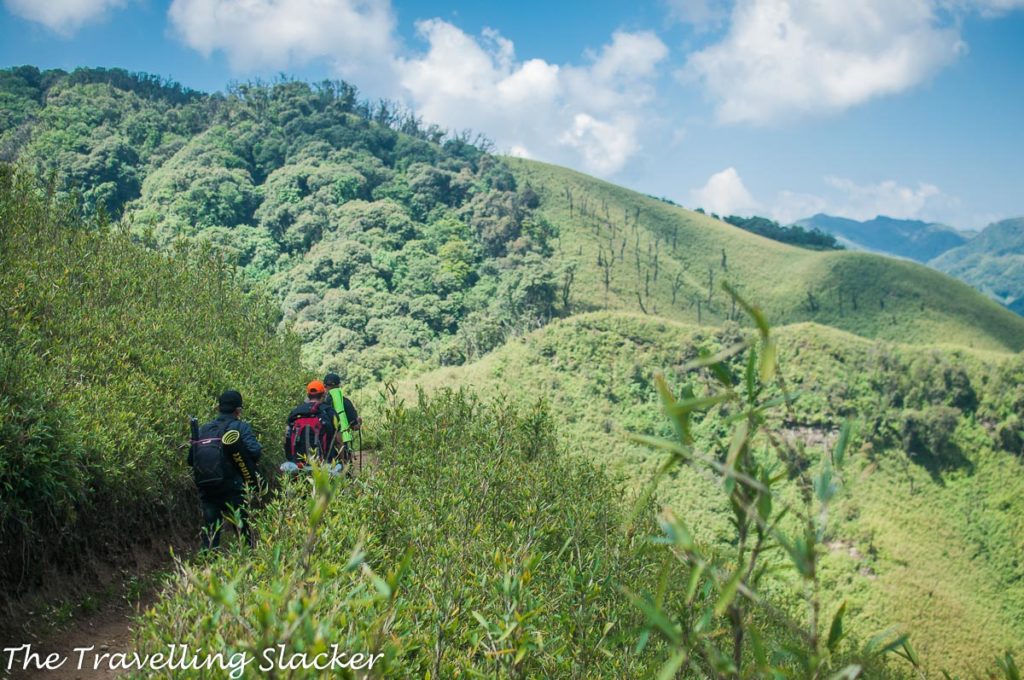
The landscape suddenly changes once you cross over the peak and start the descent. The other side of the hill is is a dense forest, just like the steeper portion of the Viswema route. However, on this route, this portion is much longer. Even going down through this route and reaching the motorable route took around 2 hours, followed by another hour of walk to the highway. I think the ascent through this route will be much harder.
So, with this, I am now familiar with both the routes to Dzukou. Of course, there is 3 rd route from Senapati District (Manipur), but that is not a well marked trail and I have never seen anyone doing it. May be that’s what I’ll try the next time.
PS: Read the old Dzukou Travelogue & Travel Guide for details
- Latest Posts
- Modern-Day Bali Jatra: Your Travel Plans Made Easy - 2024/04/04
- Top 5 tourist destinations in India for an adventure trip - 2024/03/30
- Discover Europe: Unveiling Vacation Packages to its Premier Destinations - 2024/03/29
Related Posts
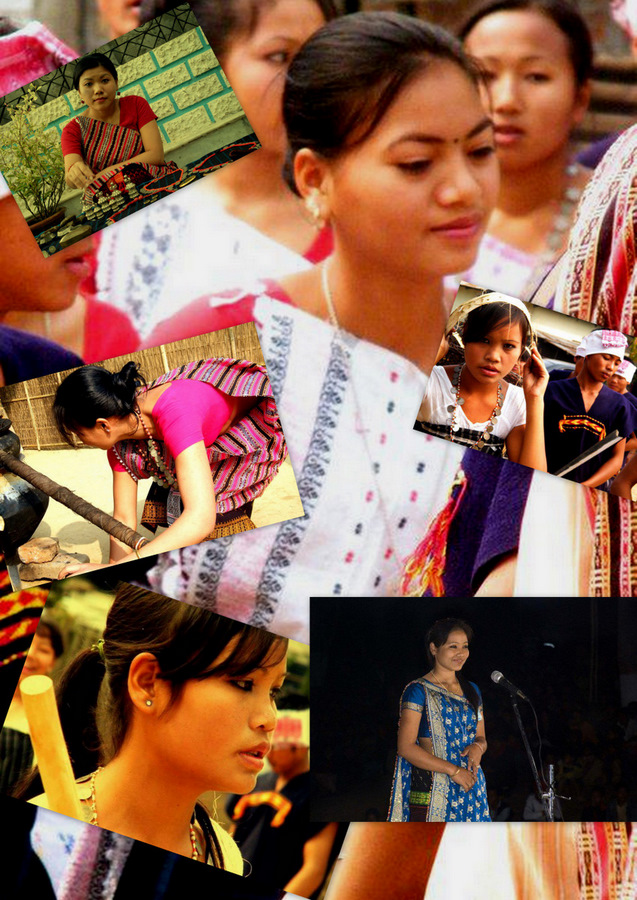
Postcards from Karbi Anglong: 38th Karbi Youth Festival
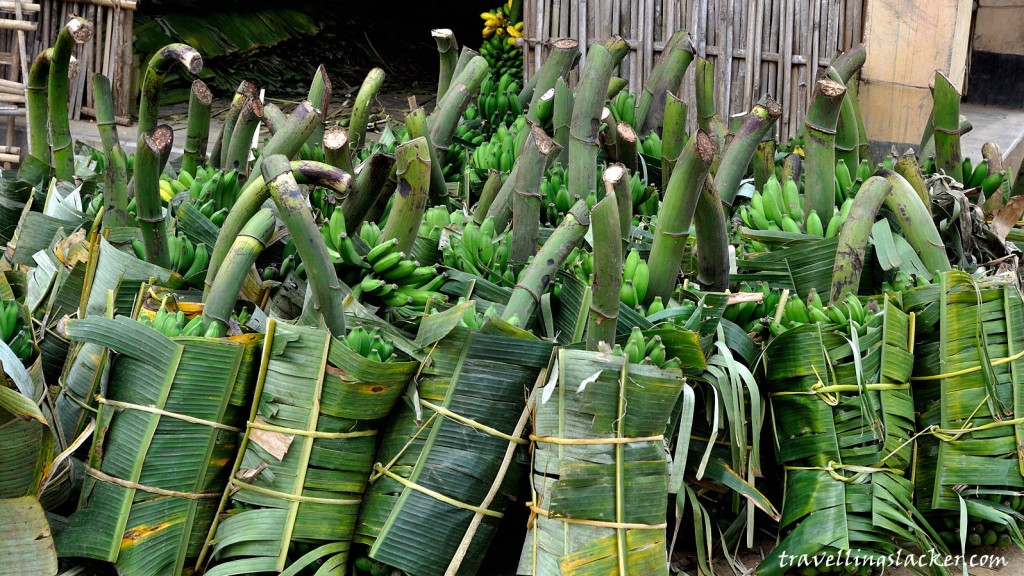
Goalpara Diaries 1: Dudhnoi Market and the Banana Cartel
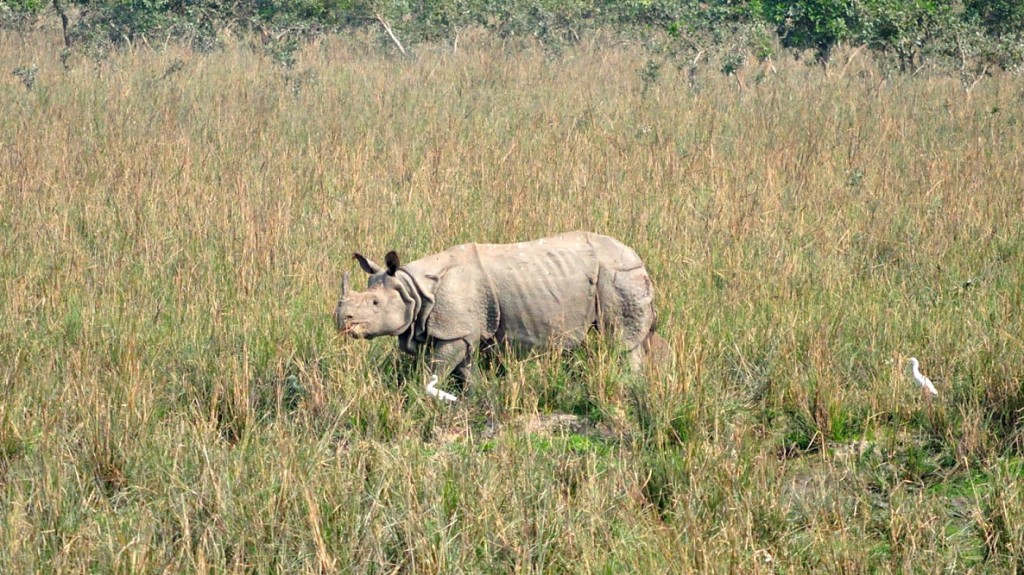
Pobitora: Where Rhinos Dare
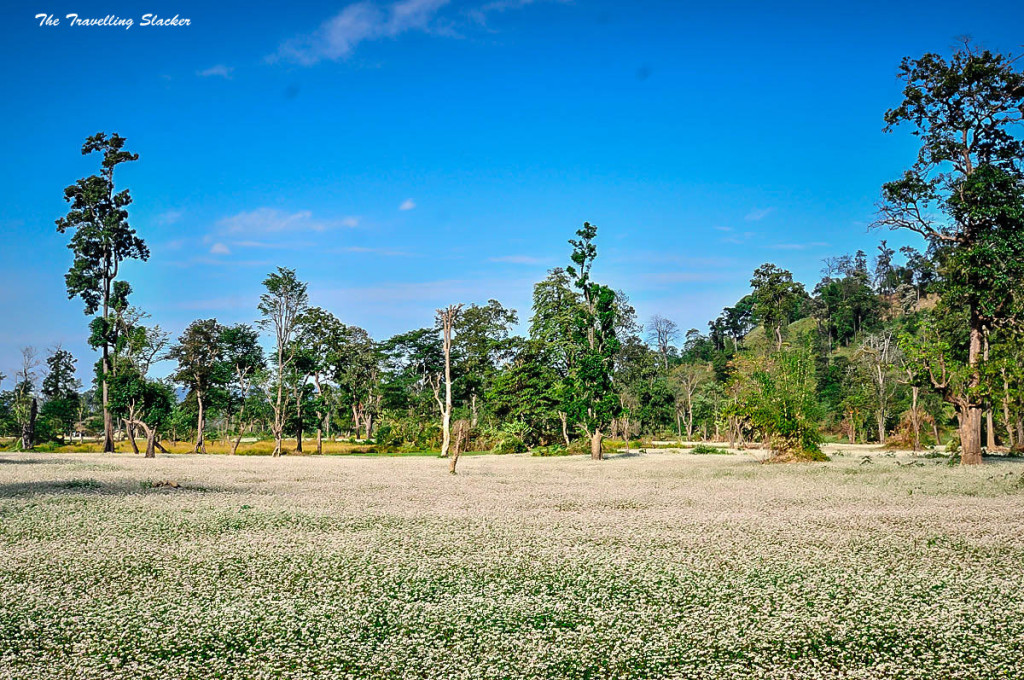
Namdapha: Flora, Flora, Flora!
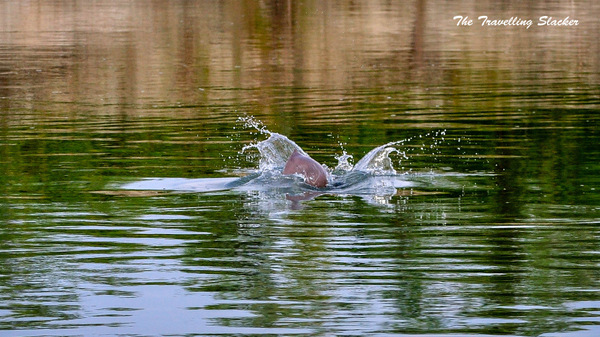
Dibru Saikhowa: Shooting River Dolphins
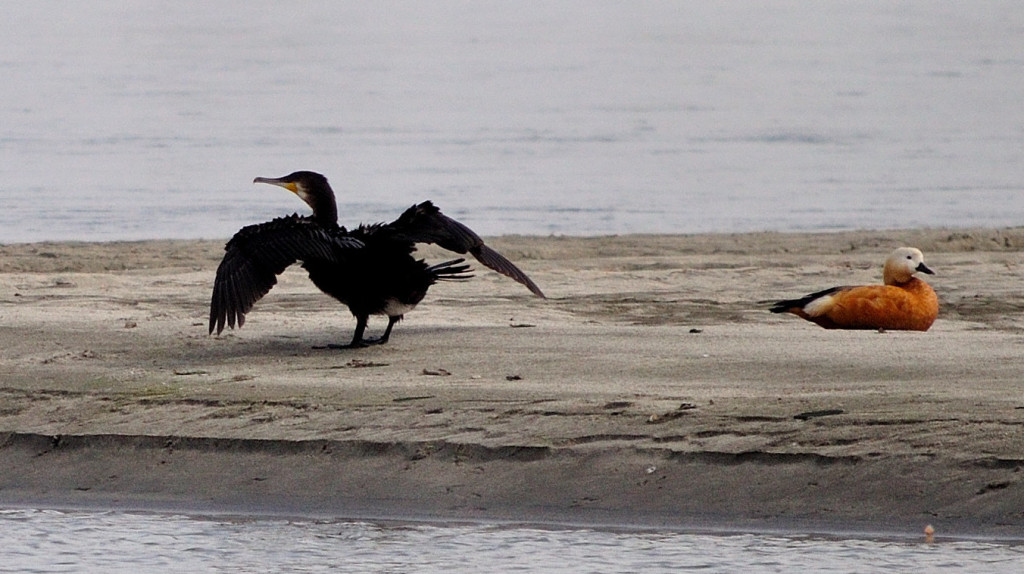
Dibru-Saikhowa National Park: Birds and more Birds
15 thoughts on “dzukou again: lilies of the valley”.
This a gorgeous valley. Missed out last time when I went to Nagaland. Wonderful posts and frames, Jitaditya.
This area of Northeastern India is so lush and green and I love all those wildflowers your are sharing like I’m almost there. Would love to explore this rugged part of India
I love wildflowers. You have discovered a great valley in Dzukou. But I like the yellow ones the most. I wonder what they are called?
These lush scenerie are amazing – would never expect this in India – it Looks rather like mountains in Europe. I’m impressed how varied India is.
That’s the thing about India. It is not limited to Tajmahal & Jaipur.
My husband and I went wildflower hunting here in the Phoenix area in the spring. But we don’t have lilies! I am partial to them as it was my great-grandmother’s name and my middle name. They are so beautiful!
Not too bad if the caretaker isn’t there, a nice money saver on the entry fee 🙂 The views look incredible, they remind me of Switzerland
He came back later on. No savings…
How wonderful to hike somewhere for the beautiful lilies. This hike in Dzukou looks like a lovely day out, but not for unfit people. So glad you were able to stay the night in the tourist hut – despite the lack of pillows!
Your persistence to see Dzukou Lillies was finally rewarded. Glad to read about the happy end. And glad you have shared it with us. Those wildflowers and the Dzukou Valley look like paradise.
What a beautiful trek to find a beautiful flower. i had never heard to the Dzukou lily before now. It looks so fragile and delicate. The whole valley looks stunning and to see a sea of flowers across it would be quite an experience. Glad it worked out on this trip.
Dzukou Valley is such a pretty picturesque valley. We have been planning for so long to visit this place but couldn’t do it till day. Hopefully soon. Your pictures of Lillies are amazing.
Pingback: Dzukou Valley Trek: A Complete Guide & More | The Travelling Slacker
Hey, I am heading to Manipur sometime this summer – do you know if it feasible to do the Dzukou valley trek from Mao (Manipur)? And if it is possible to do it in one day (ie without staying at th guest house) or would you suggest at least two days for it? Thanks
Hi, I have not done that route. The route is there but it is not as frequented as this one and I am not sure how ell marked it is.
Leave a Comment Cancel Reply
Your email address will not be published. Required fields are marked *
Save my name, email, and website in this browser for the next time I comment.
This site uses Akismet to reduce spam. Learn how your comment data is processed .
Top Trending Stories

Download App
Advertisement
Most favourable locations in india for trekking: buran ghati to dzükou valley.
Updated April 1st, 2024 at 22:03 IST
Explore India's favourable trekking spots across India. Places like Great Lakes Trek in Kashmir and Buran Ghati in Himachal Pradesh are a must-visit.
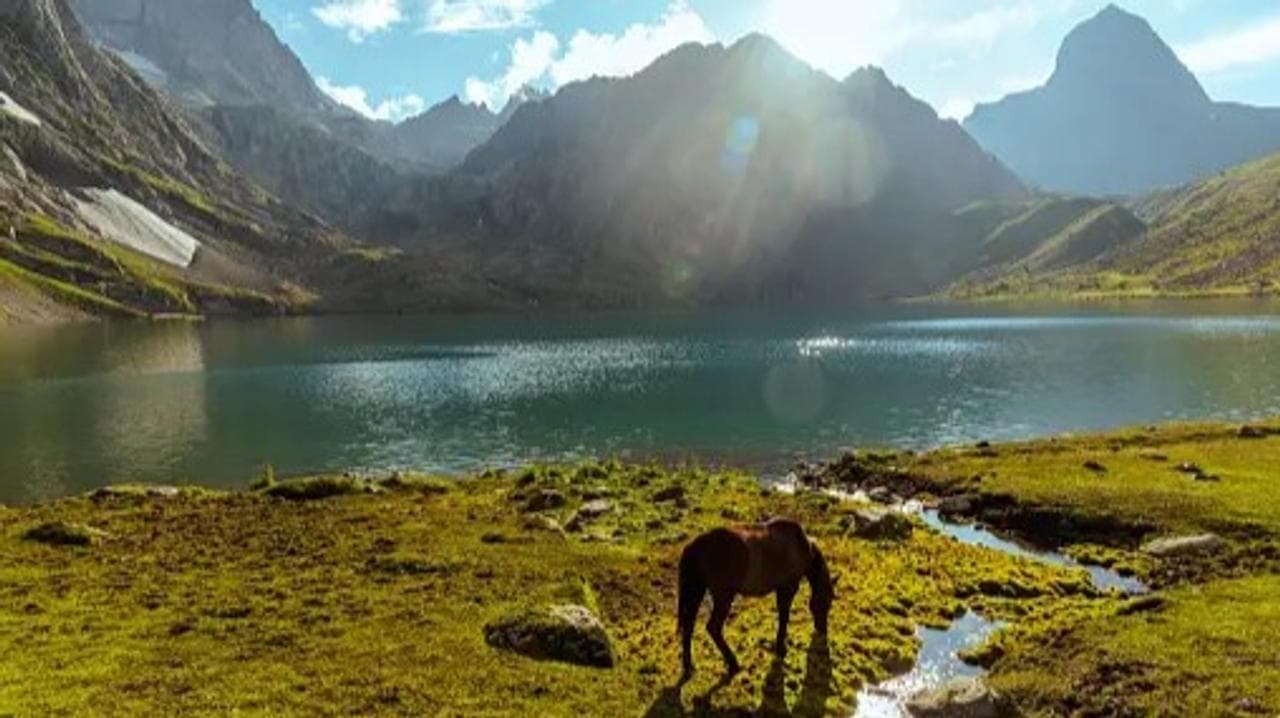
- Listen to this article
India's landscape is as varied as its cultural diversity, offering adventure seekers ample of iconic places to explore from the mighty Himalayan peaks to the lush Western Ghats. For those who crave an active exploration, India presents you some of the most fabulous trekking pathways.
Buran Ghati
Nestled in Himachal Pradesh, the Buran Ghati trek is an accessible adventure starting from the quaint village of Janglik. Just a five-hour drive from Shimla, this trek introduces hikers to a world of diverse natural beauty. From dense forests to expansive meadows and serene glacial lakes like Chandranahan, the journey is visually rewarding. Crossing a high pass at 4,572 meters, trekkers should be well-prepared for altitude adjustments.
Dzükou Valley
Dzükou Valley, situated on the borders of Manipur and Nagaland, every year is known to transform into a spectacular floral haven. Come July, the valley is ablaze with wildflowers, including the unique pink Dzukou Lily found only in this region. There are two main trails, with the entry point from Viswema Village offering a gentler ascent compared to the steeper route from Zakhama Village. Reaching the valley's crest reveals a breathtaking vista at 2,452 meters above sea level, making the trek a must-visit for nature enthusiasts.
Kashmir's Great Lakes Trek
The Great Lakes Trek in Kashmir is a thrilling journey that spans high mountain passes and pristine glacial lakes. Best undertaken from July to September, this trek starts near Sonamarg and winds through vibrant meadows and rugged landscapes, concluding in the village of Naranag. The highlight of the trek is the mesmerizing view of Satsar, Gangabal, and Nundkol lakes, alongside the awe-inspiring Himalayan backdrop. Though the trek is moderate in difficulty, acclimatization in Sonamarg is recommended to tackle the elevations reaching up to 4,200 meters.
This South Asian nation's trekking routes promise unforgettable adventures that brings you high of overcoming challenges on the path, wile witnessing the unperturbed beauty of this land.
Published April 1st, 2024 at 22:03 IST
Your Voice. Now Direct.
Send us your views, we’ll publish them. This section is moderated.
Recommended
5.3 Magnitude Earthquake Hits Chamba in Himachal Pradesh

17 Indians Lured Into Unsafe Work in Laos on Way Back Home

Bengaluru: Two Students Out Of 47 Hospitalised Test Positive For Cholera

AI Scam: Man Posing As Cop Dupes Woman Of Rs 1 Lakh In Mumbai

Shameful That Cong Asking 'Kashmir Se Kya Waasta Hai:' Shah Slams Kharge

Trending Quicks
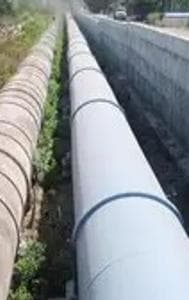
Bengaluru Water Crisis

WWE WrestleMania live
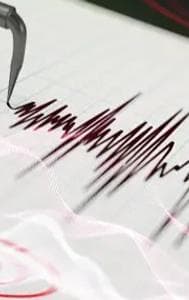
Earthquake in Kargil

EC Reminds Newspapers

Kohli's 100 goes in vain
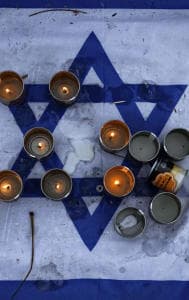
Israel Prez Statement

Chandrababu Naidu

BJP candidate Locket
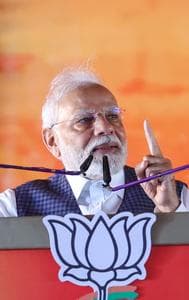
Lok Sabha Elections 2024
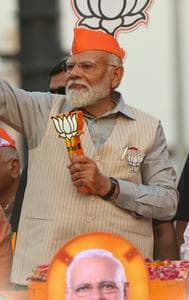
Modi Roadshow In Jabalpur

Reaction on Kohli
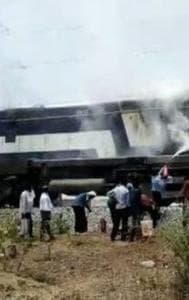
Pune Goods Train
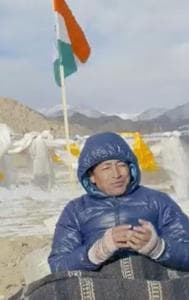
Pashmina March Cancelled

Viktor Orbán Protest
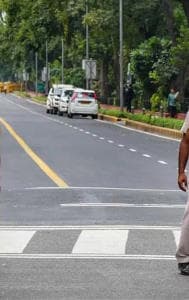
School Student Tortured

Kohli's ton goes in vain
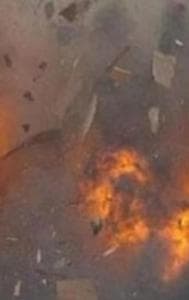
Cylinder Bomb

Mohammedan win league
Republic top 5.
Rajasthan Man Kills Teen Daughter For Not Studying
Lawyers Commenting On Pending Cases, Judgments Is Disturbing Trend: CJI
Is There a Mumbai Mega Block This Sunday? Local Train Timings For Apr 7
Why PM Modi Said Muslim Women Will Continue to Bless Him For Centuries
BREAKING: Fire Breaks Out at NTPC's Kanhia Power Plant in Talcher
Find a bike shop near you | Trek Retailers
2018 Primetime Emmy & James Beard Award Winner
R&K Insider
Join our newsletter to get exclusives on where our correspondents travel, what they eat, where they stay. Free to sign up.
A History of Moscow in 13 Dishes
Featured city guides.

IMAGES
VIDEO
COMMENTS
Standing at ~8000 ft (2438 mts), Dzukou valley is situated beside the Japfu peak on the border between Nagaland and Manipur. However, being close to Kohima, the state capital of Nagaland, more tourists trek the valley from Nagaland side rather than Manipur side. Dzukou Valley is an absolute delight, a treat to the eyes and soul.
The Dzukou valley trek is a unique opportunity to explore the untouched valleys of Nagaland along with getting immersed in their culture. With spectacular green valley views, this trek is the best for any beginner looking to enter the world of trekking. Best Season: Best season to do the trek is in the winter season when the weather is pleasant
A detailed guide to the Dzukou Valley and Japfu Peak Trek, a scenic and challenging trekking route in Nagaland. Learn about the trail information, highlights, highlights, and tips for this trek that offers emerald green hills, forests, streams, and colorful blooms.
Dzükou Valley Trek Duration: The minimum time to reach the Dzukou Valley Guest House — which is the end point of the trek — is about 4-to-5 hours from both villages. The Dzukou Valley Trek distance distance via Viswema is approximately 13 kilometers (8 miles) and 10 kilometers (6 miles) via the Jakhama trail.
The Dzukou valley is Nagaland's most famous and spellbinding trekking destination. This is a comprehensive guide covering every aspect of visiting the Dzukou valley. Click through to learn the ecology of the valley, the best time to visit to see wildflowers, how to trek to the valley, where to stay once you arrive, what camping gear you need to bring, how to find firewood, things to do in the ...
Learn how to do Dzukou Valley trek by yourself, a less explored gem in North-East India on the border of Manipur and Nagaland. Find out the best time, duration, route, cost, accommodation and safety tips for this independent traveler's guide.
Dzukou Valley Trek: Failed Attempt (September 2017): A Night at the Jungle Hut. As my regular readers know, I started this blog with a trek to the Valley of Flowers in Uttarakhand in 2010. Since then, I have had a fascination of such areas, desolated high altitude valleys, that can be reached only after a trek. I have known about Dzukou since ...
Towards Dzukou Valley - Start your trek. Start early on the day you intend to ascend to Dzukou Valley. As said earlier, there are two routes to make it to Dzukou Valley. But the Viswema route is preferred more as it is considered easier to ascend through this route. Hence, this blog will put out the details of starting the trek from Viswema.
The Dzukou Valley Trek is in fact a short expedition for 2-3 days only, but still there is plenty of adventure in this trek. After reaching the ultimate destination, the breathtaking views of Dzukou Valley are unmatched and unparalleled. It is also possible to add a few more days in the trip itinerary to properly cover the nearby Jafpu peak.
A signboard at Dzukou says, "Well, if you find it hard to go to Dzukou, you may find it hard to go to heaven." Dzukou Valley, which borders Nagaland and Manipur, is touted to be one of the best trekking spots in North-Eastern India. This testing trek adventure will be worthwhile for all avid trekkers, adventure seekers, and photography enthusiasts. During Summer, its rolling green ...
The Dzukou Lily was first identified in 1991 by Late Dr. Hijam Bikramjit, Life Sciences Department, Manipur University on his trek to Dzukou Valley with Manipur Cultural Integration Conference Team. Apart from the endemic variety of lily, many other flowers like Euphorbia sikkimensis , Ranunculus species, Aconitum species etc. adorn the valley ...
Dzukou Valley Trek (Kohima, Nagaland) Dzukou Valley is a valley located at the border of the Indian states of Nagaland and Manipur. Its a spectacular visual treat of emerald green hills, lush forests, serpentine streams and myriad colourful flowers that dot the vast plain valley and its meadows. It is popularly known as "Valley of Flowers of ...
Introduction to Dzukou Valley Trek; History and Geography of Dzukou Valley; Location of Dzukou Valley: How to get it. Dzukou Valley by Train; Dzukou Valley by Air; From Dimapur to Kohima; Biodiversity of Dzukou Valley; Dzukou Valley Trek. From Kohima to Via Zakhama Trek. Day-1; Day-2; From Kohima to Via Vishwema Trek. Day-1; Day-2; Instructions ...
Dzukou Valley is the crater base of an extinct volcano with the best panoramic view at its highest point of 2600 meters. The sunrise and sunset views at this point are undeniably once-in-a-lifetime experiences. Our Dzukou Valley Trek Package includes a 4N/5D tour program with visits to the Viswema and Zakhma villages.
Dzukou valley, is an easy level trek near Kisama and Kohima, the venue for annual Hornbill Festival of Nagaland. Dzukou valley is known for the unusual shapes of its verdant hills, surreal sunsets and the rare Dzukou valley lily. Located near Kohima and Kisama, people can trek to Dzukou valley from both Nagaland and the neighbouring North East ...
The Dzukou Valley, on the boundary between Nagaland and Manipur, is a gorgeous spot with rolling slopes, flowing streams, and tangled wild growths all having unique beauty. Northeast India is adorned with this significant feature. Dzukou Valley, times known as Dzükou Valley, is 2,452 meters above sea level.
Experience the magic of Nagaland with the Dzukou Valley Trek, a thrilling adventure that takes you to the stunning valley of flowers. Book now and get 20% off on this unforgettable trip with Thrillophilia, the best online platform for travel enthusiasts.
Usual views at the top Spotting the Dzukou Lily. The real Dzukou Valley is a couple of KMs hike down from the Guesthouse. Initial stretches involve small descents and ascents through a well-marked trail bypassing the helipad (yes, that is there too, but thankfully only used sparsely for VIPs) and eventually you need to go downhill for 30 mins to reach the open valley, and also the stream (the ...
Reaching the valley's crest reveals a breathtaking vista at 2,452 meters above sea level, making the trek a must-visit for nature enthusiasts.Image credit: UnsplashKashmir's Great Lakes Trek The Great Lakes Trek in Kashmir is a thrilling journey that spans high mountain passes and pristine glacial lakes.
Showing 12 of 39 results. Back. ⌖ Use My Location. Store Locator by Locally.
110 likes, 0 comments - northeast_bagpack_travels on January 31, 2024: "Successful dzukou valley Trek February 28th - 30th 2024. Thank you For Joining with us ...
Welcome to the official YouTube channel of the Moscow City Symphony - Russian Philharmonic! https://orchestra.ru
Walking tour around Moscow-City.Thanks for watching!MY GEAR THAT I USEMinimalist Handheld SetupiPhone 11 128GB https://amzn.to/3zfqbboMic for Street https://...
This tour of Moscow's center takes you from one of Moscow's oldest streets to its newest park through both real and fictional history, hitting the Kremlin, some illustrious shopping centers, architectural curiosities, and some of the city's finest snacks. Start on the Arbat, Moscow's mile-long pedestrianized shopping and eating artery ...